Table of Contents
- Compliance Statements
- About This Manual
- Package Contents
- Product Information
- User Information
- Contents
- Chapter 1 Introduction
- Chapter 2 Hardware Setup
- Chapter 3 Basic Operation
- Chapter 4 OSD Operation
- Chapter 5 Hotkey Operation
- Hotkey Port Control
- Invoking Hotkey Mode
- Selecting the Active Port
- Auto Scan Mode Switching
- Skip Mode Switching
- Computer Keyboard / Mouse Reset
- Setting the Hotkey Beeper ON/OFF
- Setting the Hotkey key combination
- Setting the OSD Hotkey combination
- Setting the Port Operating System
- Restore the Default Values
- Hotkey Summary Table
- Chapter 6 Keyboard Emulation
- Chapter 7 Logging In
- Chapter 8 The User Interface
- Chapter 9 Port Access
- Chapter 10 User Management
- Chapter 11 Device Management
- Chapter 12 Log
- Chapter 13 Maintenance
- Chapter 14 Download
- Chapter 15 Port Operation
- Chapter 16 The Log Server
- Appendix
ATEN KL1516AIN-AXA-XG User Manual
Displayed below is the user manual for KL1516AIN-AXA-XG by ATEN which is a product in the KVM Switches category. This manual has pages.
Related Manuals

ATEN Altusen™
KL1508Ai / KL1516Ai
Dual Rail LCD KVM Switch
Full HD Version
User Manual

KL1508Ai / KL1516Ai User Manual
ii
Compliance Statements
FEDERAL COMMUNICATIONS COMMISSION INTERFERENCE
STATEMENT
This equipment has been tested and found to comply with the limits for a Class
A digital device, pursuant to Part 15 of the FCC Rules. These limits are
designed to provide reasonable protection against harmful interference when
the equipment is operated in a commercial environment. This equipment
generates, uses, and can radiate radio frequency energy and, if not installed and
used in accordance with the instruction manual, may cause harmful
interference to radio communications. Operation of this equipment in a
residential area is likely to cause harmful interference in which case the user
will be required to correct the interference at his own expense.
The device complies with Part 15 of the FCC Rules. Operation is subject to the
following two conditions: (1) this device may not cause harmful interference,
and (2) this device must accept any interference received, including
interference that may cause undesired operation.
FCC Caution
Any changes or modifications not expressly approved by the party responsible
for compliance could void the user's authority to operate this equipment.
Warning
Operation of this equipment in a residential environment could cause radio
interference.
Suggestion
Shielded twisted pair (STP) cables must be used with the unit to ensure
compliance with FCC & CE standards.
Achtung
Der Gebrauch dieses Geräts in Wohnumgebung kann Funkstörungen
verursachen.
KCC Statement

KL1508Ai / KL1516Ai User Manual
iii
Industry Canada Statement
This Class A digital apparatus complies with Canadian ICES-003.
RoHS
This product is RoHS compliant.

KL1508Ai / KL1516Ai User Manual
iv
About This Manual
This User Manual is provided to help you get the most from your KL1508Ai /
KL1516Ai system. It covers all aspects of installation, configuration and
operation. An overview of the information found in the manual is provided
below.
Chapter 1, Introduction, introduces you to the KL1508Ai / KL1516Ai
System. Its purpose, features and benefits are presented, and its front and back
panel components are described.
Chapter 2, Hardware Setup, provides step-by-step instructions for setting
up your installation, and explains some basic operating procedures.
Chapter 3, Basic Operation, explains the fundamental concepts involved
in operating the KL1508Ai / KL1516Ai.
Chapter 4, OSD Operation, provides a complete description of the
KL1508Ai / KL1516Ai's OSD (On Screen Display), and how to work with it.
Chapter 5, Hotkey Operation, details all of the concepts and procedures
involved in the keyboard hotkey operation of your KL1508Ai / KL1516Ai
installation.
Chapter 6, Keyboard Emulation, provides tables that list the PC to Mac
and PC to Sun keyboard emulation mappings.
Chapter 7, Logging In, describes how to log into the KL1508Ai /
KL1516Ai via its Graphical User Interface (GUI) with each of the available
access methods: from the local console; an internet browser; a standalone
Windows application (AP) program; and a standalone Java application (AP)
program.
Chapter 8, The User Interface, describes the layout and explains the
components of the KL1508Ai / KL1516Ai’s user interface.
Chapter 9, Port Access, describes the Port Access page and how to use it
to configure the options it provides regarding port manipulation.
Chapter 10, User Management, shows administrators how to create,
modify, and delete users, and assign attributes to them.
Chapter 11, Device Management, shows administrators how to configure
and control overall KL1508Ai / KL1516Ai operations.
Chapter 12, Log, shows how to use the log file utility to view all the events
that take place on the KL1508Ai / KL1516Ai.

KL1508Ai / KL1516Ai User Manual
v
Chapter 13, Maintenance, explains how to upgrade the KL1508Ai /
KL1516Ai’s firmware, as well as the firmware of the KVM Adapter Cables
used to connect its ports to the installed devices.
Chapter 14, Download, describes how to download standalone AP
versions of the Win Client, the Java Client, the Log Server, and Power Over the
Net (PoN) programs.
Chapter 15, Port Operation, provides detailed information on accessing
and operating the devices connected to the KL1508Ai / KL1516Ai’s ports.
Chapter 16, The Log Server, explains how to install and configure the
Log Server.
An Appendix at the end of the manual provides technical and
troubleshooting information.
Conventions
This manual uses the following conventions:
Monospaced Indicates text that you should key in.
[ ]
Indicates keys you should press. For example, [Enter] means
to press the Enter key. If keys need to be chorded, they
appear together in the same bracket with a plus sign
between them: [Ctrl+Alt].
1.
Numbered lists represent procedures with sequential steps.
♦
Bullet lists provide information, but do not involve sequential
steps.
>
Indicates selecting the option (on a menu or dialog box, for
example), that comes next. For example, Start
>
Run means
to open the Start menu, and then select Run.
Indicates critical information.

KL1508Ai / KL1516Ai User Manual
vi
Package Contents
Basic Package
The basic KL1508Ai / KL1516Ai package consists of:
1 KL1508Ai or KL1516Ai Dual Rail LCD KVM Switch
1 power cord
1 standard rack mount kit
1 firmware upgrade cable
1 user instructions*
Check to make sure that all of the components are present and in good order.
If anything is missing, or was damaged in shipping, contact your dealer.
Read this manual thoroughly and follow the installation and operation
procedures carefully to prevent any damage to the switch or to any other
devices on the KL1508Ai / KL1516Ai installation.
*Changes may have been made to the manual since it was published. Please
visit our Website to check for the most up-to-date version.

KL1508Ai / KL1516Ai User Manual
vii
Product Information
For information about all ATEN products and how they can help you connect
without limits, visit ATEN on the Web or contact an ATEN Authorized
Reseller. Visit ATEN on the Web for a list of locations and telephone numbers:
User Information
Online Registration
Be sure to register your product at our online support center:
Telephone Support
For telephone support, call this number:
International http://www.aten.com
North America http://www.aten-usa.com
International http://eservice.aten.com
International 886-2-8692-6959
China 86-400-810-0-810
Japan 81-3-5615-5811
Korea 82-2-467-6789
North America 1-888-999-ATEN ext 4988
1-949-428-1111

KL1508Ai / KL1516Ai User Manual
viii
User Notice
All information, documentation, and specifications contained in this manual
are subject to change without prior notification by the manufacturer. The
manufacturer makes no representations or warranties, either expressed or
implied, with respect to the contents hereof and specifically disclaims any
warranties as to merchantability or fitness for any particular purpose. Any of
the manufacturer's software described in this manual is sold or licensed `as is'.
Should the programs prove defective following their purchase, the buyer (and
not the manufacturer, its distributor, or its dealer), assumes the entire cost of all
necessary servicing, repair and any incidental or consequential damages
resulting from any defect in the software.
The manufacturer of this system is not responsible for any radio and/or TV
interference caused by unauthorized modifications to this device. It is the
responsibility of the user to correct such interference.
The manufacturer is not responsible for any damage incurred in the operation
of this system if the correct operational voltage setting was not selected prior
to operation. PLEASE VERIFY THAT THE VOLTAGE SETTING IS
CORRECT BEFORE USE.
A typical LCD (Liquid Crystal Display) monitor has millions of pixels. A dead
pixel refers to a pixel with a defect in its ability to display the correct color
output. It most often looks like a tiny black or white spot on your screen,
although it can be any other color. Since even a tiny dust particle on one of the
pixels during the manufacturing process or a slight bump during shipping can
create a dead pixel, the ISO 13406-2 norm defines 4 classes of acceptable
screens with dead pixels--Class 1 is the best; Class 4 is the worst. Almost all
manufacturers use Class 2 to establish their warranties, which allows a certain
amount of dead pixels to exist before they will replace the screen. Since the
manufacturers consider these screens to be acceptable under ISO
specifications, we cannot be responsible for replacement or warranty of the
TFT LCD panel.

KL1508Ai / KL1516Ai User Manual
ix
Contents
Compliance Statements . . . . . . . . . . . . . . . . . . . . . . . . . . . . . . . . . . . . . . . ii
About This Manual . . . . . . . . . . . . . . . . . . . . . . . . . . . . . . . . . . . . . . . . . . iv
Conventions . . . . . . . . . . . . . . . . . . . . . . . . . . . . . . . . . . . . . . . . . . . . . v
Package Contents. . . . . . . . . . . . . . . . . . . . . . . . . . . . . . . . . . . . . . . . . . . vi
Basic Package. . . . . . . . . . . . . . . . . . . . . . . . . . . . . . . . . . . . . . . . . . . vi
Product Information. . . . . . . . . . . . . . . . . . . . . . . . . . . . . . . . . . . . . . . . . . vii
User Information . . . . . . . . . . . . . . . . . . . . . . . . . . . . . . . . . . . . . . . . . . . . vii
Online Registration . . . . . . . . . . . . . . . . . . . . . . . . . . . . . . . . . . . . . . . vii
Telephone Support . . . . . . . . . . . . . . . . . . . . . . . . . . . . . . . . . . . . . . . vii
User Notice . . . . . . . . . . . . . . . . . . . . . . . . . . . . . . . . . . . . . . . . . . . . .viii
Contents . . . . . . . . . . . . . . . . . . . . . . . . . . . . . . . . . . . . . . . . . . . . . . . . . . ix
Chapter 1.
Introduction
Overview . . . . . . . . . . . . . . . . . . . . . . . . . . . . . . . . . . . . . . . . . . . . . . . . . . . 1
Features . . . . . . . . . . . . . . . . . . . . . . . . . . . . . . . . . . . . . . . . . . . . . . . . . . . 4
Hardware. . . . . . . . . . . . . . . . . . . . . . . . . . . . . . . . . . . . . . . . . . . . . . . . 4
Management . . . . . . . . . . . . . . . . . . . . . . . . . . . . . . . . . . . . . . . . . . . . . 5
Easy-to-Use Interface . . . . . . . . . . . . . . . . . . . . . . . . . . . . . . . . . . . . . .5
Advanced Security . . . . . . . . . . . . . . . . . . . . . . . . . . . . . . . . . . . . . . . . 6
Virtual Remote Desktop . . . . . . . . . . . . . . . . . . . . . . . . . . . . . . . . . . . . 6
Requirements . . . . . . . . . . . . . . . . . . . . . . . . . . . . . . . . . . . . . . . . . . . . . . . 7
General . . . . . . . . . . . . . . . . . . . . . . . . . . . . . . . . . . . . . . . . . . . . . . . . . 7
External Console . . . . . . . . . . . . . . . . . . . . . . . . . . . . . . . . . . . . . . . . . . 7
Computers. . . . . . . . . . . . . . . . . . . . . . . . . . . . . . . . . . . . . . . . . . . . . . . 7
KVM Adapter Cables. . . . . . . . . . . . . . . . . . . . . . . . . . . . . . . . . . . . . . . 7
Adapter Cable Resolutions . . . . . . . . . . . . . . . . . . . . . . . . . . . . . . . . . . 8
Operating Systems . . . . . . . . . . . . . . . . . . . . . . . . . . . . . . . . . . . . . . . . 9
Components . . . . . . . . . . . . . . . . . . . . . . . . . . . . . . . . . . . . . . . . . . . . . . .10
Front View . . . . . . . . . . . . . . . . . . . . . . . . . . . . . . . . . . . . . . . . . . . . . . 10
Keyboard Module . . . . . . . . . . . . . . . . . . . . . . . . . . . . . . . . . . . . . . . . 11
LCD Module . . . . . . . . . . . . . . . . . . . . . . . . . . . . . . . . . . . . . . . . . . . .12
Rear View . . . . . . . . . . . . . . . . . . . . . . . . . . . . . . . . . . . . . . . . . . . . . . 13
Chapter 2.
Hardware Setup
Before You Begin . . . . . . . . . . . . . . . . . . . . . . . . . . . . . . . . . . . . . . . . . . . 15
Standard Rack Mounting. . . . . . . . . . . . . . . . . . . . . . . . . . . . . . . . . . . . . . 16
Front-L Brackets Mounting . . . . . . . . . . . . . . . . . . . . . . . . . . . . . . . . . . . . 18
Optional Rack Mount Kits . . . . . . . . . . . . . . . . . . . . . . . . . . . . . . . . . . . . . 20
Single Stage Installation . . . . . . . . . . . . . . . . . . . . . . . . . . . . . . . . . . . . . . 21
Daisy Chaining . . . . . . . . . . . . . . . . . . . . . . . . . . . . . . . . . . . . . . . . . . . . . 25
Chapter 3.
Basic Operation

KL1508Ai / KL1516Ai User Manual
x
Opening the Console . . . . . . . . . . . . . . . . . . . . . . . . . . . . . . . . . . . . . . . . 27
Opening Separately . . . . . . . . . . . . . . . . . . . . . . . . . . . . . . . . . . . . . . 27
Opening Together . . . . . . . . . . . . . . . . . . . . . . . . . . . . . . . . . . . . . . . . 29
Operating Precautions . . . . . . . . . . . . . . . . . . . . . . . . . . . . . . . . . . . . 30
Closing the Console . . . . . . . . . . . . . . . . . . . . . . . . . . . . . . . . . . . . . . . . . 31
LCD OSD Configuration . . . . . . . . . . . . . . . . . . . . . . . . . . . . . . . . . . . . . . 33
The LCD Buttons. . . . . . . . . . . . . . . . . . . . . . . . . . . . . . . . . . . . . . . . . 33
The Adjustment Settings. . . . . . . . . . . . . . . . . . . . . . . . . . . . . . . . . . . 34
Port Selection . . . . . . . . . . . . . . . . . . . . . . . . . . . . . . . . . . . . . . . . . . . . . . 35
Manual . . . . . . . . . . . . . . . . . . . . . . . . . . . . . . . . . . . . . . . . . . . . . . . . 35
OSD / GUI. . . . . . . . . . . . . . . . . . . . . . . . . . . . . . . . . . . . . . . . . . . . . . 35
Hotkeys . . . . . . . . . . . . . . . . . . . . . . . . . . . . . . . . . . . . . . . . . . . . . . . . 35
Hot Plugging . . . . . . . . . . . . . . . . . . . . . . . . . . . . . . . . . . . . . . . . . . . . . . . 36
Hot Plugging Stations . . . . . . . . . . . . . . . . . . . . . . . . . . . . . . . . . . . . . 36
Hot Plugging KVM Ports . . . . . . . . . . . . . . . . . . . . . . . . . . . . . . . . . . . 36
Hot Plugging Console Ports . . . . . . . . . . . . . . . . . . . . . . . . . . . . . . . . 36
Powering Off and Restarting. . . . . . . . . . . . . . . . . . . . . . . . . . . . . . . . . . . 37
Port ID Numbering . . . . . . . . . . . . . . . . . . . . . . . . . . . . . . . . . . . . . . . . . . 37
Chapter 4.
OSD Operation
OSD Overview . . . . . . . . . . . . . . . . . . . . . . . . . . . . . . . . . . . . . . . . . . . . . 39
Manufacturing Number . . . . . . . . . . . . . . . . . . . . . . . . . . . . . . . . . . . . 40
OSD Navigation . . . . . . . . . . . . . . . . . . . . . . . . . . . . . . . . . . . . . . . . . . . . 41
OSD Main Screen Headings. . . . . . . . . . . . . . . . . . . . . . . . . . . . . . . . . . . 41
OSD Functions . . . . . . . . . . . . . . . . . . . . . . . . . . . . . . . . . . . . . . . . . . . . . 42
F1: GOTO . . . . . . . . . . . . . . . . . . . . . . . . . . . . . . . . . . . . . . . . . . . . . . 42
F2: LIST . . . . . . . . . . . . . . . . . . . . . . . . . . . . . . . . . . . . . . . . . . . . . . . 43
F3: SET. . . . . . . . . . . . . . . . . . . . . . . . . . . . . . . . . . . . . . . . . . . . . . . . 44
F4: ADM . . . . . . . . . . . . . . . . . . . . . . . . . . . . . . . . . . . . . . . . . . . . . . . 47
F5: SKP. . . . . . . . . . . . . . . . . . . . . . . . . . . . . . . . . . . . . . . . . . . . . . . . 50
F6: BRC . . . . . . . . . . . . . . . . . . . . . . . . . . . . . . . . . . . . . . . . . . . . . . . 51
F7: SCAN . . . . . . . . . . . . . . . . . . . . . . . . . . . . . . . . . . . . . . . . . . . . . . 52
F8: LOUT . . . . . . . . . . . . . . . . . . . . . . . . . . . . . . . . . . . . . . . . . . . . . . 53
Chapter 5.
Hotkey Operation
Hotkey Port Control . . . . . . . . . . . . . . . . . . . . . . . . . . . . . . . . . . . . . . . . . 55
Invoking Hotkey Mode . . . . . . . . . . . . . . . . . . . . . . . . . . . . . . . . . . . . . . . 56
Selecting the Active Port. . . . . . . . . . . . . . . . . . . . . . . . . . . . . . . . . . . . . . 57
Auto Scan Mode Switching. . . . . . . . . . . . . . . . . . . . . . . . . . . . . . . . . . . . 58
Skip Mode Switching . . . . . . . . . . . . . . . . . . . . . . . . . . . . . . . . . . . . . . . . 60
Computer Keyboard / Mouse Reset . . . . . . . . . . . . . . . . . . . . . . . . . . . . . 61
Setting the Hotkey Beeper ON/OFF . . . . . . . . . . . . . . . . . . . . . . . . . . . . . 61
Setting the Hotkey key combination . . . . . . . . . . . . . . . . . . . . . . . . . . . . . 62
Setting the OSD Hotkey combination . . . . . . . . . . . . . . . . . . . . . . . . . . . . 62
Setting the Port Operating System . . . . . . . . . . . . . . . . . . . . . . . . . . . . . . 63

KL1508Ai / KL1516Ai User Manual
xi
Restore the Default Values . . . . . . . . . . . . . . . . . . . . . . . . . . . . . . . . . . . . 63
Hotkey Summary Table. . . . . . . . . . . . . . . . . . . . . . . . . . . . . . . . . . . . . . . 64
Chapter 6.
Keyboard Emulation
Mac Keyboard . . . . . . . . . . . . . . . . . . . . . . . . . . . . . . . . . . . . . . . . . . . . . . 65
Sun Keyboard . . . . . . . . . . . . . . . . . . . . . . . . . . . . . . . . . . . . . . . . . . . . . .66
Chapter 7.
Logging In
Overview . . . . . . . . . . . . . . . . . . . . . . . . . . . . . . . . . . . . . . . . . . . . . . . . . . 67
Local Login . . . . . . . . . . . . . . . . . . . . . . . . . . . . . . . . . . . . . . . . . . . . . . . . 68
Browser Login . . . . . . . . . . . . . . . . . . . . . . . . . . . . . . . . . . . . . . . . . . . . . . 69
Windows Client AP Login . . . . . . . . . . . . . . . . . . . . . . . . . . . . . . . . . . . . . 70
The Windows Client AP Connection Screen . . . . . . . . . . . . . . . . . . . . 71
Connecting – Windows Client AP . . . . . . . . . . . . . . . . . . . . . . . . . . . . 72
Java Client AP Login. . . . . . . . . . . . . . . . . . . . . . . . . . . . . . . . . . . . . . . . . 73
The Java Client AP Connection Screen . . . . . . . . . . . . . . . . . . . . . . . 74
Connecting – Java Client AP. . . . . . . . . . . . . . . . . . . . . . . . . . . . . . . .75
Chapter 8.
The User Interface
Overview . . . . . . . . . . . . . . . . . . . . . . . . . . . . . . . . . . . . . . . . . . . . . . . . . . 77
The Web Browser Main Page . . . . . . . . . . . . . . . . . . . . . . . . . . . . . . . . . . 77
Page Components. . . . . . . . . . . . . . . . . . . . . . . . . . . . . . . . . . . . . . . . 78
The Tab Bar . . . . . . . . . . . . . . . . . . . . . . . . . . . . . . . . . . . . . . . . . . . .79
The AP GUI Main Page. . . . . . . . . . . . . . . . . . . . . . . . . . . . . . . . . . . . . . .80
The Control Panel . . . . . . . . . . . . . . . . . . . . . . . . . . . . . . . . . . . . . . . . . . . 81
WinClient Control Panel . . . . . . . . . . . . . . . . . . . . . . . . . . . . . . . . . . . 81
WinClient Control Panel Functions . . . . . . . . . . . . . . . . . . . . . . . . . . . 83
Macros. . . . . . . . . . . . . . . . . . . . . . . . . . . . . . . . . . . . . . . . . . . . . . . . . 86
Video Settings . . . . . . . . . . . . . . . . . . . . . . . . . . . . . . . . . . . . . . . . . . . 95
The Message Board . . . . . . . . . . . . . . . . . . . . . . . . . . . . . . . . . . . . . . 98
Zoom . . . . . . . . . . . . . . . . . . . . . . . . . . . . . . . . . . . . . . . . . . . . . . . . . 101
The On-Screen Keyboard . . . . . . . . . . . . . . . . . . . . . . . . . . . . . . . . .102
Mouse Pointer Type . . . . . . . . . . . . . . . . . . . . . . . . . . . . . . . . . . . . . 104
Mouse DynaSync Mode . . . . . . . . . . . . . . . . . . . . . . . . . . . . . . . . . . 105
Control Panel Configuration . . . . . . . . . . . . . . . . . . . . . . . . . . . . . . .107
The Java Control Panel. . . . . . . . . . . . . . . . . . . . . . . . . . . . . . . . . . . 109
Chapter 9.
Port Access
Overview . . . . . . . . . . . . . . . . . . . . . . . . . . . . . . . . . . . . . . . . . . . . . . . . . 111
Browser GUI . . . . . . . . . . . . . . . . . . . . . . . . . . . . . . . . . . . . . . . . . . .111
AP GUI . . . . . . . . . . . . . . . . . . . . . . . . . . . . . . . . . . . . . . . . . . . . . . .111
The Sidebar. . . . . . . . . . . . . . . . . . . . . . . . . . . . . . . . . . . . . . . . . . . . . . . 113
The Sidebar Tree Structure. . . . . . . . . . . . . . . . . . . . . . . . . . . . . . . . 113

KL1508Ai / KL1516Ai User Manual
xii
Scan . . . . . . . . . . . . . . . . . . . . . . . . . . . . . . . . . . . . . . . . . . . . . . . . . 115
Array Mode . . . . . . . . . . . . . . . . . . . . . . . . . . . . . . . . . . . . . . . . . . . . 115
Filter . . . . . . . . . . . . . . . . . . . . . . . . . . . . . . . . . . . . . . . . . . . . . . . . . 115
Connections . . . . . . . . . . . . . . . . . . . . . . . . . . . . . . . . . . . . . . . . . . . . . . 117
Device Level . . . . . . . . . . . . . . . . . . . . . . . . . . . . . . . . . . . . . . . . . . . 117
Port Level . . . . . . . . . . . . . . . . . . . . . . . . . . . . . . . . . . . . . . . . . . . . . 118
Favorites . . . . . . . . . . . . . . . . . . . . . . . . . . . . . . . . . . . . . . . . . . . . . . . . . 119
User Preferences . . . . . . . . . . . . . . . . . . . . . . . . . . . . . . . . . . . . . . . . . . 121
Sessions . . . . . . . . . . . . . . . . . . . . . . . . . . . . . . . . . . . . . . . . . . . . . . . . . 123
Access . . . . . . . . . . . . . . . . . . . . . . . . . . . . . . . . . . . . . . . . . . . . . . . . . . 124
Browser GUI Interface. . . . . . . . . . . . . . . . . . . . . . . . . . . . . . . . . . . . 124
AP GUI Interface . . . . . . . . . . . . . . . . . . . . . . . . . . . . . . . . . . . . . . . . 126
Saving Changes . . . . . . . . . . . . . . . . . . . . . . . . . . . . . . . . . . . . . . . . 126
Port Configuration. . . . . . . . . . . . . . . . . . . . . . . . . . . . . . . . . . . . . . . . . . 127
Associated Link. . . . . . . . . . . . . . . . . . . . . . . . . . . . . . . . . . . . . . . . . 129
Occupy Timeout . . . . . . . . . . . . . . . . . . . . . . . . . . . . . . . . . . . . . . . . 130
Chapter 10.
User Management
Overview. . . . . . . . . . . . . . . . . . . . . . . . . . . . . . . . . . . . . . . . . . . . . . . . . 131
Browser GUI . . . . . . . . . . . . . . . . . . . . . . . . . . . . . . . . . . . . . . . . . . . 131
AP GUI . . . . . . . . . . . . . . . . . . . . . . . . . . . . . . . . . . . . . . . . . . . . . . . 131
Users . . . . . . . . . . . . . . . . . . . . . . . . . . . . . . . . . . . . . . . . . . . . . . . . . . . 132
Adding Users. . . . . . . . . . . . . . . . . . . . . . . . . . . . . . . . . . . . . . . . . . . 132
Modifying User Accounts . . . . . . . . . . . . . . . . . . . . . . . . . . . . . . . . . 136
Deleting User Accounts. . . . . . . . . . . . . . . . . . . . . . . . . . . . . . . . . . . 136
Device Assignment . . . . . . . . . . . . . . . . . . . . . . . . . . . . . . . . . . . . . . . . . 137
Assigning Device Permissions From the User’s Notebook . . . . . . . . 137
Chapter 11.
Device Management
KVM Devices . . . . . . . . . . . . . . . . . . . . . . . . . . . . . . . . . . . . . . . . . . . . . 139
Device Information . . . . . . . . . . . . . . . . . . . . . . . . . . . . . . . . . . . . . . 139
Operating Mode . . . . . . . . . . . . . . . . . . . . . . . . . . . . . . . . . . . . . . . . 141
Network. . . . . . . . . . . . . . . . . . . . . . . . . . . . . . . . . . . . . . . . . . . . . . . 142
ANMS . . . . . . . . . . . . . . . . . . . . . . . . . . . . . . . . . . . . . . . . . . . . . . . . 146
Security . . . . . . . . . . . . . . . . . . . . . . . . . . . . . . . . . . . . . . . . . . . . . . . 150
Date/Time . . . . . . . . . . . . . . . . . . . . . . . . . . . . . . . . . . . . . . . . . . . . . 161
Chapter 12.
Log
Overview. . . . . . . . . . . . . . . . . . . . . . . . . . . . . . . . . . . . . . . . . . . . . . . . . 163
Browser GUI . . . . . . . . . . . . . . . . . . . . . . . . . . . . . . . . . . . . . . . . . . . 163
AP GUI . . . . . . . . . . . . . . . . . . . . . . . . . . . . . . . . . . . . . . . . . . . . . . . 163
Log Information. . . . . . . . . . . . . . . . . . . . . . . . . . . . . . . . . . . . . . . . . . . . 164
Chapter 13.

KL1508Ai / KL1516Ai User Manual
xiii
Maintenance
Overview . . . . . . . . . . . . . . . . . . . . . . . . . . . . . . . . . . . . . . . . . . . . . . . . . 165
Browser GUI . . . . . . . . . . . . . . . . . . . . . . . . . . . . . . . . . . . . . . . . . . .165
AP GUI . . . . . . . . . . . . . . . . . . . . . . . . . . . . . . . . . . . . . . . . . . . . . . .165
Device IP Card Firmware Upgrade . . . . . . . . . . . . . . . . . . . . . . . . . . . . . 166
Mainboard and KVM Adapter Cable Firmware Upgrade. . . . . . . . . . . . .167
Mainboard Firmware Upgrade. . . . . . . . . . . . . . . . . . . . . . . . . . . . . . 167
KVM Adapter Cable Firmware Upgrade . . . . . . . . . . . . . . . . . . . . . .168
Station/Adapter Firmware Info. . . . . . . . . . . . . . . . . . . . . . . . . . . . . . 169
Recovering from Failed Firmware Upgrade . . . . . . . . . . . . . . . . . . . . . . 170
Station (mainboard) and Adapter Firmware . . . . . . . . . . . . . . . . . . .170
Backup/Restore. . . . . . . . . . . . . . . . . . . . . . . . . . . . . . . . . . . . . . . . . . . .171
Backup . . . . . . . . . . . . . . . . . . . . . . . . . . . . . . . . . . . . . . . . . . . . . . .171
Restore . . . . . . . . . . . . . . . . . . . . . . . . . . . . . . . . . . . . . . . . . . . . . . .172
Ping Host. . . . . . . . . . . . . . . . . . . . . . . . . . . . . . . . . . . . . . . . . . . . . . . . . 173
System Operation . . . . . . . . . . . . . . . . . . . . . . . . . . . . . . . . . . . . . . . . . .174
Clear Port Names:. . . . . . . . . . . . . . . . . . . . . . . . . . . . . . . . . . . . . . . 174
Reset Default Values: . . . . . . . . . . . . . . . . . . . . . . . . . . . . . . . . . . . . 174
Apply: . . . . . . . . . . . . . . . . . . . . . . . . . . . . . . . . . . . . . . . . . . . . . . . . 174
Chapter 14.
Download
Overview . . . . . . . . . . . . . . . . . . . . . . . . . . . . . . . . . . . . . . . . . . . . . . . . . 175
Chapter 15.
Port Operation
Overview . . . . . . . . . . . . . . . . . . . . . . . . . . . . . . . . . . . . . . . . . . . . . . . . . 177
Connecting to a Port . . . . . . . . . . . . . . . . . . . . . . . . . . . . . . . . . . . . . . . .178
The Port Toolbar . . . . . . . . . . . . . . . . . . . . . . . . . . . . . . . . . . . . . . . . . . . 179
The Toolbar Icons . . . . . . . . . . . . . . . . . . . . . . . . . . . . . . . . . . . . . . . 180
Toolbar Hotkey Port Switching . . . . . . . . . . . . . . . . . . . . . . . . . . . . .181
Recalling the Port Access Page . . . . . . . . . . . . . . . . . . . . . . . . . . . .183
GUI Hotkey Summary Table . . . . . . . . . . . . . . . . . . . . . . . . . . . . . . .183
Panel Array Mode . . . . . . . . . . . . . . . . . . . . . . . . . . . . . . . . . . . . . . . . . .184
Panel Array Toolbar . . . . . . . . . . . . . . . . . . . . . . . . . . . . . . . . . . . . .185
Multiuser Operation. . . . . . . . . . . . . . . . . . . . . . . . . . . . . . . . . . . . . . . . .186
Chapter 16.
The Log Server
Installation . . . . . . . . . . . . . . . . . . . . . . . . . . . . . . . . . . . . . . . . . . . . . . . . 187
Starting Up . . . . . . . . . . . . . . . . . . . . . . . . . . . . . . . . . . . . . . . . . . . . . . . 188
The Menu Bar . . . . . . . . . . . . . . . . . . . . . . . . . . . . . . . . . . . . . . . . . . . . .189
Configure. . . . . . . . . . . . . . . . . . . . . . . . . . . . . . . . . . . . . . . . . . . . . . 189
Events . . . . . . . . . . . . . . . . . . . . . . . . . . . . . . . . . . . . . . . . . . . . . . . .190
Options . . . . . . . . . . . . . . . . . . . . . . . . . . . . . . . . . . . . . . . . . . . . . . .192
Help . . . . . . . . . . . . . . . . . . . . . . . . . . . . . . . . . . . . . . . . . . . . . . . . . .192
The Log Server Main Screen . . . . . . . . . . . . . . . . . . . . . . . . . . . . . . . . .193

KL1508Ai / KL1516Ai User Manual
xiv
Overview . . . . . . . . . . . . . . . . . . . . . . . . . . . . . . . . . . . . . . . . . . . . . . 193
The List Panel . . . . . . . . . . . . . . . . . . . . . . . . . . . . . . . . . . . . . . . . . . 194
The Event Panel . . . . . . . . . . . . . . . . . . . . . . . . . . . . . . . . . . . . . . . . 194
Appendix
Safety Instructions . . . . . . . . . . . . . . . . . . . . . . . . . . . . . . . . . . . . . . . . . 195
General . . . . . . . . . . . . . . . . . . . . . . . . . . . . . . . . . . . . . . . . . . . . . . . 195
Rack Mounting . . . . . . . . . . . . . . . . . . . . . . . . . . . . . . . . . . . . . . . . . 197
Technical Support. . . . . . . . . . . . . . . . . . . . . . . . . . . . . . . . . . . . . . . . . . 198
International . . . . . . . . . . . . . . . . . . . . . . . . . . . . . . . . . . . . . . . . . . . 198
North America . . . . . . . . . . . . . . . . . . . . . . . . . . . . . . . . . . . . . . . . . . 198
Specifications . . . . . . . . . . . . . . . . . . . . . . . . . . . . . . . . . . . . . . . . . . . . . 199
KL1508AiM / KL1508AiN . . . . . . . . . . . . . . . . . . . . . . . . . . . . . . . . . 199
KL1516AiM / KL1516AiN . . . . . . . . . . . . . . . . . . . . . . . . . . . . . . . . . 202
IP Address Determination. . . . . . . . . . . . . . . . . . . . . . . . . . . . . . . . . . . . 205
The Local Console . . . . . . . . . . . . . . . . . . . . . . . . . . . . . . . . . . . . . . 205
IP Installer . . . . . . . . . . . . . . . . . . . . . . . . . . . . . . . . . . . . . . . . . . . . . 205
Browser. . . . . . . . . . . . . . . . . . . . . . . . . . . . . . . . . . . . . . . . . . . . . . . 206
IPv6. . . . . . . . . . . . . . . . . . . . . . . . . . . . . . . . . . . . . . . . . . . . . . . . . . . . . 207
Link Local IPv6 Address . . . . . . . . . . . . . . . . . . . . . . . . . . . . . . . . . . 207
IPv6 Stateless Autoconfiguration . . . . . . . . . . . . . . . . . . . . . . . . . . . 208
Trusted Certificates. . . . . . . . . . . . . . . . . . . . . . . . . . . . . . . . . . . . . . . . . 209
Overview . . . . . . . . . . . . . . . . . . . . . . . . . . . . . . . . . . . . . . . . . . . . . . 209
Installing the Certificate. . . . . . . . . . . . . . . . . . . . . . . . . . . . . . . . . . . 210
Certificate Trusted. . . . . . . . . . . . . . . . . . . . . . . . . . . . . . . . . . . . . . . 211
Self-Signed Private Certificates . . . . . . . . . . . . . . . . . . . . . . . . . . . . . . . 212
Examples . . . . . . . . . . . . . . . . . . . . . . . . . . . . . . . . . . . . . . . . . . . . . 212
Importing the Files. . . . . . . . . . . . . . . . . . . . . . . . . . . . . . . . . . . . . . . 212
Troubleshooting . . . . . . . . . . . . . . . . . . . . . . . . . . . . . . . . . . . . . . . . . . . 213
Administration . . . . . . . . . . . . . . . . . . . . . . . . . . . . . . . . . . . . . . . . . . 213
General Operation. . . . . . . . . . . . . . . . . . . . . . . . . . . . . . . . . . . . . . . 213
The Windows Client . . . . . . . . . . . . . . . . . . . . . . . . . . . . . . . . . . . . . 216
The Java Client . . . . . . . . . . . . . . . . . . . . . . . . . . . . . . . . . . . . . . . . . 216
The Log Server . . . . . . . . . . . . . . . . . . . . . . . . . . . . . . . . . . . . . . . . . 217
Panel Array Mode . . . . . . . . . . . . . . . . . . . . . . . . . . . . . . . . . . . . . . . 217
Sun Systems . . . . . . . . . . . . . . . . . . . . . . . . . . . . . . . . . . . . . . . . . . . 218
Screen Resolutions Higher than 1280 x 1024. . . . . . . . . . . . . . . . . . 219
Additional Mouse Synchronization Procedures. . . . . . . . . . . . . . . . . 221
Windows:. . . . . . . . . . . . . . . . . . . . . . . . . . . . . . . . . . . . . . . . . . . . . . 221
Connection Tables . . . . . . . . . . . . . . . . . . . . . . . . . . . . . . . . . . . . . . . . . 223
KL1508Ai. . . . . . . . . . . . . . . . . . . . . . . . . . . . . . . . . . . . . . . . . . . . . . 223
KL1516Ai. . . . . . . . . . . . . . . . . . . . . . . . . . . . . . . . . . . . . . . . . . . . . . 223
Supported Devices . . . . . . . . . . . . . . . . . . . . . . . . . . . . . . . . . . . . . . . . . 224
Clear Login Information . . . . . . . . . . . . . . . . . . . . . . . . . . . . . . . . . . . . . 225
Dedicated Invocation Keys . . . . . . . . . . . . . . . . . . . . . . . . . . . . . . . . . . . 226
OSD Factory Default Settings. . . . . . . . . . . . . . . . . . . . . . . . . . . . . . . . . 227

KL1508Ai / KL1516Ai User Manual
xv
Limited Warranty. . . . . . . . . . . . . . . . . . . . . . . . . . . . . . . . . . . . . . . . . . .228

KL1508Ai / KL1516Ai User Manual
xvi
This Page Intentionally Left Blank

1
Chapter 1
Introduction
Overview
The KL1508Ai and KL1516Ai Dual Rail LCD KVM Switches are control
units that allow secure access to multiple computers from a single KVM
(keyboard, video, and mouse) console. A single KL1508Ai or KL1516Ai can
control up to 8 or 16 computers, respectively. They consist of an integrated
LED-backlit LCD monitor, keyboard, and touchpad in a 1U rack-mountable
retractable sliding housing.
The similarities and differences among the models in the KL1508Ai /
KL1516Ai series are shown in the following table:
The LCD and keyboard/touchpad modules slide independently of each other.
To maximize space in your data center, the keyboard/touchpad module slides
back to "hide away" when not in use, while the thin profile LCD monitor
rotates back – flush against the rack – allowing convenient monitoring of
computer activity.
The KL1508Ai / KL1516Ai features IP-based connectivity that allows one
local operator and multiple remote operators to concurrently monitor and
access the computers on your installation. Because it uses TCP/IP for its
communications protocol, the KL1508Ai / KL1516Ai can be accessed from
any computer on the LAN, WAN, or Internet – whether that computer is
located down the hall, down the street, or halfway around the world.
Model LCD Panel Ports
KL1508AiM 17" 8
KL1508AiN 19" 8
KL1516AiM 17" 16
KL1516AiN 19" 16

KL1508Ai / KL1516Ai User Manual
2
By daisy chaining up to 15 additional switches, as many as 256 computers can
be controlled from the original KVM console. An auto-sensing function
recognizes the position of each station on the chain, eliminating the need to
manually set the position, and a two digit seven-segment LED display on the
keyboard module showing each station's position for easy identification.
Compact, high-density, RJ-45 connectors and CAT 5e/6 cable make for a
compact, efficient, wiring configuration, while the use of PS/2 and USB KVM
Adapter Cables to link to the computers, permits any combination of Windows,
Macs, Sun computers, and serial devices to coexist on the installation.
For added convenience, ports for an external keyboard, monitor, and mouse are
provided on the rear panel – permitting you to manage the switch from an
external local console. There is also an external USB mouse port on the
keyboard module, allowing you to use an external mouse, rather than the
touchpad.
Access to any computer connected to the installation from the local console is
easily accomplished by means of a powerful mouse driven graphical OSD (On
Screen Display) menu system. A convenient Auto Scan feature also permits
automatic scanning and monitoring of the activities of all computers running
on the installation one by one.
Remote operators connect to the KL1508Ai / KL1516Ai via its IP address from
anywhere on the LAN, WAN, or Internet via their browsers. Once they
successfully log in, they can take control using either the Windows Client or
Java Client utility. Inclusion of a Java-based client ensures that the KL1508Ai
/ KL1516Ai is platform independent, and is able to work with most operating
systems.
External Local
Console
Remote User
KL1508Ai/KL1516Ai
Internet

Chapter 1. Introduction
3
System administrators can handle a multitude of maintenance tasks smoothly
and efficiently – from installing and running GUI applications, to BIOS level
troubleshooting, routine monitoring, concurrent maintenance, system
administration, rebooting and even pre-booting functions – all from a remote
connection.
Remote operators can exchange keyboard, video and mouse signals with the
computers attached to the KL1508Ai / KL1516Ai just as if they were present
locally and working on the equipment directly.
Enhanced features include a Panel Array Mode that displays the video output
of up to 8 (KL1508Ai) or 16 (KL1516Ai) computers at the same time, and a
Message Board that allows logged in users to conveniently and instantly
communicate with one other – no matter where in the world they actually are.
The unit can be integrated into ATEN’s CC2000 Management Software.
CC2000 puts administrators in complete control of remote data centers and
branch offices no matter where they are in the world – allowing them to
remotely monitor and control all devices on a network. Refer to ATEN’s
website to get more information on CC2000.
Setup is fast and easy - plugging cables into their appropriate ports is all that is
entailed. Because the KL1508Ai / KL1516Ai intercepts keyboard input
directly, there is no need to get involved in complex installation routines or to
be concerned with incompatibility problems.
Since the KL1508Ai / KL1516Ai's firmware is upgradable over the Internet,
you can stay current with the latest functionality improvements simply by
downloading firmware updates from our website as they become available.
With its advanced security features, the KL1508Ai / KL1516Ai is the fastest,
most reliable, most cost effective way to remotely access and manage widely
distributed multiple computer installations.

KL1508Ai / KL1516Ai User Manual
4
Features
Hardware
Integrated KVM console with 17” or 19” LED-backlit LCD monitor in a
Dual Rail housing
Exclusive LED illumination light – designed by ATEN to illuminate the
keyboard and touchpad to allow visibility in low-light conditions
A single console controls up to 8 (KL1508Ai) or 16 (KL1516Ai)
computers
Daisy chain up to 15 additional KVM switches to control up to 256
computers*
One bus for remote KVM over IP access
Space-saving RJ-45 connectors and Cat 5e/6 cabling
KVM adapter cables designed with auto conversion to allow interface
combinations (PS/2, USB, Sun and serial) to control all computer types
Superior Video Quality – supports input video resolutions up to 1920 x
1200 @ 60 Hz** up to 30 meters, 1600 x 1200 @ 60 Hz up to 40 meters,
and 1280 x 1024 @ 75 Hz up to 50 meters
Extra console ports – manage computers on the LCD KVM switch from an
external console (monitor, USB or PS/2 keyboard, and USB or PS/2
mouse)
Multiplatform support: PC, Mac, Sun and Serial
Supports external USB mouse
Dual Rail housing is slightly less than 1U with top and bottom clearance
for smooth operation in 1U of rack space
Dual Rail – LCD monitor slides independently of the keyboard/touchpad
LCD module rotates up to 120 degrees for a comfortable viewing angle
Console lock – enables the console drawer to remain securely locked away
in position when not in use
LCD power button helps save energy and prolong displays’ life
Optional rack mount kits available, including easy installation options
Note:Compatible KVM switches: KH1508A/KH1516A, KH0116,
ACS1208A/ACS1216A, CS1708A/CS1716A, and KH1508/
KH1516.

Chapter 1. Introduction
5
With KVM Adapter Cable KA71xx or KA75xx series; please
check the product label to ensure it's the FHD version.
Management
Supports 64 user accounts and up to 32 users can be logged in at the same
time for control and management
End session feature – administrators can terminate any running session
Adapter ID – stores port information allowing administrators to relocate
servers to different ports, without having to reconfigure the adapters and
switch
Port Share Mode allows multiple users to gain access to a server
simultaneously
Remote power control for attached Power Over the NET™ devices
Supports integration into ATEN CC2000 Centralized Management
Software
Event logging and Windows-based Log Server support
Local Log Event
Firmware upgradeable
IPv6 capable
Easy-to-Use Interface
Easy computer selection via pushbuttons, Hotkey Mode, OSD (On-Screen
Display), and Browser-based GUI
Local Console, Browser, and AP GUIs offer a unified multi language
interface to minimize user training time and increase productivity
Multiplatform client support (Windows, Mac OS X, Linux, Sun)
Multi-browser support: Internet Explorer, Chrome, Firefox, Safari, Opera,
Netscape
Browser-based UI in pure Web technology allows administrators to
perform administrative tasks without the need for Java to be pre-installed
Panel Array Mode™
Keyboard broadcast* – keyboard input can be duplicated on all the
attached servers

KL1508Ai / KL1516Ai User Manual
6
Keyboard Language support: English (US); English (UK); German;
German (Swiss); French; Spanish; Traditional Chinese; Japanese; Korean;
Swedish; Italian; Russian; Hungarian and Greek
Note: Local Console only
Advanced Security
Remote authentication support: RADIUS, LDAP, LDAPS, and MS Active
Directory
Supports TLS 1.2 data encryption and RSA 2048-bit certificates to secure
user log ins from a browser
Flexible encryption design allows users to choose any combination of
DES, 3DES, AES, RC4, or Random for independent keyboard/mouse and
video data encryption
IP/MAC Filter support for enhanced security protection
Configurable user and group permissions for server access and control
Virtual Remote Desktop
Video quality and video tolerance can be adjusted to optimize data transfer
speed; monochrome color depth setting, threshold and noise settings for
compression of the data bandwidth in low bandwidth situations
Full-screen or sizable and scalable Virtual Remote Desktop
Message board feature allows logged in users to communicate with each
other
Mouse DynaSync™ – automatically synchronizes the local and remote
mouse movements
On-screen keyboard with multi language support
BIOS-level access

Chapter 1. Introduction
7
Requirements
General
We recommend computers with at least a P 4 2GHz processor, and 1 GB
RAM.
Browsers must support TLS 1.2 encryption.
A network transfer speed of at least 512kbps is recommended.
For the Log Server, you must have the Microsoft Jet OLEDB 4.0 or higher
driver installed.
External Console
A VGA, SVGA, or Multisync monitor capable of the highest resolution
that you will be using on any computer in the installation.
A USB or PS/2 style mouse
A USB or PS/2 style keyboard
Computers
The following equipment must be installed on the computers that connect to the
KL1508Ai or KL1516Ai's KVM ports:
A VGA, SVGA or Multisync port
A USB Type-A port and USB host controller (for USB KVM Adapter
Cable Connection, see below)
6-pin mini-DIN keyboard and mouse ports (for PS/2 KVM Adapter Cable
Connection, see below)
Note: The integrated LCD monitor’s maximum screen resolution is 1280
x 1024 @ 75 Hz. If you want to use a higher setting for the screen
resolutions of the attached computers, see Screen Resolutions
Higher than 1280 x 1024, page 219.
KVM Adapter Cables
Cat 5e/6 cable is required to connect the KL1508Ai / KL1516Ai to one of
the KVM adapter cables.

KL1508Ai / KL1516Ai User Manual
8
The following KVM adapter cables are required for use with the
KL1508Ai / KL1516Ai:
Note: 1. KVM adapter cables are referred to as I/O Modules in some dialog
boxes.
2. The following cable models support the Adapter Cable ID function:
KA7920 / KA7970 / KA7520 / KA7570 / KA7120 / KA7130 /
KA7166 / KA7168 / KA7169 / KA7170.
Adapter Cable Resolutions
The table below provides the maximum resolutions available for each KVM
adapter cable.
Function Module
Connect to devices with PS/2 ports KA7920 / KA7520 / KA7120
KA9520 / KA9120
Connect to devices with USB ports KA7970 / KA7570 / KA7166 /
KA7168 / KA7169 / KA7170
KA9570 / KA9170
Connect to Sun Legacy systems (with 13W3 port) KA9130 / KA7130
Connect to Sun USB systems KA9170 / KA7170
Connect to serial based devices KA9140
Model No. Computer Ports Video Resolution
KA71xx
KA7120 2 x PS/2, 1 x HDB-15 1920 x 1200
KA7130 1 x Min Din 8 Male
KA7166 2 x USB Type A, 1 x DVI-D
KA7168 2 x USB Type A, 1 x HDMI
KA7169 2 x USB Type A, 1 x DisplayPort
KA7170 1 x USB Type A, 1 x HDB-15
KA75xx KA7520 2 x PS/2, 1 x HDB-15
KA7570 1 x USB, 1 x HDB-15
KA79xx KA7920 2 x PS/2, 1 x HDB-15 1600 x 1200
KA7970 1 x USB, 1 x HDB-15
KA91xx KA9140 N/A 1024 x 768

Chapter 1. Introduction
9
Operating Systems
Supported operating systems are shown in the table below:
Note: 1. Does not support USB.
2. Kernels below 2.6 do not support USB 2.0.
OS Version
Windows NT
1
, Server 2003, Server 2008, 2000 or later
Linux
2
RedHat 9.0, Fedora or later, RHEL AS 4, RHEL 5
SuSE 10 or later, OpenSUSE 10.2; SLES 10 SP1
Debian 3.1, 4.0
Ubuntu 7.04, 7.10
UNIX IBM AIX4.3, 5L (V5.2,V5.3), V6 (V6.1)
FreeBSD 5.5, 6.1, 6.2
Novell Netware 5.0 or later
Sun Solaris 8, 9, 10
Mac 9.0, 9.1, 10.1, 10.2, 10.3, 10.4 , 10.5
DOS 6.2 or later
1

KL1508Ai / KL1516Ai User Manual
10
Components
Front View
No. Component Description
1 upper handle Pull to slide the LCD module out; push to slide the module in.
See Opening the Console, page 27, for details on sliding the
console in and out.
2 LCD module See LCD Module, page 12.
3 keyboard module See Keyboard Module, page 11.
4 lower handle Pull to slide the keyboard module out. See Opening the
Console, page 27, for more details on sliding the console in
and out.
5 power LED Lights (blue) to indicate that the unit is receiving power.
6 keyboard release
catch
These catches (one on each side) release the keyboard
module so you can slide it away.
7 LCD release
catch
These catches (one on each side) release the LCD module
so you can slide it away.
8 rack mount
brackets
The rack mount brackets located at each corner of the unit
secure the chassis to a system rack. See Standard Rack
Mounting, page 16, for details.
9 LED illumination
light
Illuminates the keyboard and touchpad to allow visibility in
low-light conditions.

Chapter 1. Introduction
11
Keyboard Module
No. Component Description
1 keyboard Standard 105-key keyboard
2 touchpad Standard mouse touchpad
3 external mouse
port
This USB Type-A mouse port is provided for users who prefer
to use an external mouse.
4 station ID LED In a daisy chained installation, the station ID of the currently
selected station displays as a 2-digit figure in this
panel.See Port ID Numbering, page 37 for further details.
5 station selection
area
The LED displays the station number that the port with the
KVM focus is located on.
The left button shifts the KVM focus down the chain (station
2
→
station 1, etc.). After station 1, it cycles back to the
last station.
The right button shifts the KVM focus up the chain. After the
last station, it cycles to station 1.
6 lock LEDs &
reset button
The Num Lock, Caps Lock, Scroll Lock LEDs are located
here.
A reset button is located just to the right of the Lock LEDs.
Press this button in with a thin object to perform a system
reset.
7 port selection
buttons and
LEDs
To access a port on the currently selected station press its
corresponding port selection button. Indicator LEDs are built
into the switches:
An On Line LED lights to indicate that the computer
attached to its corresponding port is up and running.
A Selected LED lights to indicate which port has the KVM
focus.

KL1508Ai / KL1516Ai User Manual
12
LCD Module
No. Component Description
1 LCD display To access the LCD monitor, slide the LCD module out and flip
up the cover. See Opening the Console, page 27, for details
on sliding the LCD module out.
2 LCD controls These buttons control the position and picture settings of the
LCD display. See LCD OSD Configuration, page 33, for
details.
3 LCD On / Off
button
Push this button to turn the LCD monitor on and off. The
button lights when the LCD monitor is off to indicate that only
the monitor is off – not the KVM switch itself.)
4 firmware
upgrade section
Firmware upgrade port: The firmware upgrade cable that
transfers the firmware upgrade data from the administrator's
computer to the KL1508Ai / KL1516Ai
plugs into this RJ-11
connector.
Firmware upgrade switch: During normal operation this
switch should be in the NORMAL position. If firmware upgrade
fails, this switch is used to recover the situation.
See Recovering from Failed Firmware Upgrade, page 170, for
details.

Chapter 1. Introduction
13
Rear View
*The KL1516Ai is pictured above. The KL1508Ai rear panel is the same as
that of the KL1516Ai, except that it has 8 KVM ports instead of 16.
No. Component Description
1grounding
terminal
The grounding wire used to ground the switch attaches here.
2power socket This is a standard 3-pin AC power socket. The power cord
from an AC source plugs in here.
3power switch This is a standard rocker switch that powers the unit on and
off.
4LAN port The cable that connects the to the LAN plugs in here. The
LEDs indicate data transmission speed: orange 100 Mbps /
green: 1000 Mbps.
5PoN port This connector is provided for a Power over the Net™ (PoN)
unit to plug into. A PoN device allows computers attached to
the KL1508Ai / KL1516Ai to be booted remotely over the net.
Contact your dealer for more details.
6daisy chain port When daisy chaining units (See Daisy Chaining, page 25),
the daisy chain cable plugs in here.
7local console
port section
If this is a single station installation, or if this is the first station
of a daisy chained installation, the keyboard, monitor, and the
mouse that make up the local console plug in here.
8KVM port section The Cat 5e/6 cables that link to the KVM Adapter Cables
(which link to the computers) plug in here.
5
2346
8
7
1

KL1508Ai / KL1516Ai User Manual
14
This Page Intentionally Left Blank

15
Chapter 2
Hardware Setup
Before You Begin
1. Important safety information regarding the placement of this
device is provided on page 195. Please review it before
proceeding.
2. Make sure that power to all the devices you will be connecting
up has been turned off. You must unplug the power cords of any
computers that have the Keyboard Power On function.
3. Packing material has been inserted to protect the KL1508Ai /
KL1516Ai during shipping. Slide the LCD module out (see
Opening the Console, page 27), until the packing material is
visible. Remove the packing material before installing the unit,
as shown in the diagram below.

KL1508Ai / KL1516Ai User Manual
16
Standard Rack Mounting
A standard rack mount kit is provided with your KL1508Ai / KL1516Ai. The
kit enables the switch to be mounted in a rack with a depth of 42–77 cm.
Note: It takes two people to mount the console.
The standard rack mount kit does not include screws or cage nuts.
If you need additional screws or cage nuts, contact your rack
dealer.
left & right L-shaped brackets
side mount bracket

Chapter 2. Hardware Setup
17
To rack mount the switch, do the following:
1. Have one person position the unit in the rack and hold it steady. Have the
second person screw the front brackets to the rack.
2. While the first person still holds the unit in place, the second person slides
the left & right L-shaped brackets into the unit’s side mount brackets from
the rear, installing four screws in the brackets to secure them in place.
3. After the L-shaped brackets are secured, tighten all the screws.
Allow at least 5.1 cm on each side for proper ventilation, and at least 12.7
cm at the back for the power cord and cable clearance.

KL1508Ai / KL1516Ai User Manual
18
Front-L Brackets Mounting
To have a comfortable and safe posture, install the Front-L brackets which
provide an extension at the front of the rack to help the unit slide further out
and thus allowing you to tilt the LCD screen more. Instructions to use this
option are shown below:
1. Attach the left and right Front-L brackets to the front of the rack, placing
screws in the tabs to secure them in place.
Note: Rack screws are not provided to mount the unit. We recommend that
you use M5 x P0.8 screws.
2. Have one person position the unit in the rack and hold it steady. Have the
second person screw the front brackets to the front-L bracket.
The CL5800 LCD KVM shown
here is used as a schematic
representation of this step.

Chapter 2. Hardware Setup
19
3. While the first person still holds the unit in place, the second person slides
the left & right L-shaped brackets into the unit’s side mount brackets from
the rear, installing four screws in the brackets to secure them in place.
4. After the L-shaped brackets are secured, tighten all the screws.
Allow at least 5.1 cm on each side for proper ventilation, and at least 12.7
cm at the back for the power cord and cable clearance.
The CL5800 LCD KVM shown
here is used as a schematic representation
of this step.

KL1508Ai / KL1516Ai User Manual
20
Optional Rack Mount Kits
For convenience and flexibility, optional rack mount kits are available and are
listed in the table below:
Note: For more information, visit the product webpage and refer to the
Compatible Accessories.
For detailed installation steps, visit the product webpage and refer
to the Optional Rack Mount Kits Installation Guide.
Mounting Kit Description
Standard Long Rack Mount
Kit
This kit is the long-railed version of your standard rack
mount kit that lets you fit your device to racks with
greater depth.
Easy Installation Rack
Mount Kit
This kit is designed to be easy to install and can be
installed by one person

Chapter 2. Hardware Setup
21
Single Stage Installation
In a Single Stage installation, there are no additional switches daisy chained
down from the first unit. To set up a single stage installation, refer to the
installation diagrams beginning on the following page (the numbers in the
diagram correspond to the numbers of the installation steps), and do the
following:
1. Ground the KL1508Ai / KL1516Ai by connecting one end of a grounding
wire to the grounding terminal, and the other end of the wire to a suitable
grounded object.
Note: Do not omit this step. Proper grounding helps to prevent damage to
the unit from power surges or static electricity.
2. (Optional) If you choose to install an external console, plug your
keyboard, monitor, and mouse into the console ports located on the
switch’s rear panel. The ports are color coded and marked with an icon to
identify themselves.
3. For each of the computers you are installing, use Cat 5e cable to connect
any available KVM port to a KVM adapter cable that is appropriate for the
computer you are installing. (See KVM Adapter Cables, page 7, for
adapter cable details.)
Note: The maximum supported distance to the adapter cable is 50 m.
4. Connect the KVM Adapter cable to the computer. Refer to the KVM
Adapter Cable Installation Diagram, page 23, to plug the adapter cable
connectors into their respective ports on the computers you are installing.
5. Plug the LAN or WAN cable into the KL1508Ai / KL1516Ai’s LAN port.
6. Connect the power cord to the switch and to an AC power source.
After the KL1508Ai / KL1516Ai is cabled up, you can turn on the power. After
the switch is powered up, you can turn on the servers.

KL1508Ai / KL1516Ai User Manual
22
Single Stage Installation Diagram
54
1
2
by ATEN
PS/2 CPU MODULE
MODEL NO. KA9120
PS/2 CPU MODULE
MODEL NO. KA9120
LINK
3
2
3
6

Chapter 2. Hardware Setup
23
KVM Adapter Cable Installation Diagram
KA7120
KA7520
KA7920
KA9120
KA9520
by ATEN
LINK
KA7170
KA7570
KA7970
KA9170
KA9570
by ATEN
LINK
KA9140
SERIAL TERMINAL
KA7130
KA9130
by ATEN
LINK

KL1508Ai / KL1516Ai User Manual
24
KVM Adapter Cable Installation Diagram cont.
KA7166
KA716
8
KA716
9

Chapter 2. Hardware Setup
25
Daisy Chaining
To control even more computers, up to 15 additional compatible KVM
switches can be daisy chained from the original KL1508Ai or KL1516Ai. As
many as 256 computers can be controlled from a single console in a complete
installation.
Note: Refer to the table Supported Devices, page 224 for a list of ATEN
switches that can be installed on a KL1508Ai / KL1516Ai daisy chain.
Tables showing the relation between the number of computers and the number
of compatible KVM switch units needed to control them are provided on
page 223.
To set up a daisy chained installation, make sure that power to all the devices
you will be connecting up has been turned off, and refer to the Daisy Chain
Installation Diagram, page 26 as you do the following:
1. Use a daisy chain cable set to connect the chain out port of the first station
(the KL1508Ai / KL1516Ai unit) to the chain in port of the chained
compatible KVM Switch unit (first station out to second station in, second
station out to third station in, etc.).
Note: 1. You cannot use the chain in port of the first station.
2. Daisy chain cable sets require a separate purchase. See your
dealer for details.
2. Cable up the computers and the switch according to the information
provided under Single Stage Installation, page 21.
3. Repeat the above for any other switches you want to add to the chain.
4. Power up the installation according to the following procedure:
a) Plug in the power cord for the first station. Wait for the unit to ascertain
its station ID and display it on the station ID LED. (The station ID for
the first stage unit is 01, the ID for the second stage unit is 02, the ID for
the third stage unit is 03, etc.)
b) Power on each station on the installation in turn (second station, then
third station, etc.). In each case, wait for the station ID to be ascertained
and displayed before powering on the next station.
c) After all the stations are up, power on the computers.

KL1508Ai / KL1516Ai User Manual
26
Daisy Chain Installation Diagram
KL1508Ai Rear
KH1508A Rear
KH1508A Rear

27
Chapter 3
Basic Operation
Opening the Console
The KL1508Ai / KL1516Ai’s console consists of two modules: an LCD
display module located under the top cover; and a keyboard / touchpad module
below the LCD module.
The modules can either slide together, or independently. This allows you to
have the LCD display available for viewing while the keyboard / touchpad
module is conveniently out of the way when not in use.
Opening Separately
1. Pull the release catch to release the console, and pull the top panel a few
centimeters toward you. Once the console has been released, you can let
go of the catch.
release catch

KL1508Ai / KL1516Ai User Manual
28
2. Pull the top panel all the way out until it clicks into place.
3. Rotate the top panel all the way back to expose the LCD screen.

Chapter 3. Basic Operation
29
4. Reach underneath and pull the keyboard module all the way out until it
clicks into place.
Opening Together
Refer to the diagrams in the Opening Separately section as you do the
following:
1. Pull the release catch and pull the top and bottom panels out until the
keyboard module clicks into place.
Note: Once the console has been released, you can let go of the catch.
2. Pull the top panel the rest of the way out until it clicks into place.
3. Rotate the top panel all the way back to expose the LCD screen.
Note: Refer to the warning regarding placing excessive weight on the
keyboard module on the following page.

KL1508Ai / KL1516Ai User Manual
30
Operating Precautions
RIGHT
Rest your hands and arms lightly on the
keyboard module as you work.
WRONG!
DO NOT lean your body weight on the
keyboard module.
DO NOT place heavy objects on the
keyboard module.
The maximum load bearing capacity of the keyboard module is
30kg. Failure to heed the information below can result in damage
to the keyboard module.

Chapter 3. Basic Operation
31
Closing the Console
1. Pull the release catches located on either side of the keyboard toward you
to release the keyboard module, then slide the module slightly in.
2. Let go of the catches. Using the front handle, push the keyboard module
all the way in.

KL1508Ai / KL1516Ai User Manual
32
3. Rotate the LCD module all the way down, then pull the rear catches to
release the LCD module.
4. Using the front handle, push the module all the way in.

Chapter 3. Basic Operation
33
LCD OSD Configuration
The LCD Buttons
The LCD OSD allows you to set up and configure the LCD display. Four
buttons (see LCD controls, page 12), are used to perform the configuration, as
described in the table below:
Button Function
MENU When you have not entered the LCD OSD Menu
function, pressing this button invokes the Menu
function and brings up the Main Menu.
When navigating through the menus, this button
moves you right or up. When making an adjustment, it
increases the value.
When navigating through the menus, this button
moves you left or down. When making an adjustment,
it decreases the value.
EXIT
When you have not entered the LCD OSD Menu
function, pressing this button performs an auto
adjustment. An auto adjustment automatically
configures all the settings for the LCD panel to what
the OSD considers their optimum values to be.
When you have entered the LCD OSD Menu
function, pressing this button exits the current menu
and returns you to the previous menu. Use it to
leave an adjustment menu when you are satisfied
with the adjustment you have made.
When you are at the Main Menu, pressing this
button exits the LCD OSD.

KL1508Ai / KL1516Ai User Manual
34
The Adjustment Settings
An explanation of the LCD OSD adjustment settings is given in the table
below:
Setting Explanation
Brightness Adjusts the background black level of the screen image.
Contrast Adjusts the foreground white level of the screen image.
Phase If pixel jitter or horizontal line noise is visible on the display, your
LCD may have the wrong phase setting. Adjust the phase setting
to eliminate these problems.
Clock If vertical banding is visible on the display, your LCD may have
the wrong clock setting. Adjust the clock setting to eliminate
vertical banding.
H-Position Positions the display area on the LCD panel horizontally (moves
the display area left or right).
V-Position Positions the display area on the LCD panel vertically (moves
the display area up or down).
Color Temperature Adjusts the color quality of the display. You can adjust the
“warmth” value, color balance, etc. The Adjust Color selection
has a further submenu that lets you fine tune the RGB values.
Language Selects the language that the OSD displays its menus in.
OSD Duration Lets you set the amount of time that the OSD displays on the
screen. If there is no input for the amount of time you choose, the
OSD display turns off.
Reset Resets the menu and submenu adjustments (except for
language settings) to the original factory default settings.

Chapter 3. Basic Operation
35
Port Selection
KL1508Ai / KL1516Ai installations provide three methods to obtain instant
access to any computer in your installation: Manual, OSD/GUI, and Hotkey.
Manual
For manual port selection, simply press the Port Switch that corresponds to the
device you wish to access.
OSD / GUI
The KL1508Ai / KL1516Ai provides menu driven interfaces to the computer
switching procedure. There are two systems: A text-based OSD when you log
in from the local console; and a graphical user interface (GUI) when you log in
remotely over the internet. Local console OSD operation is discussed in the
next chapter; GUI operation is discussed from Chapter 5 onwards for Internet
browser, and Windows and Java logins.
Hotkeys
Hotkeys allow you to conveniently provide KVM focus to a particular
computer from the local console keyboard, instead of having to manually select
them by pressing Port Selection switches. See Hotkey Port Control, page 55,
for details.

KL1508Ai / KL1516Ai User Manual
36
Hot Plugging
The KL1508Ai / KL1516Ai supports hot plugging – components can be
removed and added back into the installation by unplugging and replugging
their cables from their ports without the need to shut the unit down. In order for
hot plugging to work properly, however, the procedures described below must
be followed.
Hot Plugging Stations
You can switch station positions by simply unplugging from the old parent and
plugging into a new one. After you do, in order for the OSD menus to
correspond to the change, you must reset the OSD. See RESET STATION IDS,
page 48, for details.
Hot Plugging KVM Ports
After switching KVM ports, in order for the OSD menus to correspond to the
change, you must manually reconfigure the OSD information for the new Port
information. See F3: SET, page 44, and the Port Setting selections under the
F4 ADM function, page 47, for details.
Note: If the computer’s Operating System doesn’t support hot plugging, this
function may not work properly.
Hot Plugging Console Ports
Keyboard, monitor, and mouse can all be hot plugged. When hot plugging
the mouse:
You may unplug the mouse and plug it back in again (to reset the mouse,
for example), as long as you use the same mouse.
If you plug in a different mouse, all the stations and all the computers on
the installation must be shut down for 10 seconds, then restarted following
the Power Up Sequence described under Step 6 on page 25.
Some older operating systems may not support hot-plugging.
Note: If, after hot plugging (or at any other time), there is no response to
keyboard and/or mouse input, perform a Keyboard and Mouse Reset
by pressing in the Reset switch (see page 61).

Chapter 3. Basic Operation
37
Powering Off and Restarting
If it becomes necessary to power off the KL1508Ai / KL1516Ai, or if the
switch loses power and needs to be restarted, before starting it back up you
must follow these procedures:
1. Shut down all the computers that are attached to it.
Note: You must unplug the power cords of any computers that have the
Keyboard Power On function.
2. Wait 10 seconds then power it back on. If you have shut down more than
one station, power up the highest station first and work your way down to
the lowest one. Wait for each station to display its Station ID on the front
panel LED before powering on the next one.
3. After the station(s) is (are) up, power the computers back on.
Port ID Numbering
Each computer on the installation is assigned a unique Port ID. The Port ID is
a one or two segment number that is determined by the Stage Level and KVM
Port number of the KVM switch that the computer is connected to.
The first segment represents the KVM Port number of the First Stage unit; the
second segment represents the KVM Port number of the Second Stage unit.
A computer attached to a First Stage unit has a one segment Port ID (from 1–
16) that corresponds to the KVM Port number that it is connected to.
A computer attached to a Second Stage unit has a two segment Port ID:
The second segment (from 1–16), represents the KVM Port number on the
Second Stage unit that the computer is connected to. The first segment
(from 1–16) represents the KVM Port number on the First Stage unit that
the Second Stage unit links back to.
For example, a Port ID of 12–3 refers to a computer that is connected to
KVM Port 3 of a Second Stage unit that links back to KVM Port 12 of the
First Stage unit.

KL1508Ai / KL1516Ai User Manual
38
This Page Intentionally Left Blank

39
Chapter 4
OSD Operation
OSD Overview
The On Screen Display (OSD) is a menu driven method to handle computer
control and switching operations. All procedures start from the OSD Main
Screen. To display the Main Screen, tap the OSD hotkey twice.
The default hotkey is [Scroll Lock]. You can change the hotkey to the Ctrl key
or the Alt key if you like (see OSD HOTKEY, page 44).
Note: 1. If you use the Ctrl or Alt key method you must press the same Ctrl or
Alt key both times.
2. Once you start the OSD, the keyboard lock will be controlled by the
device. When the OSD is being accessed, the number lock and caps
lock will always be on and usernames/passwords are not case-
sensitive.
The OSD incorporates a two level (administrator / user) password system.
Before the OSD Main Screen comes up, a login dialog box appears that asks
for a username and password. You must provide a valid username and
password in order to continue.
The first time that the OSD is accessed, you must use the default username and
password. The default username is administrator and the default password is
password. For security purposes, it is STRONGLY recommended that you
change the password.
After logging in with the default username and password, the OSD Main
Screen opens in Administrator mode. In this mode, you have administrator
privileges, with access to all administrator and user functions, and can set up
operations (including password authorization for the future), as you would like.

KL1508Ai / KL1516Ai User Manual
40
When you invoke the OSD, a screen similar to the one below appears:
Note: The diagram depicts the Administrator's Main Screen. The User Main
Screen does not show the F4 and F6 functions, since these are reserved
for the administrator and can't be accessed by ordinary users.
Manufacturing Number
The “MFG Number” (Manufacturing Number) is an internal serial number
used by ATEN’s factory and technical support staff to identify products. This
number does not affect products’ warranty. If your product requires after-sales
services, you may provide the MFG Number to ATEN’s sales or technical
support staff to identify the product and model number.

Chapter 4. OSD Operation
41
OSD Navigation
To dismiss the menu, and deactivate the OSD, click the X at the upper
right corner of the OSD Window or press Esc.
To Logout click F8 or the
Z
Z
Z
symbol at the top of the Main Screen, or
press [F8].
The OSD uses a tree view. To see the ports for a particular station, click
the plus sign [
+
] in front of the station number. The port number list
drops down. To dismiss the list, click the circle symbol [ o ] in front of the
station number.
To move up or down through the list one line at a time, click the up and
down triangle symbols (ST
)
or use the up and down arrow keys. If there
are more list entries than there is room for on the Main Screen, the screen
will scroll.
To move up or down through the list one screen at a time, click the up and
down arrow symbols (), or use the [Pg Up] and [Pg Dn] keys. If there
are more list entries than there is room for on the Main Screen, the screen
will scroll.
To bring the KVM focus to a port, double-click it, or move the highlight
bar to it and then press [Enter].
After executing any action, you automatically go back to the menu one
level above.
OSD Main Screen Headings
Heading Explanation
SN-PN This column lists the port ID numbers (station number-port number) for
all the KVM ports on the installation. The simplest method to access a
particular computer is to click it, or move the highlight bar to it, and then
press [Enter].
QV If a port has been selected for Quick View scanning an arrowhead
displays in this column.
The computers that are powered on and are online have a sun symbol
in this column.
NAME If a port has been given a name (see EDIT PORT NAMES, page 47), its
name appears in this column.

KL1508Ai / KL1516Ai User Manual
42
OSD Functions
OSD functions are used to configure and control the OSD. For example, you
can rapidly switch to any port, scan selected ports only, limit the list you wish
to view, designate a port as a Quick View Port, create or edit a port name, or
make OSD setting adjustments.
To access an OSD function:
1. Either click a function key field at the top of the Main Screen, or press a
function key on the keyboard.
2. In the submenus that appear make your choice either by double clicking it,
or moving the highlight bar to it, and then pressing [Enter].
3. Press [Esc] to return to the previous menu level.
F1: GOTO
Accessing the GOTO function allows you to switch directly to a port either by
keying in the port's name or its port ID.
To use the Name method, key in 1, key in the port's name, and then press
[Enter].
To use the Port ID method, key in 2, key in the port ID, and then press
[Enter].
Note: You can key in a partial name or port ID. The screen will show all the
computers that the user has View rights to that match the name or port
ID pattern, regardless of the current List settings (see F2: LIST, page 43,
for details).
To return to the OSD Main Menu without making a choice, press [Esc].

Chapter 4. OSD Operation
43
F2: LIST
Many of the switch’s OSD functions only operate on the computers currently
selected for listing on the Main Screen. Accessing this function lets you
broaden or narrow the scope of ports that get listed. The submenu choices and
their meanings are given in the table below:
Move the highlight bar to the choice you want, then press [Enter]. An icon
appears before the choice to indicate that it is the currently selected one.
Choice Meaning
ALL Lists all of the ports on the installation.
QUICK VIEW Lists only the ports that have been selected as Quick View Ports.
POWERED ON Lists only the ports that have attached computers Powered On.
QUICK VIEW +
POWERED ON
Lists only the ports that have been selected as Quick View Ports,
and that have their attached computers Powered On.

KL1508Ai / KL1516Ai User Manual
44
F3: SET
Accessing this function allows the administrator and each user to set up an
individual working environment. A separate profile for each operator is stored
by the OSD and is activated according to the username provided during login.
To change a setting:
1. Double-click it; or move the highlight bar to it, then press [Enter].
2. After you select an item, a submenu with further choices appears. To make
a selection, either double click it; or move the highlight bar to it, then press
[Enter]. An icon appears before the selected choice to indicate which one
it is. The settings are explained in the following table:
Setting Function
OSD
HOTKEY
Selects which hotkey activates the OSD function:
[Scroll Lock] [Scroll Lock]; [Ctrl] [Ctrl] or [Alt] [Alt].
Since the [Ctrl] or [Alt] key combinations may conflict with programs
running on the computers, the default is the [Scroll Lock] combination.
PORT ID
DISPLAY
POSITION
Allows you to position where the port ID appears on the monitor. The
default is the upper left corner, but you can choose to have it appear
anywhere on the screen.
Use the mouse or the arrow Keys plus Pg Up, Pg Dn, Home, End, and
5 (on the numeric keypad with Num Lock off), to position the port ID
display, then click or press [Enter] to lock the position and return to the
Set submenu.
Note: The setting affects the currently selected port. If you don’t want
to use the default position, you must change the setting for each port
individually.
PORT ID
DISPLAY
DURATION
Determines how long a port ID displays on the monitor after a port
change has taken place. There are two choices: 3 seconds and Off.
PORT ID
DISPLAY
MODE
Selects how the port ID is displayed: the port number alone (PORT
NUMBER); the port name alone (PORT NAME); or the port number
plus the port name (PORT NUMBER + PORT NAME). The default is
PORT NUMBER + PORT NAME).
SCAN
DURATION
Determines how long the focus dwells on each port as it cycles through
the selected ports in Auto Scan mode (see F7: SCAN, page 52). Key in
a value from 1–255 seconds, then press [Enter]. Default is 5 seconds;
a setting of 0 disables the Scan function.

Chapter 4. OSD Operation
45
Setting Function
SCAN/SKIP
MODE
Selects which computers will be accessed under Skip mode (see F5:
SKP, page 50), and Auto Scan mode (see F7: SCAN, page 52).
Choices are:
ALL
–
All the ports which have been set Accessible;
POWERED ON
–
Only those ports which have been set Accessible
and are Powered On;
QUICK VIEW + POWERED ON
–
Only those ports which have been
set Accessible and have been selected as Quick View Ports and are
Powered On. The default is ALL.
SCREEN
BLANKER
If there is no input from the console for the amount of time set with this
function, the screen is blanked. Key in a value from 1–30 minutes, then
press [Enter]. A setting of 0 disables this function. The default is Off.
HOTKEY
COMMAND
MODE
Enables / Disables the Hotkey function (see OSD Operation, page 39),
in case a conflict with programs running on the computers occurs. The
default is On.
HOTKEY This setting selects the Hotkey invocation keys (see Hotkey Operation,
page 55). Choices are [NUM LOCK] + [-], or [CTRL] + [F12]. The
default is [NUM LOCK] + [-].
OSD
LANGUAGE
Sets the language that the OSD displays in. Choices are: English,
German, Japanese, Simplified Chinese, Traditional Chinese, Spanish,
Russian, and French. The default is English.
SET
CONSOLE
KEYBOARD
Sets the keyboard language mapping of the console keyboard. The
default is Auto. If the switch does not automatically receive language
mapping from the keyboard, it will set to English (US).
SET
LOGOUT
TIMEOUT
If there is no input from the console for the amount of time set with this
function, the operator is automatically logged out. A login is necessary
before the console can be used again.
This enables other operators to gain access to the computers when the
original operator is no longer accessing them, but has forgotten to log
out. To set the timeout value, key in a number from 1–180 minutes,
then press [Enter]. If the number is 0 (zero), this function is disabled.
Default is Off.
ACTIVATE
BEEPER
Choices are Y (for Yes), or N (for No). When activated, the beeper
sounds whenever a port is changed, when activating the Auto Scan
function (see F7: SCAN, page 52), or an invalid entry is made on an
OSD menu. The default is On.
(Continues on next page.)

KL1508Ai / KL1516Ai User Manual
46
(Continued from previous page.)
Setting Function
PREFERRED
RESOLUTION
This function allows you to set the preferred resolution for a second
external display* connected to the switches console port, which will be
sent to the KVM adapter cables. The KVM adapter cables provide the
connected computer’s video card with EDID information about the
monitor connected to the switch. This affects the video quality
displaying on the external console monitor. Choices are:
MONITOR DEFAULT SETTING
–
Sends the EDID information
provided by the switches LCD monitor
–
to the KVM adapter cable.
Alternative Resolution
–
Sends the alternative resolution (EDID
information) selected for the external display connected to the
switches console port, to the KVM adapter cables. Select a
resolution that best suits the video display for the monitor connected
to the switches console port.
Note: When using the built in LCD monitor the default resolution must
be set to 1280x1024 60HZ. Only change the preferred resolution
when connecting an external display to the console monitor port.
TOUCHPAD Enables / Disables the touchpad function of the console. Choices are
Y (for Yes), or N (for No). The active status (Touchpad On / Touchpad
Off) is also shown.

Chapter 4. OSD Operation
47
F4: ADM
F4 is an administrator only function. Accessing this function allows the
administrator to configure and control the overall operation of the OSD. To
change a setting double click it; or use the up and down arrow keys to move the
highlight bar to it, then press [Enter].
After you select an item, a submenu with further choices appears. Double click
the choice you want, or move the highlight bar to it, then press [Enter]. An icon
appears before the selected choice. The settings are explained in the table on
the next three pages:
Setting Function
SET IP
ADDRESS
This function is used to select whether to assign the KL1508Ai/
KL1516Ai’s IP address automatically (DHCP), or to give it a fixed IP
address.
Enable DHCP to assign the IP address automatically.
Disable DHCP to assign a fixed IP address and specify the IP, Mask,
and Gateway in the appropriate fields.
Note: The default setting for DHCP is disabled.
EDIT PORT
NAMES
To identify which computer is attached to a particular port, every port
can be assigned a name. This function allows the administrator to
create, modify, or delete port names. To assign a port name:
1. Click the port you want, or use the navigation keys to move the
highlight bar to it, then press [Enter].
2. Key in the new port name, or modify/delete the old one. The maxi-
mum number of characters allowed for the port name is 14. Legal
characters include:
All alpha characters: A–Z*
All numeric characters: 0–9
*You can enter the port names in either upper or lower case
however the OSD displays the port name only in UPPERCASE.
3. When you have finished editing, press [Enter] to have the change
take effect. To abort the change, press [Esc].
RESTORE
DEFAULT
VALUES
This function is used to undo all changes and return the setup to the
original factory default settings (see OSD Factory Default Settings,
page 227)
–
except for the Names settings that were assigned to the
ports, which are saved.
CLEAR THE
NAME LIST
This function clears the port name list.
(Continues on next page.)

KL1508Ai / KL1516Ai User Manual
48
(Continued from previous page.)
Setting Function
RESET
STATION IDS
If you change the position of one of the stations in the daisy chain, the
OSD settings will no longer correspond to the new situation. This
function directs the OSD to rescan the station positions of the entire
installation and updates the OSD so that the OSD station information
corresponds to the new physical layout.
Note: Only the station numbers get updated. Except for the port
names, all administrator settings, for all of the computers affected by
the change, have to be manually redone.
SET
OPERATING
SYSTEM
Specifies the operating platform of the computer attached to each port.
You must configure each port on the installation. For each port, press
the [Spacebar] to cycle through the choices (PC, Mac or Sun). Repeat
until all the ports have been set, then press [Esc]. The default is PC.
Note: If you are installing a Sun or Mac computer it may not boot when
you run it for the first time unless you first set the correct operating
system for the port it is connected to.
SET CAT 5
LENGTH
Lets you specify how long the Cat 5e/6 cable between the port and the
KVM adapter cable is. Press [Spacebar] to cycle through the cable
length settings:
S: Short – for up to 25 m
M: Medium – for between 20 and 35 m
L: Long – for above 35 m
An S, M, or L appears next to the port to indicate the choice.
SET
KEYBOARD
LANGUAGE
Sets the keyboard language layout for the computers attached to each
port. Press [Spacebar] to cycle through the choices: The default is
English (US).
FIRMWARE
UPGRADE
In order to upgrade the KL1508Ai/KL1516Ai and adapter cable
firmware you must first enable Firmware Upgrade mode with this
setting.
When you bring up this menu, the current firmware version of the KVM
switch and the iCard will be displayed. Select Y to enable Firmware
Upgrade mode, or N to leave this menu without enabling it.
ADAPTER
UPGRADE
This function allows the administrator to check the firmware version of
the KVM adapter cable. When you bring up this menu, the current
firmware version levels display. See FIRMWARE UPGRADE, above,
also.
SET
CONSOLE
MODE
This setting selects which console(s) (internal/external) are enabled:
0 Both Consoles enabled
1 LCD Console only
2 External console only
Use the spacebar to cycle through the choices. The default is 0.
Changes will not be saved until you logout.

Chapter 4. OSD Operation
49
SET VIDEO
HV MODE
This setting selects the video mode (separate or composite video sync
signals) the port(s) (internal/external) is using. Press [Spacebar] to
enter this setting and see a list of ports.
Use the [Spacebar] to cycle through the choices. The choices are:
S Separate (default)
C Composite
Changes will not be saved until you exit to the main menu.
Note: If your dongle does not support video HV mode, the unit will emit
a beeping sound whenever you cycle through the choices. The
supported dongles are KA7170, KA7570, KA7166, KA7168 and
KA7169.

KL1508Ai / KL1516Ai User Manual
50
F5: SKP
This function enables you to easily skip backward or forward, switching the
console focus from the currently active KVM Port to the previous or next
available one.
The selection of computers to be available for Skip mode switching is
made with the Scan/Skip mode setting under the F3 SET function
(see page 45).
When you are in Skip mode, press:
Note: When you skip, you only skip to the previous or next available
computer that is in the Scan/Skip mode selection (see page 45).
If a port has been selected for Scan/Skip mode, when the focus switches to
that port a left/right triangle symbol appears before its port ID display.
While Skip mode is in effect, the console will not function normally. You
must exit Skip mode in order to regain control of the console.
To exit Skip mode, press the [Spacebar] or [Esc].
←To skip to the previous port in the List.
→To skip to the next port in the List.
↑To skip to the last port of the previous station in the List.
↓To skip to the first port of the next station in the List.

Chapter 4. OSD Operation
51
F6: BRC
F6 is an administrator only function. When this function is in effect, commands
sent from the console are broadcast to all available computers on the
installation.
This function is particularly useful for operations that need to be performed on
multiple computers, such as performing a system wide shutdown, installing or
upgrading software, etc.
While BRC mode is in effect, a speaker symbol appears before the port ID
display of the port that currently has the console focus.
While BRC mode is in effect, the mouse will not function normally. You
must exit BRC mode in order to regain control of the mouse.
To exit BRC mode, invoke the OSD (with the OSD Hotkey), then click the
F6 field, or press [F6], to turn BRC mode off.

KL1508Ai / KL1516Ai User Manual
52
F7: SCAN
This function automatically switches among the available computers at regular
intervals so that you can monitor their activity without having to take the
trouble of switching manually.
The selection of computers to be included for Auto Scanning is made with
the Scan/Skip mode setting under the F3 SET function (see page 45).
The amount of time that each port displays for is set with the Scan
Duration setting under the F3 SET function (see page 44).
As each computer is accessed, an appears in front of the port ID
display to indicate that it is being accessed under Auto Scan mode.
While you are in Auto Scan mode, you can pause the scanning in order to
keep the focus on a particular computer either by pressing P, or with a left
click of the mouse. To resume scanning, press any key or left click again.
See Auto Scan Mode Switching, page 58, for details.
While Auto Scan mode is in effect, the console will not function normally.
You must exit Auto Scan mode in order to regain control of the console.
To exit Auto Scan mode, press the [Spacebar] or [Esc].
S

Chapter 4. OSD Operation
53
F8: LOUT
Clicking the F8 field, or pressing [F8], logs you out of the OSD and blanks the
console screen. This is different from simply deactivating the OSD when you
are at the Main Screen by pressing [Esc].
With this function you must log in all over again to regain access to the OSD,
whereas with [Esc], all you have to do to reenter the OSD is tap the OSD
Hotkey.
Note: 1. When you reenter the OSD after logging out, the screen stays blank
except for the login dialog box. You must input your username and
password before you can continue (see page 39).
2. If you reenter the OSD after logging out, and immediately use [Esc]
to deactivate the OSD without having selected a port from the OSD
menu, a Null Port message displays on the screen. The OSD hotkey
will bring up the OSD Main Screen.

KL1508Ai / KL1516Ai User Manual
54
This Page Intentionally Left Blank

55
Chapter 5
Hotkey Operation
Hotkey Port Control
Hotkey port control allows you to provide KVM focus to a particular computer
directly from the keyboard. The KL1508Ai / KL1516Ai provides the following
Hotkey port control features:
Selecting the Active Port
Auto Scan Mode Switching
Skip Mode Switching
Computer Keyboard / Mouse Reset
The following settings can also be controlled in Hotkey mode:
Setting the Beeper
Setting the Quick Hotkey
Setting the OSD Hotkey
Setting the Port Operating System
Restoring the OSD Default Values

KL1508Ai / KL1516Ai User Manual
56
Invoking Hotkey Mode
All Hotkey operations begin by invoking Hotkey mode.
1
To invoke Hotkey
mode you may use two possible keystroke sequences shown below. Only one
of the two key-sequences below can be operational (see Setting the Hotkey key
combination on page 62):
Number Lock and Minus Keys
1. Hold down the
[Num Lock]
key;
2. Press and release the
[Minus]
key;
3. Release the
[Num Lock]
key:
[Num Lock] + [-]
Control and F12 Keys
1. Hold down the
[Ctrl]
key;
2. Press and release the
[F12]
key;
3. Release the
[Ctrl]
key:
[Ctrl] + [F12]
Hotkey Mode Environment
When Hotkey mode is active:
A command line appears on the monitor screen. The command line prompt
is the word Hotkey: in white text on a blue background, and displays the
subsequent Hotkey information that you key in.
Ordinary keyboard and mouse functions are suspended – only Hotkey
compliant keystrokes (described in the sections that follow), can be input.
Exiting Hotkey Mode
Pressing
[
Esc
]
exits Hotkey mode.
1. Make sure that the Hotkey Command Mode function is enabled and
that you key in the appropriate Hotkey. See page 45 for details.

Chapter 5. Hotkey Operation
57
Selecting the Active Port
Each computer port is assigned a port ID (see Port ID Numbering, page 37).
You can directly access any computer with a Hotkey combination that specifies
the port ID that the computer is connected to. The steps are:
1. Enter the Hotkey mode with the:
[Num Lock] + [-] or [Ctrl] + [F12]
combination.
2. Key in the port ID.
The port ID numbers display on the command line as you key them in. If
you make a mistake, use
[Backspace]
to erase it.
3. Press
[Enter].
After you press [Enter], the KVM focus switches to the designated
computer and you automatically exit Hotkey mode.
Note: In Hotkey mode, the KVM focus will not switch to a port if an
invalid switch or port number is entered. The Hotkey command line
will continue to display on the screen until you enter a valid switch
and port number combination, or exit Hotkey mode.

KL1508Ai / KL1516Ai User Manual
58
Auto Scan Mode Switching
Auto Scan automatically switches among all the active computer ports that are
accessible to the currently logged on user at regular intervals. This allows their
activity to be monitored automatically (See SKAN/SKIP MODE of the OSD F3
SET function, page 45).
Setting the Scan Interval
The amount of time Auto Scan keeps the focus on each port is set with the
SCAN DURATION setting of the OSD F3 SET function (see page 44). You can
change the scan interval, before you activate Hotkey Auto Scanning, by
entering the following Hotkey combination:
1. Enter the Hotkey mode:
[Num Lock] + [-] or [Ctrl] + [F12] combination.
2. Key in
[A][n]
Where
[A]
is the letter A, and
[n]
is a number from 1–255 that
represents the length of the focus time in seconds.
The letter A and the numbers display on the command line as you key
them in. Use
[Backspace]
to erase any wrong entry.
3. Press
[Enter]
After you press [Enter], you exit Hotkey mode, and are ready to start Auto
Scanning.
Entering Auto Scan
To enter the Auto Scanning mode, key in the following Hotkey combination:
1. Enter the Hotkey mode:
[Num Lock] + [-] or [Ctrl] + [F12] combination.
2. Press
[A] + [Enter]
.
While you are in Auto Scan mode, you can pause the scanning to keep
the focus on a particular computer by pressing
[P]
. When Auto
Scanning is paused, the Command Line displays: Auto Scan: Paused.
When you want to keep the focus on a particular computer, Pausing is
more convenient than exiting Auto Scan mode. When you resume
scanning it starts at the computer where you paused. If you exited and

Chapter 5. Hotkey Operation
59
then restarted Auto Scanning, it starts, at the beginning, from the first
computer on the installation.
To resume Auto Scanning, press any key. Scanning continues from the
computer you paused at.
While the Auto Scan mode is operating, ordinary keyboard and mouse
functions are suspended - only Auto Scan mode compliant keystrokes
can be input. You must exit Auto Scan mode to regain normal control
of the console.
Exiting Auto Scan
1. To exit Auto Scan mode press
[Esc]
or
[Spacebar]
. Auto Scanning
stops when you exit Auto Scan mode.

KL1508Ai / KL1516Ai User Manual
60
Skip Mode Switching
This feature allows you to switch between computers in order to monitor them
manually. You can focus on a particular port for as long as you like – as
opposed to auto-scanning, which automatically switches the port focus after a
fixed interval.
Entering Skip Mode
To enter Skip mode, key in the following Hotkey combination:
1. Enter the Hotkey mode by pressing the:
[Num Lock] + [-] or [Ctrl] + [F12]
combination
.
2. Press one of the
[Arrow]
keys.
After you press one of the keyboard arrows, you automatically exit Hotkey
mode and enter Skip mode where you can switch ports as follows:
Once you are in Skip mode, you can continue skipping by pressing the
arrow keys. You do not have to use the [Num Lock] + [-] combination
again.
While Skip mode is in effect, ordinary keyboard and mouse functions are
suspended – only Skip mode compliant keystrokes can be input. You must
exit Skip mode to regain normal control of the console.
Exiting Skip Mode
1. To exit Skip mode, press
[Esc]
or
[Spacebar].
←Skips to the first accessible port. (See SCAN/SKIP MODE,
page 45, for information regarding accessible ports.)
→Skips to the next accessible port.
↑Skips to the last accessible port of the previous station.
↓Skips to the first accessible port of the next station.

Chapter 5. Hotkey Operation
61
Computer Keyboard / Mouse Reset
If either the keyboard or mouse stop functioning on the computer connected to
the currently selected port, you can perform a keyboard / mouse reset on the
computer by executing the following steps:
1. Enter the Hotkey mode with the:
[Num Lock] + [-] or [Ctrl] + [F12]
combination
.
2. Press
[F5]
.
After you press [F5] you automatically exit Hotkey mode and regain
keyboard and mouse control on the computer connected to the KVM port.
If you fail to regain keyboard / mouse control on the computer after
pressing [F5], perform a system reset. For more information see lock LEDs
& reset button, page 11.
This function is essentially the same as unplugging and replugging the
keyboard and mouse on the target computer.
Setting the Hotkey Beeper ON/OFF
The beeper (see Activate Beeper, page 45) can be turned on and off with
Hotkeys by the following steps:
1. Enter the Hotkey mode with the:
[Num Lock] + [-] or [Ctrl] + [F12]
combination
.
2. Press
[B]
.
After you press
[B]
, the beeper turns on or off. The command line displays
Beeper On or Beeper Off for one second; then the message disappears and you
automatically exit Hotkey mode.

KL1508Ai / KL1516Ai User Manual
62
Setting the Hotkey key combination
The keys used to enter the Hotkey Mode (see HOTKEY COMMAND MODE,
page 45) can be switched between:
[Num Lock] + [-]
, and
[Ctrl] + [F12]
by the following steps:
1. Enter the Hotkey mode with the:
[Num Lock] + [-] or [Ctrl] + [F12]
combination
.
2. Press
[H]
.
After you press [H], the command line displays HOTKEY HAS BEEN
CHANGED for one second; then the message disappears and you
automatically exit Hotkey mode.
Setting the OSD Hotkey combination
The Hotkeys used to access the OSD (see OSD HOTKEY, page 44) can be
switched between
[Scroll Lock], [Scroll Lock], [Ctrl], [Ctrl],
and
[Alt], [Alt]
by the following steps:
1. Enter the Hotkey mode with the:
[Num Lock] + [-] or [Ctrl] + [F12]
combination.
2. Press
[T]
.
After you press
[T]
, the command line displays HOTKEY HAS BEEN
CHANGED for one second; then the message disappears and you
automatically exit Hotkey mode.

Chapter 5. Hotkey Operation
63
Setting the Port Operating System
A port’s operating system configuration can be matched to that of the computer
attached to the port by performing the following steps:
1. Enter the Hotkey mode with the:
[Num Lock] + [-] or [Ctrl] + [F12]
combination
.
2. Press a
[Function]
key, where
[Function]
refers to one of the
function keys in the following table:
After pressing a function key you automatically exit Hotkey mode.
Restore the Default Values
This administrator-only Hotkey restores the KL1508Ai / KL1516Ai default
values (see on page 165) by performing the following steps:
1. Enter the Hotkey mode with the:
[Num Lock] + [-] or [Ctrl] + [F12]
combination
.
2. Press
[R]
.
3. Press
[Enter]
.
After you press
[Enter]
, the command line displays RESET TO DEFAULT
SETTING for three seconds; then the message disappears and you
automatically exit Hotkey mode.
Key Description
F1
Sets the Port OS to Windows
F2
Sets the Port OS to Mac
F3
Sets the Port OS to Sun

KL1508Ai / KL1516Ai User Manual
64
Hotkey Summary Table
[Num Lock] + [-]
or
[Ctrl] + [F12]
[A] [Enter] Invokes Auto Scan mode.
When Auto Scan mode is in effect, [P] or
left-click pauses auto-scanning.
When auto-scanning is paused, pressing
any key or another left-click resumes auto-
scanning.
[B] Toggles the Beeper On or Off.
[Esc] or [Spacebar] Exits hotkey mode.
[F1] Sets Operating System to Windows
[F2] Sets Operating System to Mac
[F3] Sets Operating System to Sun
[H] Toggles the Hotkey invocation keys.
[Port ID] [Enter] Switches access to the computer that
corresponds to that Port ID.
[R] [Enter] Administrator only hotkey. It returns the
switch’s settings to their default values.
[T] Toggles the OSD Hotkey between [Ctrl]
[Ctrl] and [Scroll Lock] [Scroll Lock].
[
←
]Invokes Skip Mode and skips from the
current port to the first accessible port
previous to it.
[
→
]Invokes Skip Mode and skips from the
current port to the next accessible port.
[
↑
]Invokes Skip Mode and skips from the
current port to the last accessible port of the
previous Station.
[
↓
]Invokes Skip Mode and skips from the
current port to the first accessible port of the
next Station.

65
Chapter 6
Keyboard Emulation
Mac Keyboard
The PC compatible (101/104 key) keyboard can emulate the functions of the
Mac keyboard. The emulation mappings are listed in the table below.
Note: When using key combinations, press and release the first key (Ctrl),
then press and release the activation key.
PC Keyboard Mac Keyboard
[Shift] Shift
[Ctrl] Ctrl
[Ctrl] [1]
[Ctrl] [2]
[Ctrl] [3]
[Ctrl] [4]
[Alt] Alt
[Print Screen] F13
[Scroll Lock] F14
=
[Enter] Return
[Backspace] Delete
[Insert] Help
[Ctrl] F15

KL1508Ai/KL1516Ai User Manual
66
Sun Keyboard
The PC compatible (101/104 key) keyboard can emulate the functions of the
Sun keyboard when the Control key [Ctrl] is used in conjunction with other
keys. The corresponding functions are shown in the table below.
Note: When using key combinations, press and release the first key (Ctrl),
then press and release the activation key.
PC Keyboard Sun Keyboard
[Ctrl] [T] Stop
[Ctrl] [F2] Again
[Ctrl] [F3] Props
[Ctrl] [F4] Undo
[Ctrl] [F5] Front
[Ctrl] [F6] Copy
[Ctrl] [F7] Open
[Ctrl] [F8] Paste
[Ctrl] [F9] Find
[Ctrl] [F10] Cut
[Ctrl] [1]
[Ctrl] [2]
[Ctrl] [3]
[Ctrl] [4]
[Ctrl] [H] Help
Compose
-
+

67
Chapter 7
Logging In
Overview
The KL1508Ai / KL1516Ai can be accessed via its Graphical User Interface
(GUI) locally, and remotely from an Internet browser; a Windows application
(AP) program; and a Java application (AP) program.
No matter which access method you choose, the KL1508Ai / KL1516Ai
switch’s authentication procedure requires you to submit a valid username and
password. If you supply invalid login information, the authentication routine
will return an Invalid Username or Password, or Login Failed message. If you
see this type of message, log in again with a correct username and password.
Note: If the number of invalid login attempts exceeds a specified amount, a
timeout period is invoked. You must wait until the timeout period
expires before you can attempt to log in again. See Login Failures,
page 150 for further details.

Chapter 7. Logging In
69
Browser Login
The KL1508Ai / KL1516Ai can be accessed via an Internet browser running
on any platform. To access the switch, do the following:
1. Open the browser and specify the IP address of the switch you want to
access in the browser’s location bar.
Note: 1. For security purposes, a login string may have been set by the
administrator (see page 151 for details). If so, you must include a
forward slash and the login string along with the IP address when
you log in. For example:
192.168.0.100/kl1516ai
2. If you don’t know the IP address and login string, ask your
Administrator. The KL1508Ai / KL1516Ai’s default IP address
is: 192.168.0.60
2. When a Security Alert dialog box appears, accept the certificate – it can be
trusted. (See Trusted Certificates, page 209, for details.) If a second
certificate appears, accept it as well.
Once you accept the certificate(s), the login page appears:
3. Provide your username and password (set by the administrator), then click
Login to bring up the Web Main Page. For a discussion of the Web Main
Page, see page 77.
Note: If you are the administrator and are logging in for the first time, use
the default username (administrator) and the default password
(password). For security purposes, the system will prompt you to
change the login password. The password must be different from
your login password.

KL1508Ai / KL1516Ai User Manual
70
Windows Client AP Login
The Windows AP Client allows direct remote access to Windows systems
users, without having to go through a browser (although you initially download
the Windows AP Client program from the browser page – see Chapter 14,
Download). To connect to the KL1508Ai / KL1516Ai, go to the location on
your hard disk that you downloaded the Windows AP Client program to, and
double-click its icon (WinClient.exe).
To connect to the KL1508Ai / KL1516Ai, click the WinClient.exe program
icon (on your desktop) to bring up the Windows Client Connection screen:

Chapter 7. Logging In
71
The Windows Client AP Connection Screen
A description of the Connection Screen is given in the following table:
Item Description
Server List Each time the WinClient.exe file is run, it searches the user's
local LAN segment for KL1508Ai / KL1516Ai, and lists
whichever ones it finds in this box. If you want to connect to
one of these units, double-click it. (See Connecting –
Windows Client AP, page 72 for details.)
Note: 1. The switch will not appear in the list unless its
Enable Device List configuration parameter has
been enabled.
2. Only units whose Access Port settings for Program
match the number specified for Port in the Server
area of this dialog box appear in the Server List
window.
Server This area is used when you want to connect to a KL1508Ai /
KL1516Ai at a remote location. You can drop down the IP list
box and select an address from the list. If the address you
want isn't listed, you can key in the target IP address in the IP
field, and its port number in the Port field. (If you don't know
the port number, contact your Administrator.)
When the IP address and Port number have been
specified, click Connect. (See Connecting – Windows
Client AP, page 72 for details.)
When you have finished with your session and come back
to this dialog box, click Disconnect to end the connection.
Message List Located just to the right of the Server panel, the Message List
panel lists status messages regarding the connection to the
KL1508Ai / KL1516Ai.
Connect Click Connect after selecting a device in the Server list to
login with a secure connection.
Switch to Remote View Once you have been authenticated (see Connecting –
Windows Client AP, page 72 for details), this button becomes
active. Click it to switch to the GUI Main Page. The GUI Main
Page is described on page 77.

KL1508Ai / KL1516Ai User Manual
72
Connecting – Windows Client AP
To connect to a KL1508Ai / KL1516Ai do the following:
1. From the Server List box, double-click the device that you wish to
connect to.
– Or –
Specify its IP address and port number in the Server IP and Port input
boxes.
2. Click Connect.
The Login dialog box appears:
3. Key in a valid Username and Password, and then click OK.
4. Once you have been authenticated, the Remote View button becomes
active:
5. Click it to connect to the switch and bring up its GUI Main Page. For a
description of the GUI Main Page, see page 77.

Chapter 7. Logging In
73
Java Client AP Login
The Java AP Client provides direct remote access to non-Windows systems
users (although you initially download the Java AP Client program from the
browser page – see Chapter 14, Download). To connect to the KL1508Ai /
KL1516Ai, go to the location on your hard disk that you downloaded the Java
AP Client program to, and double-click its icon (JavaClient.jar).
To connect to the KL1508Ai / KL1516Ai, click the JavaClient.jar program
icon (on your desktop) to bring up the Windows Client Connection screen:

KL1508Ai / KL1516Ai User Manual
74
The Java Client AP Connection Screen
A description of the Connection Screen is given in the following table:
Item Description
Server List Each time the JavaClient.jar file is run, it searches the User's
local LAN segment for KL1508Ai / KL1516Ai, and lists
whichever ones it finds in this box. If you want to connect to
one of these units, double-click it. (See Connecting –
Windows Client AP, page 72 for details.)
Note: 1. The switch will not appear in the list unless its
Enable Device List configuration parameter has
been enabled.
2. Only units whose Access Port settings for Program
(see Service Ports, page 143) match the number
specified for Port in the Server area of this dialog
box appear in the Server List window.
Server This area is used when you want to connect to a KL1508Ai /
KL1516Ai at a remote location. You can drop down the IP list
box and select an address from the list. If the address you
want isn't listed, you can key in the target IP address in the IP
field, and its port number in the Port field. (If you don't know
the port number, contact your Administrator.)
When the IP address and Port number have been
specified, click Connect. (See Connecting – Windows
Client AP, page 72 for details.)
When you have finished with your session and come back
to this dialog box, click Disconnect to end the connection.
Message Panel Located just to the right of the Server panel, the Message
panel lists status messages regarding the connection to the
KL1508Ai / KL1516Ai.
Connect Click Connect after selecting a device in the Server list to
login with a secure connection.
Switch to Remote View Once you have been authenticated (see Connecting –
Windows Client AP, page 72 for details), this button becomes
active. Click it to switch to the GUI Main Page. The GUI Main
Page is described on page 77.

Chapter 7. Logging In
75
Connecting – Java Client AP
To connect to a KVM switch do the following:
1. From the Server List box, double-click the device that you wish to
connect to.
– Or –
Specify its IP address and port number in the Server IP and Port input
boxes.
2. Click Login
The Login dialog box appears:
3. Key in a valid Username and Password, and then click OK.
4. Once you have been authenticated, the Remote View button becomes
active:
5. Click it to connect to the switch and bring up its GUI Main Page. For a
description of the GUI Main Page, see page 77.

KL1508Ai / KL1516Ai User Manual
76
This Page Intentionally Left Blank

77
Chapter 8
The User Interface
Overview
Once you have successfully logged in, the KL1508Ai / KL1516Ai user
interface Main Page appears. The look of the page varies slightly, depending
on which method you used to log in. Each of the interfaces is described in the
sections that follow.
The Web Browser Main Page
To ensure multi-platform operability, access to the KL1508Ai / KL1516Ai can
be accomplished with most standard web browsers. Once users log in and are
authenticated (see page 67), the Web Browser Main Page comes up, with the
Port Access page displayed:
Note: The screen depicts an Administrator’s page. Depending on a user’s type
and permissions, not all of these elements appear.

KL1508Ai / KL1516Ai User Manual
78
Page Components
The web page screen components are described in the table below:
No. Item Description
1 Tab Bar The tab bar contains the KL1508Ai / KL1516Ai main
operation categories. The items that appear in the
tab bar are determined by the user’s type, and the
authorization options that were selected when the
user’s account was created.
2 Menu Bar The menu bar contains operational sub-categories
that pertain to the item selected in the tab bar. The
items that appear in the menu bar are determined by
the user’s type, and the authorization options that
were selected when the user’s account was created.
3 Sidebar The Sidebar provides a tree view listing of ports that
relate to the various tab bar and menu bar selections.
Clicking a node in the Sidebar brings up a page with
the details that are relevant to it.
4 Filter The filter section at the bottom of the Sidebar lets you
expand or narrow the scope of the ports that appear
in the Sidebar tree, as follows:
All – Lists all of the ports on the installation
Power On – Lists only the ports that have their
attached devices powered on
Search – Lists only the ports that relate to the text
typed in the search box. Enter text then click
Search.
5 Help About provides information regarding the switch’s
current firmware version.
6 Logout Click this button to log out of your KL1508Ai /
KL1516Ai session.
7 Welcome Message If this function is enabled (see Welcome Message,
page 78), a welcome message displays here.
8 Interactive Display Panel This is your main work area. The screens that appear
reflect your menu choices and Sidebar node
selection.

Chapter 8. The User Interface
79
The Tab Bar
The number and type of icons that appear on the Tab Bar at the top of the page
are determined by the user’s type (Administrator or User) and the permissions
assigned when the user’s account was created. The functions associated with
each of the icons are explained in the table below:
There are two small icons at the extreme right of the page. Their functions are
described in the table, below:
Icon Function
Port Access: The Port Access page is used to access and control the
devices on the KL1508Ai / KL1516Ai installation. This page is available
to all users.
User Management: The User Management page is used to create
and manage Users and Groups. It can also be used to assign devices
to them. User Management is discussed on page 131. This tab is
available to the Administrator, as well as users who have been given
User Management permission. The tab doesn’t appear for other users.
Device Management: The Device Management page is used to
configure and control the overall operation of the KL1508Ai /
KL1516Ai. This page is available to the Administrator, as well as users
who have been given Device Management permission. The tab doesn’t
appear for other and users.
Log: The Log page displays the contents of the log file. The Log page
is discussed on page 163.
Maintenance: The Maintenance page is used to install new firmware;
backup and restore configuration and account information; ping
network devices; and restore default values. The Maintenance page is
discussed on page 165. This page is available to the Administrator and
Users with Maintenance permission. The icon doesn’t display on the
page of ordinary users.
Download: Users can click this icon to download AP versions of the
Windows Client; the Java Client; and the Log Server. This page is
available to all users. The programs that can be downloaded depend
on the user’s permissions.
Icon Function
Click this icon to brings up a panel with information about the KVM
switch firmware version.
Click this icon to log out and end your KVM switch session.

KL1508Ai / KL1516Ai User Manual
80
The AP GUI Main Page
With WinClient AP, and Java Client AP access, once users log in (see Logging
In, page 67), the GUI Main Page comes up:
The GUI Main Page is similar to that of the Web Browser. The differences
between them are as follows:
1. The AP GUI version doesn’t have a menu bar below the tab bar; it has a
series of tabs like a notebook, instead. Like the Web Browser interface,
however, the makeup of the tabbed notebook changes depending on the
items selected on the main Tab Bar and in the Sidebar.
2. There is a hidden Control Panel at the upper or lower center of the screen
that becomes visible when you mouse over it. (The default is at the upper
center of the screen.)

Chapter 8. The User Interface
81
The Control Panel
WinClient Control Panel
Since the WinClient Control Panel contains the most complete functionality,
this section describes the WinClient Control Panel. Although the Java Control
Panel does not enable all of the features that this one does, the functions that
they do share are the same, and you can refer to the information described here
when using it.
The Control Panel is hidden at the upper or lower center of the screen (the
default is at the lower center), and becomes visible when you mouse over it.
The panel consists of three rows: an icon row at the top, and two text rows
below it:
Note: The above image shows the complete Control Panel. The icons that
appear can be user selected. See Control Panel Configuration,
page 107, for details.
By default, the upper text row shows the video resolution of the remote
display. As the mouse pointer moves over the icons in the icon bar,
however, the information in the upper text row changes to describe the
icon's function. In addition, if a message from another user is entered in
the message board, and you have not opened the message board in your
session, the message will appear in the upper row.
The lower row shows the IP address of the device you are accessing at the
left of the row.

KL1508Ai / KL1516Ai User Manual
82
Right clicking in the text row area brings up a menu-style version of the
toolbar. In addition, it allows you to select options for the Screen Mode,
Zoom, Mouse Pointer type, and Mouse Pointer. These functions are
discussed in the sections that follow.
To move the Control Panel to a different location on the screen, place the
mouse pointer over the text row area, then click and drag.

Chapter 8. The User Interface
83
WinClient Control Panel Functions
The Control Panel functions are described in the table below.
Icon Function
This is a toggle. Click to make the Control Panel persistent – i.e., it
always displays on top of other screen elements. Click again to have
it display normally.
Click to bring up the Macros dialog box (see page 86 for details).
Click to bring up the Video Options dialog box. Right-click to perform
a quick Auto Sync (see Video Settings, page 95, for details).
Click to perform a video and mouse autosync operation. It is the
same as clicking the Auto-sync button in the Video Options dialog
box (see Video Settings, page 95).
Toggles the display between Full Screen Mode and Windowed Mode.
Click to take a snapshot (screen capture) of the remote display.
See Snapshot, page 108, for details on configuring the Snapshot
parameters.
Click to bring up the Message Board (see The Message Board,
page 98).
Click to send a Ctrl+Alt+Del signal to the remote system.
Click to toggle the remote display between color and gray scale
views.
Click to zoom the remote display window.
Note: This feature is only available in windowed mode (Full Screen
Mode is off). See Zoom, page 101 for details.
Click to bring up the on-screen keyboard (see The On-Screen
Keyboard, page 102).
Click to select the mouse pointer type.
Note: This icon changes depending on which mouse pointer type is
selected (see Mouse Pointer Type, page 104).

KL1508Ai / KL1516Ai User Manual
84
Click to toggle Automatic or Manual mouse sync.
When the selection is Automatic, a green
√
appears on the icon.
When the selection is Manual, a red X appears on the icon.
See Mouse DynaSync Mode, page 105 for a complete explanation of
this feature.
Click to display a dropdown list of User macros in order to access
and run macros more conveniently than using the Macros dialog box
(see the Macros icon in the table above, and the Macros section on
page 86).
Under an accessed port, click to skip to the first port accessible to the
user on the entire installation without having to recall the Port Access
page.
Under an accessed port, click to skip to the first port accessible to the
user that is previous to the current one without having to recall the
Port Access page.
Under an accessed port, click to skip to the first port accessible to the
user that is after the current one without having to recall the Port
Access page.
Under an accessed port, click to skip to the last port accessible to the
user on the entire installation without having to recall the Port Access
page.
Under an accessed port, click to begin Auto Scan Mode. The KVM
over IP switch automatically switches among the ports that were
selected for Auto Scanning with the Filter function (see Filter,
page 115). This allows you to monitor their activity without having to
switch among them manually.
Under an accessed port, click to invoke Panel Array Mode
(See Panel Array Mode, page 184).
Under an accessed port, click to recall the GUI.
Click to bring up the Control Panel Configuration dialog box.
See Control Panel Configuration, page 107, for details on configuring
the Control Panel.
Click to exit the viewer.
Exiting from a Browser Viewer session brings you back to the web
browser Main Page.
Exiting from a WinClient AP session brings you back to the login
dialog box (see page 70).
Exiting from a Java Client AP session brings you back to the login
dialog box (see page 73).

Chapter 8. The User Interface
85
These icons show the Num Lock, Caps Lock, and Scroll Lock status
of the remote computer.
When the lock state is On, the LED is bright green and the lock
hasp is closed.
When the lock state is Off, the LED is dull green and the lock hasp
is open.
Click on the icon to toggle the status.
Note: These icons and your local keyboard icons are in sync.
Clicking an icon causes the corresponding LED on your keyboard to
change accordingly. Likewise, pressing a Lock key on your keyboard
causes the icon’s color to change accordingly.

KL1508Ai / KL1516Ai User Manual
86
Macros
The Macros icon provides access to three functions found in the
Macros dialog box: Hotkeys, User Macros, and System Macros. Each
of these functions is described in the following sections.
Hotkeys
Various actions related to manipulating the remote server can be accomplished
with hotkeys. The Hotkey Setup utility (accessed by clicking this icon), lets you
configure which hotkeys perform the actions.
The hotkeys that invoke an action are shown to the right of its name. Use the
checkbox to the left of an action’s name to enable or disable its hotkey.
To change the hotkey for an action, do the following:
1. Highlight the Action, then click Set Hotkey.
2. Press your selected Function keys (one at a time). The key names appear in
the Hotkeys field as you press them.
You can use the same function keys for more than one action, as long
as the key sequence is not the same.
To cancel setting a hotkey value, click Cancel; to clear an action’s
Hotkeys field, click Clear.
3. When you have finished keying in your sequence, click Save.
To reset all the hotkeys to their default values, click Reset.

Chapter 8. The User Interface
87
An explanation of the Hotkey actions is given in the table below:
Action Explanation
Exit Remote
Location
Breaks the connection to the KL1508Ai / KL1516Ai and returns
you to local client computer operation. This is equivalent to
clicking the Exit icon on the Control Panel. The default keys are
F2, F3, F4.
Adjust Video Brings up the Video Settings dialog box. This is equivalent to
clicking the Video Settings icon on the Control Panel. The default
keys are F5, F6, F7.
Toggle OSD Toggles the OSD Control Panel Off and On. The default keys are
F3, F4, F5.
Toggle Mouse
Display
If you find the display of the two mouse pointers (local and
remote) to be confusing or annoying, you can use this function to
shrink the non-functioning pointer down to a barely noticeable tiny
circle, which can be ignored. Since this function is a toggle, use
the hotkeys again to bring the mouse display back to its original
configuration. This is equivalent to selecting the Single pointer
type from the Mouse Pointer icon on the Control Panel. The
default keys are F7, F8, F9.
Note: The Java Control Panel does not have this feature.
Adjust Mouse This synchronizes the local and remote mouse movements. The
default keys are F6, F7, F8.
Video Autosync This combination performs an auto-sync operation. It is
equivalent to clicking the Video Autosync icon on the Control
Panel. The default keys are F8, F7, F6.
Show/Hide Local
Cursor
Toggles the display of your local mouse pointer off and on. This is
equivalent to selecting the Null pointer type from the Mouse
Pointer icon on the Control Panel. The default keys are F4,F5.
Substitute Ctrl key If your local client computer captures Ctrl key combinations,
preventing them from being sent to the remote server, you can
implement their effects on the remote server by specifying a
function key to substitute for the Ctrl key. If you substitute the F11
key, for example, pressing [F11 + 5] would appear to the remote
server as [Ctrl + 5]. The default key is F11.
Substitute Alt key Although all other keyboard input is captured and sent to the
KL1508Ai / KL1516Ai switch, [Alt + Tab] and [Ctrl + Alt + Del] work
on your local client computer. In order to implement their effects
on the remote server, another key may be substituted for the Alt
key. If you substitute the F12 key, for example, you would use
[F12 + Tab] and [Ctrl + F12 + Del]. The default key is F12.

KL1508Ai / KL1516Ai User Manual
88
User Macros
User Macros are created to perform specific actions on the remote server. To
create the macro, do the following:
1. Select User Macros, then click Add.
2. In the dialog box that comes up, replace the “New Macro” text with a
name of your choice for the macro:

Chapter 8. The User Interface
89
3. Click Record.
The dialog box disappears, and a small panel appears at the top left of the
screen:
4. Press the keys for the macro.
To pause macro recording, click Pause. To resume, click Pause again.
Clicking Show brings up a dialog box that lists each keystroke that you
make, together with the amount of time each one takes:
Clicking Cancel cancels all keystrokes.
When you have finished, click Stop. (This is the equivalent of
clicking Done in Step 5.)
Note: 1. Case is not considered – typing A or a has the same effect.
2. When recording the macro the focus must be on the remote screen. It
cannot be in the macro dialog box.
3. Only the default keyboard characters may be used. Alternate
characters cannot be used. For example, if the keyboard is Traditional
Chinese and default character is A the alternate Chinese character
obtained via keyboard switching is not recorded.

KL1508Ai / KL1516Ai User Manual
90
5. If you haven’t brought up the Show dialog, click Done when you have
finished recording your macro. You return to the Macros dialog box with
your macro key presses displayed in the Macro column:
6. If you want to change any of the keystrokes, select the macro and click
Edit. This brings up a dialog box similar to the one for Show. You can
change the content of your keystrokes, change their order, etc.
7. Repeat the procedure for any other macros you wish to create.

Chapter 8. The User Interface
91
After creating your macros, you can run them in any of three ways:
1. By using the hotkey (if one was assigned).
2. By opening the Macro List on the Control Panel and clicking the one you
want (see page 84).
3. By opening this (Macros) dialog box and
clicking Play.
If you run the macro from this dialog box, you
have the option of specifying how the macro runs.
If you choose Play Without Wait, the macro runs the key presses one after
another with no time delay between them.
If you choose Play With Time Control, the macro waits for the amount of
time between key presses that you took when you created it. Click on the
arrow next to Play to make your choice.
If you click Play without opening the list, the macro runs with the default
choice (NoWait or TimeCtrl), which is shown in the Playback column.
(NoWait in the screenshot above), and selecting the alternate choice.
Note: 1. Information about the Search function is given on page 92.
2. User Macros are stored on the Local Client computer of each user.
Therefore, there is no limitation on the of number of macros, the size
of the macro names, or makeup of the hotkey combinations that
invoke them

KL1508Ai / KL1516Ai User Manual
92
Search
Search, at the bottom of the dialog box, lets you filter the list of macros that
appear in the large upper panel for you to play or edit. Click a radio button to
choose whether you want to search by name or by key; key in a string for the
search; then click Search. All instances that match your search string appear in
the upper panel.
System Macros
System Macros are used to create exit macros for when you close a session. For
example, as an added measure of security, you could create a macro that sends
the Winkey-L combination which would cause the remote server’s log in page
to come up the next time the device was accessed. To create the macro, do the
following:
1. Select System Macros, then click Add.
2. In the dialog box that comes up, replace the “New Macro” text with a
name of your choice for the macro:

Chapter 8. The User Interface
93
3. Click Record.
The dialog box disappears, and a small panel appears at the top left of the
screen:
4. Press the keys for the macro.
To pause macro recording, click Pause. To resume, click Pause again.
Clicking Show brings up a dialog box that lists each keystroke that you
make, together with the amount of time each one takes (see page 93).
Note: 1. Case is not considered – typing A or a has the same effect.
5. When recording the macro the focus must be on the remote
screen. It cannot be in the macro dialog box.
2. Only the default keyboard characters may be used. Alternate
characters cannot be used. For example, if the keyboard is
Traditional Chinese and default character is A the alternate
Chinese character obtained via keyboard switching is not
recorded.
6. If you haven’t brought up the Show dialog, click Done when you have
finished recording your macro. You return to the Macros dialog box with
your system macro key presses displayed in the Macro column:

KL1508Ai / KL1516Ai User Manual
94
7. If you want to change any of the keystrokes, select the macro and click
Edit. This brings up a dialog box similar to the one for Show. You can
change the content of your keystrokes, change their order, etc.
8. Repeat the procedure for any other macros you wish to create.
Once the system macros have been created, they are available for use on a
port-by-port basis. They get selected on a port’s Port Configuration
→
Port
Properties page (see Port Level, page 118 for details).
Note: 1. Information about the Search function is given on page 92.
2. You can choose only one system macro per port.
3. Systems macros are stored on the switch, therefore macro names may
not exceed 64 Bytes; hotkey combinations may not exceed 256 Bytes.
(Each key usually takes 3–5 Bytes.)

Chapter 8. The User Interface
95
Video Settings
Clicking the Hammer icon on the Control Panel brings up the Video
Settings dialog box. Click Advanced to view all settings. The options
in this dialog box allow you to adjust the placement and picture quality of the
remote screen on your monitor:
The meanings of the video adjustment options are given in the table below:
Options Usage
Screen Position Adjust the horizontal and vertical position of the remote server
window by Clicking the Arrow buttons.
Auto-Sync Click Auto-Sync to have the vertical and horizontal offset values of
the remote screen detected and automatically synchronized with the
local screen.
Note: 1. If the local and remote mouse pointers are out of sync, in
most cases, performing this function will bring them back
into sync.
2. This function works best with a bright screen.
3. If you are not satisfied with the results, use the Screen
Position arrows to position the remote display manually.
RGB Drag the slider bars to adjust the RGB (Red, Green, Blue) values.
When an RGB value is increased, the RGB component of the image
is correspondingly increased.
If you enable Set to Grayscale, the remote video display is changed
to grayscale.

KL1508Ai / KL1516Ai User Manual
96
Gamma This section allows you to adjust the video display's gamma level.
This function is discussed in detail in the next section, Gamma
Adjustment.
Performance Drag the slide bar to adjust the bandwidth connection that the local
client computer uses. The switch will use that selection to
automatically adjust the Video Quality and Detect Tolerance settings
to optimize the quality of the video display.
Since network conditions vary, if none of the pre-set choices seem to
work well, you can select Customize and use the Video Quality and
Detect Tolerance slider bars to adjust the settings to suit your
conditions.
Video Quality Drag the slider bar to adjust the overall Video Quality. The larger the
value, the clearer the picture and the more video data goes through
the network. Depending on the network bandwidth, a high value may
adversely effect response time.
Enable Refresh The KL1508Ai / KL1516Ai can redraw the screen every 1 to 99
seconds, eliminating unwanted artifacts from the screen. Select
Enable Refresh and enter a number from 1 through 99. The
KL1508Ai / KL1516Ai will redraw the screen at the interval you
specify. This feature is disabled by default. Click to put a check mark
in the box next to Enable Refresh to enable this feature.
Note: 1. The switch starts counting the time interval when mouse
movement stops.
2. Enabling this feature increases the volume of video data
transmitted over the network. The lower the number
specified, the more often the video data is transmitted.
Setting too low a value may adversely affect overall
operating responsiveness.
Transparency Adjusts the transparency of the toolbar that comes up when the GUI
hotkey ([Scroll Lock][Scroll Lock], for example), is invoked. Slide the
bar until the display in the example window is to your liking.
Color Depth
Control
This setting determines the richness of the video display by adjusting
the amount of color information.
Detect
To l er a n ce
This setting also relates to video quality. It governs detecting or
ignoring pixel changes. A high setting can result in a lower quality
display due to less data transfer. A lower setting will result in better
video quality, but setting the threshold too low may allow too much
data to be transferred, negatively impacting network performance.
Auto Balance
To l er a n ce
Check this box to allow the system to automatically adjust the
tolerance settings.
Options Usage

Chapter 8. The User Interface
97
Gamma Adjustment
If it is necessary to correct the gamma level for the remote video display, use
the Gamma function of the Video Adjustment dialog box.
Under Basic configuration, there are ten preset and four user-defined levels
to choose from. Drop down the list box and choose the most suitable one.
For greater control, clicking the Advanced button brings up the following
dialog box:
Click and drag the diagonal line at as many points as you wish to achieve
the display output you desire.
Click Save As to save up to four user-defined configurations derived from
this method. Saved configurations can be recalled from the list box at a
future time.
Click Reset to abandon any changes and return the gamma line to its
original diagonal position.
Click OK to save your changes and close the dialog box.
Click Cancel to abandon your changes and close the dialog box.
Note: For best results, change the gamma while viewing a remote server.

KL1508Ai / KL1516Ai User Manual
98
Network Bandwidth Information for KVM Sessions
For network bandwidth management, under ideal circumstances, a KVM
session of a full-screen video display at 1920x1080 @60Hz will take up
approximately 64Mbps.
However, since the network environment of each station/session varies, the
aforementioned information proposes what is ideal but does not warrant the
smoothness/quality for each session.
The Message Board
The KL1508Ai / KL1516Ai supports multiple user logins, which may
cause access conflicts. To alleviate the problem, a message board has
been provided, which allows users to communicate with each other:
Button Bar
The buttons on the Button Bar are toggles. Their actions are described in the
table below:
Button Action
Enable/Disable Chat. When disabled, messages posted to the board
are not displayed. The button is shadowed when Chat is disabled. The
icon displays next to the user's name in the User List panel when the user
has disabled Chat.
Occupy/Release Keyboard/Video/Mouse. When you Occupy the KVM,
other users cannot see the video, and cannot input keyboard or mouse
data. The button is shadowed when the KVM is occupied. The icon
displays next to the user's name in the User List panel when the user has
occupied the KVM.

Chapter 8. The User Interface
99
Message Display Panel
Messages that users post to the board - as well as system messages - display in
this panel. If you disable Chat, however, messages that get posted to the board
won't appear.
Compose Panel
Key in the messages that you want to post to the board in this panel. Click
Send, or press [Enter] to post the message to the board.
User List Panel
The names of all the logged in users are listed in this panel.
Your name appears in blue; other users' names appear in black.
By default, messages are posted to all users. To post a message to one
individual user, select the user's name before sending your message.
If a user's name is selected, and you want to post a message to all users,
select All Users before sending your message.
If a user has disabled Chat, its icon displays before the user's name to
indicate so.
If a user has occupied the KVM or the KM, its icon displays before the
user's name to indicate so.
Occupy/Release Keyboard/Mouse. When you Occupy the KM, other
users can see the video, but cannot input keyboard or mouse data. The
button is shadowed when the KM is occupied. The icon displays next to
the user's name in the User List panel when the user has occupied the
KM.
Show/Hide User List. When you Hide the User List, the User List panel
closes. The button is shadowed when the User List is open.

KL1508Ai / KL1516Ai User Manual
100

Chapter 8. The User Interface
101
Zoom
The Zoom icon controls the zoom factor for the remote view window.
Settings are as follows:
Setting Description
100% Sizes and displays the remote view window at 100%.
75% Sizes and displays the remote view window at 75%.
50% Sizes and displays the remote view window at 50%.
25% Sizes and displays the remote view window at 25%.
1:1 Sizes and displays the remote view window at 100%. The difference
between this setting and the 100% setting is that when the remote
view window is resized its contents don’t resize – they remain at the
size they were. To see any objects that are outside of the viewing
area move the mouse to the window edge, to have the screen scroll.

KL1508Ai / KL1516Ai User Manual
102
The On-Screen Keyboard
The KVM switch supports an on-screen keyboard, available in
multiple languages, with all the standard keys for each supported
language. Click this icon to pop up the on-screen keyboard:
One of the major advantages of the on-screen keyboard is that if the keyboard
languages of the remote and local systems aren’t the same, you don’t have to
change the configuration settings for either system. Just bring up the on-screen
keyboard; select the language used by the server you are accessing; and use the
on-screen keyboard to communicate with it.
Note: You must use your mouse to click on the keys. You cannot use your
actual keyboard.
Changing Languages
To change languages, do the following:
1. Click the down arrow next to the currently selected language, to drop
down the language list.
2. Select the new language from the list.

Chapter 8. The User Interface
103
Expanded Keyboard
To display/hide the expanded keyboard keys, click the arrow to the right of the
language list arrow.

KL1508Ai / KL1516Ai User Manual
104
Mouse Pointer Type
KVM switches offer a number of mouse pointer options when
working in the remote display. Click this icon to select from the
available choices:
Note: 1. Before accessing a port, only Dual and Crosshairs are available for
the Windows Viewers. Once the port is accessed, all four pointers are
available.
2. The Dot pointer is not available with the Java Applet Viewer or the
Java Client AP.
3. Selecting the Dot pointer has the same effect as the Toggle mouse
display hotkey function (see Toggle Mouse Display, page 87 for
details).
4. The icon on the Control Panel changes to match your choice.

Chapter 8. The User Interface
105
Mouse DynaSync Mode
Synchronization of the local and remote mouse pointers is
accomplished either automatically or manually.
Automatic Mouse Synchronization (DynaSync)
Mouse DynaSync provides automatic locked-in synching of the remote and
local mouse pointers – eliminating the need to constantly resync the two
movements.
Note: This feature is only available for Windows and Mac systems (G4 or
later) whose adapter attribute OS setting is configured for Win or Mac,
which are connected to the switch with one of the following Adapter
Cables: KA7170 or KA9170.
All other configurations must use manual mouse synchronization
(described in the next section).
The icon on the Control Panel indicates the synchronization mode status as
follows:
When Mouse DynaSync is available, clicking the icon toggles its status
between enabled and /disabled. If you choose to disable Mouse DynaSync
mode, you must use the manual synching procedures described under Manual
Mouse Synchronization, page 106.
Icon Function
This icon displays in gray to indicate that Mouse DynaSync is not
available – you must use manual synching procedures. This is the
default setting for all KVM Adapters other than the KA7170 and
KA9170.
The green check mark on this icon indicates that Mouse DynaSync
is available and is enabled. This is the default setting when Mouse
DynaSync is available. (See the Note, above.)
The red X on this icon indicates that Mouse DynaSync is available
but is not enabled.

KL1508Ai / KL1516Ai User Manual
106
Mac Considerations
For Mac OS versions 10.4.11 or later, there is a second DynaSync setting
to choose from. If the default Mouse DynaSync result is not satisfactory,
try the Mac 2 setting. To select Mac 2, right click in the text area of the
Control Panel and select Mouse Sync Mode
→
Automatic for Mac 2:
Manual Mouse Synchronization
If the local mouse pointer goes out of sync with the remote system's mouse
pointer there are a number of methods to bring them back into sync:
1. Perform a video and mouse auto sync by clicking the Video Settings icon
on the Control Panel (see page 95).
2. Perform an Auto Sync with the Video Adjustment function (see Video
Settings, page 95, for details).
3. Invoke the Adjust Mouse function with the Adjust Mouse hotkeys (see
Adjust Mouse, page 87, for details).
4. Move the pointer into all 4 corners of the screen (in any order).
5. Drag the Control Panel to a different position on the screen.
6. Set the mouse speed and acceleration for each problematic server attached
to the switch. See Additional Mouse Synchronization Procedures,
page 221, for instructions.

Chapter 8. The User Interface
107
Control Panel Configuration
Clicking the Control Panel icon brings up a dialog box that allows you
to configure the items that appear on the Control Panel, as well as its
graphical settings:
The organization of the dialog box is described in the table, below:
Item Description
Customize
Control Panel
Allows you to select which icons display in the Control Panel. Check
the ones you want to see, uncheck the ones you don’t want.
Control Panel
Style
Enabling Transparent makes the Control Panel semi-transparent,
so that you can see through it to the display underneath.
Enabling Icon causes the Control Panel to display as an icon until
you mouse over it, when the full panel then comes up.

KL1508Ai / KL1516Ai User Manual
108
Screen Options
If Full Screen Mode is enabled, the remote display fills the entire
screen.
If Full Screen Mode is not enabled, the remote display appears as
a window on the local desktop. If the remote screen is larger than
what is able to fit in the window, move the mouse pointer to the
screen border that is closest to the area you want to view and the
screen will scroll.
If Keep Screen Size is enabled, the remote screen is not resized.
If the remote resolution is smaller than that of the local monitor,
its display appears like a window centered on the screen.
If the remote resolution is larger than that of the local monitor,
its display is centered on the screen. To access the areas that
are off screen, move the mouse to the corner of the screen that
is closest to the area you want to view and the screen will
scroll.
If Keep Screen Size is not enabled, the remote screen is resized to
fit the local monitor's resolution.
User Info If User Info is enabled, the total number of users displays on the
bottom row center of the Control Panel.
Snapshot These settings let the user configure the KL1508Ai / KL1516Ai’s
screen capture parameters (see the Snapshot description under The
Control Panel, page 81):
Path lets you select a directory that the captured screens
automatically get saved to. Click Browse; navigate to the directory
of your choice; then click OK. If you don’t specify a directory here,
the snapshot is saved to your desktop.
Click a radio button to choose whether you want the captured
screen to be saved as a BMP or a JPEG (JPG) file.
If you choose JPEG, you can select the quality of the captured file
with the slider bar. The higher the quality, the better looking the
image, but the larger the file size.
Keyboard Pass
Through
When this is enabled, the Alt-Tab key press is passed to the remote
server and affects that server. If it is not enabled, Alt-Tab acts on your
local client computer.
Item Description

Chapter 8. The User Interface
109
The Java Control Panel
The Java Client AP Control Panel is similar to the one used by the WinClient:
The major differences between them are:
In the Macros dialog box, Toggle Mouse Display is not available.
The Dot mouse pointer type is not available.
In the Message Board, there is no Show/Hide button to show or hide the
user list. This function is achieved by clicking the arrows at the top of the
bar that separates the User List panel from the Main panel.
The Control Panel Lock LED icons are not in sync with your keyboard.
When you first connect, the LED display may not be accurate. To be sure,
click on the LED icons to set them.
In Control Panel Configuration, the BMP Snapshot format has been
replaced by PNG.

KL1508Ai / KL1516Ai User Manual
110
This Page Intentionally Left Blank

111
Chapter 9
Port Access
Overview
When you log in to the switch the Port Access page comes up with the
KL1508Ai / KL1516Ai’s KVM Connections page displayed.
Browser GUI
AP GUI

KL1508Ai / KL1516Ai User Manual
112
The Connections page is organized into several main areas. All the devices and
ports that a user is permitted to access are listed in the Sidebar at the left of the
page. After selecting a device or port in the Sidebar, clicking entries on the
menu bar (Browser GUI) or tab bar (AP GUI) opens information and
configuration pages related to the item selected in the Sidebar.

Chapter 9. Port Access
113
The Sidebar
All KVM switches are listed in a tree structure in the Sidebar at the left of the
screen:
The Sidebar Tree Structure
Users are only allowed to see the devices and ports that they have access
permission for.
Ports and chained station devices can be nested under their first station
devices.
Click the + in front of a device to expand the tree and see the ports/outlets
nested underneath it. Click the - to collapse the tree and hide the nested
ports/outlets.
A port’s ID number is displayed in brackets next to its icon.
Switches and ports that are on line have their monitor screen icons in
Green; the monitor screens are Gray for devices and ports that are offline.
Outlets that are On have their icons in Amber; the icons are Gray for
outlets that are Off.

Chapter 9. Port Access
115
Scan
Scan is found at the bottom of the AP GUI Sidebar. It automatically switches
among all the ports that are visible in the Sidebar (see Filter, below), at regular
intervals, so that their activity can be monitored automatically. See Auto
Scanning, page 181.
Note: This item doesn't appear at the bottom of the Sidebar in the Browser
version. In that version, you must invoke it from the port's Toolbar. See The
Port Toolbar, page 179 for details.
Array Mode
Array is found at the bottom of the Browser and AP GUI Sidebar. It represents
another way of monitoring port activity. Under this function your screen is
divided into a grid of panels, with each panel showing the video display of a
particular port. Only ports that are visible in the Sidebar (see Filter, below), and
that are online are displayed – all other ports are blank. See Panel Array Mode,
page 184 for details.
Note: This item doesn't appear at the bottom of the Sidebar in the Browser
version. In that version, you must invoke it from the port's Toolbar. See The
Port Toolbar, page 179 for details.
Filter
At the bottom of the sidebar are the filter options which allow you to control
the number and type of ports that display in the Sidebar (also see Scan and
Array Mode, above):

KL1508Ai / KL1516Ai User Manual
116
The meanings of the choices are explained in the following table:
Choices Explanation
All This is the default view. With no other filter options selected,
all of the ports that are accessible to the user are listed in the
Sidebar.
If any Favorites have been specified (See Favorites,
page 119), you can drop down the list box and select
Favorites instead of All. If you select Favorites, only the items
you have selected as Favorites display in the tree.
Powered On If you enable Powered On (by putting a check in the
checkbox) only the ports that have their attached devices
powered on display in the tree.
Search If you key in a search string and click Search, only port names
that match the search string display in the tree. Wildcards (?
for single characters; * for multiple characters) and the
keyword or are supported, so that more than one port can
show up in the list.
For example:
1. If you key in Web*, both Web Server 1 and Web
Server 2 show up in the list.
2. If you key in W*1 or M*2, both Web Server 1 and
Mail Server 2 show up in the list.
Array Mode See Array Mode, page 115 for details.
Exit Clicking Exit closes the filter dialog.

Chapter 9. Port Access
117
Connections
For the KL1508Ai / KL1516Ai, the Connections page displays port status
information at the device level, and port connection configuration options at
the port level.
Device Level
When a KL1508Ai / KL1516Ai is selected in the Sidebar, the Connections
page displays a list of ports for the device that the user is authorized to access
or view.
The following attributes are listed for each device:
Port Number – the port’s number on the switch.
Port Name – if a name has been assigned to a port it displays here.
Device Name – if a name has been assigned to the switch it displays here.
Status – the current status of the port – online, or offline.
Connect – You can access any port from the main panel by selecting it and
clicking Connect.
Note: The sort order of the information displayed can be changed by clicking
the column headings.

KL1508Ai / KL1516Ai User Manual
118
Port Level
When a port is selected in the Sidebar, the Connections page displays port
connection configuration properties:
Status
The Status Panel displays the port’s current status information, including
whether the port is online or offline, and if the port is mountable.See Port
Configuration, page 127, for full details about the properties and how to
configure then.
Click the Connect button to view the port display via the KL1508Ai /
KL1516Ai’s built-in Win Viewer (when using Windows Internet Explorer), or
Java Viewer (when using other web browsers).
Associated Link
The Associated Links panel displays ports that have been associated with the
currently selected port. Associations are configured on the Port Access → Port
Configuration → Associated Links page (see page 122 for details).

Chapter 9. Port Access
119
Favorites
The Favorites page is similar to a bookmarks feature. Ports that you frequently
access can be saved in a list here. Simply open this page and select the port –
rather than hunting for it in the Sidebar. This feature is especially handy on
large, crowded installations:
Adding a Favorite
To add a port to the favorites, do the following:
1. Right click in the main panel; click Add Favorite.
– or –
Click Add at the bottom left of the main panel.
An Untitled Favorite entry appears at the bottom right corner:
2. This will be a container to hold your port entries. Click inside the text
entry box to erase Untitled Favorite and key in an appropriate name, then
click on any empty space in the main panel.
3. To add a port, select the container in the main panel; select the port in the
Sidebar; then click Add to at the bottom of the main panel. The switch that
the port belongs to is added to the container; the selected port is appended
under the switch.

KL1508Ai / KL1516Ai User Manual
120
Note: To add multiple ports at the same time, hold the Shift or Ctrl key down
while you make your Sidebar selections then drag or copy the entire group to
the Favorites panel.
4. Repeat step 3 for any other Favorite categories you wish to create.
Note: Favorites can be selected for filtering in the Sidebar. See Filter,
page 115 for details.
Modifying a Favorite
To modify a Favorite, or one of the items contained in it, right click on it,
then select a choice from the popup menu that appears.
To edit a Favorite’s name:
Click on it once, wait a second, then click again. You can edit the name
after the display changes to provide a text input box.
– or –
Select the Favorite in the main panel, then click Modify at the bottom of
the main panel.

Chapter 9. Port Access
121
User Preferences
The User Preferences page allows users to set up their own, individual,
working environments. The switch stores a separate configuration record for
each user profile, and sets up the working configuration according to the
Username that was keyed into the Login dialog box:
The page settings are explained in the following table:
Setting Function
Language Selects the language that the interface displays in.
OSD Hotkey Selects which Hotkey controls the OSD function: [Scroll Lock]
[Scroll Lock] is the default. To select a different combination, click
the arrow at the right of the box to drop down the list of choices.
ID Display Selects how the Port ID is displayed: the Port Number alone
(PORT NUMBER); the Port Name alone (PORT NAME); or the
Port Number plus the Port Name (PORT NUMBER + PORT
NAME). The default is PORT NUMBER + PORT NAME.
ID Duration Determines how long a Port ID displays on the monitor after a port
change has taken place. You can choose an amount from 1—255
seconds. The default is 3 Seconds. A setting of 0 (zero) means
the Port ID is always on.

KL1508Ai / KL1516Ai User Manual
122
*This item is only available with the Browser version.
Scan Duration Determines how long the focus dwells on each port as it cycles
through the selected ports in Auto Scan Mode (see Auto
Scanning, page 181). Key in a value from 1—255 seconds. The
default is 5 seconds; a setting of 0 disables the Scan function.
Screen Blanker If there is no input from the console for the amount of time set with
this function, the screen is blanked. Key in a value from 1—30
minutes. A setting of 0 disables this function. The default is 0
(disabled).
Note: Although this function can be set from either the local
console or a remote login, it only affects the local console monitor.
Logout Timeout If there is no user input for the amount of time set with this
function, the user is automatically logged out. A login is necessary
before the KL1508Ai / KL1516Ai can be accessed again.
Toolbar Selects whether or not the Port Toolbar is enabled when a port is
accessed (see The Port Toolbar, page 179 for details).
Since the Toolbar functions are also available from the GUI
Control Panel (see The Control Panel, page 81), you may prefer
to disable it here.
Viewer* You can choose which viewer is used when accessing a server:
Auto Detect will select the appropriate viewer based on the
web browser used; WinClient for Windows Internet Explorer,
Java Client for other web browsers (ex. Firefox).
Java Client will open the Java based viewer regardless of the
web browser being used.
Welcome
Message*
You can choose to hide or show the welcome message displayed
in the submenu bar. The default is disabled.
Changing a
Password
In the Browser GUI, to change a user’s password, key in the old
password and new password into their input boxes; key the
new password into the Confirm input box, then click Change
Password to apply the change.
In the AP GUI version, click Change Password; key in the old
password and new password into their input boxes; key the
new password into the Confirm input box, then click Save.
Save Click Save to save any changes made to the User Preferences
settings.
Setting Function

Chapter 9. Port Access
123
Sessions
The Session page lets the administrator and users with User Management
permissions see at a glance which users are currently logged into the
KL1508Ai / KL1516Ai, and provides information about each of their sessions.
Note: 1. The Session page isn’t available for ordinary users.
2. Users with User Management permissions can only see the sessions
of ordinary users.
3. The sort order of the information displayed can be changed by
clicking the column headings.
The meanings of the headings at the top of the page are fairly straightforward.
The IP heading refers to the IP address that the user has logged in from; the
Login Time and Client tell you when and how the user logged in, and the
Category heading lists the type of user who has logged in: Admin
(Administrator); Normal user (User)
This page also gives the administrator the option of forcing a user logout by
selecting the user and clicking End Session at the bottom of the main panel.

KL1508Ai / KL1516Ai User Manual
124
Access
Administrators use the Access page to set user access and configuration rights
for ports.
Note: The Access page only appears for those users with User Management
permissions. It isn’t available for other users.
Browser GUI Interface
If a port is chosen in the Sidebar, the Main panel looks similar to the one shown
below:
The main panel consists of two columns: Name, and Access Rights:
Name lists all the users that have been created.
Access Rights indicates the users who have access rights privileges. A
check mark (
√
) indicates that the user has permission to make changes to
the switch configuration settings (see Chapter 11, Device Management);
an X means that the user is denied permission to make configuration
changes. Click the icon to toggle permission between Full Access, View
Only, and No Access.
Config indicates the users who have Configuration privileges. A check
mark ( √ ) indicates that the user has permission to make changes to the
switch configuration settings (see Chapter 11, Device Management); an X
means that the user is denied permission to make configuration changes.
Click the icon to toggle permission for Administrators and Users (Super
Administrators always have configuration privileges).
The Copy and Paste buttons at the bottom of the main panel provide a
shortcut method of assigning the permissions settings of one port to any of
the other ports. To do so:

Chapter 9. Port Access
125
1. Select the port whose permissions you want the other port(s) to follow.
2. Click Copy.
3. Select the port you want to receive the permissions.
4. Click Paste.
5. When you have finished making your configuration changes, click Save.

Chapter 9. Port Access
127
Port Configuration
The Port Configuration page displays status information and allows you to set
the properties of a port that has been selected in the Sidebar.
The Status panel provides information as to whether or not the port is
online or offline; the Adapter cable used to connect the server (or other
device) to the port; and the Adapter’s firmware level.
The Properties panel allows you to make configuration settings for the
selected port. An explanation of the Port Properties configuration fields is
given on the next page, please refer to the table on page 128 for further
details.
The Exit Macro panel contains a drop-down listbox of user created System
macros. You can select a macro from the list that will execute when exiting
the remote server. See System Macros, page 92 for details on creating exit
macros.

KL1508Ai / KL1516Ai User Manual
128
An explanation of the configuration fields i s given in t he table below:
Field Explanation
Port OS Specifies the operating system that the server on the connected port is
using. Choices are Win, Mac, Sun, and Other. The default is Win.
OS Language Specifies the OS language being used by the server on the connected
port. Drop down the list to see the available choices. The default is
English US.
Cable Length Specifies the length of the Cat5e/6 cable that is used to connect the
server to the port. Choices are Short (less than 10 m), Medium (10–25
m), and Long (greater than 25 m). The default is Short.
Note: Cable length can affect video quality. Generally speaking,
shorter cables offer better quality. This setting is designed to
compensate for longer or shorter cable lengths. You can experiment to
find the setting that best suits your connection.
Access Mode Defines how the port is to be accessed when multiple users have
logged on, as follows:
Exclusive: The first user to switch to the port has exclusive control
over the port. No other users can view the port. The Timeout function
does not apply to ports which have this setting.
Occupy: The first user to switch to the port has control over the port.
However, additional users may view the port’s video display. If the
user who controls the port is inactive for longer than the time set in
the Timeout box, port control is transferred to the first user to move
the mouse or strike the keyboard.
Share: Users simultaneously share control over the port. Input from
the users is placed in a queue and executed chronologically. .
Exit Macro The Exit Macro panel contains a drop-down list box of user created
System macros. You can select a macro from the list that will execute
when exiting the remote server. See System Macros, page 92 for
details on creating exit macros.

Chapter 9. Port Access
129
Associated Link
The Associated Links page provides a method of associating other ports on the
same switch to the selected port. This function is primarily intended to be used
when connecting both KVM and serial ports (KA7140) from a single server to
the switch.
To associate a port with the currently selected one, click Add. In the dialog
box that appears, key in the port’s number, then click OK. The port’s
number and name appear in the main panel.
To remove an unwanted associated port, select it in the main panel, then
click Remove.

KL1508Ai / KL1516Ai User Manual
130
Occupy Timeout
When a switch is selected in the sidebar, the Occupy Timeout setting appear
when Port Configuration is selected on the menu bar:
Use Occupy Timeout Mode to set a time threshold for users on ports whose
Operation Mode has been set to Occupy (See Port Configuration, page 127).
If there is no activity from the user occupying the port for the amount of time
set here, the user is timed out and keyboard and mouse control on the port is
released, after which the first user to send keyboard or mouse input will occupy
the port. However, the user originally connected to the port will still see the
port’s video output.
Input a value from 0 to 255 seconds. The default is 3 seconds. A setting of 0
causes the port to be released the instant there is no input.

131
Chapter 10
User Management
Overview
When you select the User Management tab the screen comes up with the Users
page displayed:
Browser GUI
AP GUI
Users appear in the panel at the left of the page. The large panel at the right
provides more detailed information at-a-glance for each.
The buttons below the main panel are used to manage users , as shown in
the sections that follow.

KL1508Ai / KL1516Ai User Manual
132
Users
The KL1508Ai / KL1516Ai supports three types of user accounts, as shown in
the table, below:
Adding Users
To add user, and assign user permissions, do the following:
1. Select Users in the Sidebar (Browser GUI)
– or –
Select Users in the Sidebar (AP GUI).
2. To add a user, click Add at the bottom of the main panel. The User
notebook opens, with the User tab selected:
User Type Role
Super Administrator Access and manage ports and devices. Manage Users.
Configure the overall installation. Configure personal
working environment.
Administrator Access and manage authorized ports and devices. Manage
Users. Configure personal working environment.
User Access authorized ports and devices. Manage authorized
ports and devices; configure personal working environment.
Note: Users who have been given permission to do so, may
also manage other users.

Chapter 10. User Management
133
3. Enter the required information in the appropriate fields. A description of
each of the fields is given in the table below:
Field Description
Username Enter a username with a minimum of 6 and maximum of 16
characters.
Password Enter a password with a minimum of 6 and maximum of 16
characters.
Confirm Password To be sure there is no mistake in the password, you are
asked to enter it again. The two entries must match.
Description Additional information about the user that you may wish to
include.
Role There are three categories: Super Administrator,
Administrator and User. There is no limitation on the number
of accounts that can be created in each category.
The Super Administrator is responsible for the overall
installation configuration and maintenance; user
management; and device and port assignments. The
Super Administrator’s permissions (see page 134) are
automatically assigned by the system and cannot be
altered.
The default permissions for Administrators include
everything except Force to Grayscale, but the permissions
can be altered for each Administrator by checking or
unchecking any of the permissions checkboxes.
The default permissions for Users include the Win, Java,
and SSH clients, but the permissions can be altered for
each User by checking or unchecking any of the
permissions checkboxes.
Note: Users who have been given User Management
privileges cannot access or configure Groups.

KL1508Ai / KL1516Ai User Manual
134
Permissions
Note: For ordinary
users, in addition to
enabling Device
Management, Port
Configuration, and
Maintenance
permissions, the
user must also be
given those rights
for each device and
port that he will be
allowed to manage.
See Device
Assignment,
page 137 for details.
Enabling Device Management allows a user to configure
and control the settings for overall KL1508Ai / KL1516Ai
operations (see Device Management, page 139).
Enabling Maintenance allows a user to perform all the
Maintenance operations available under the Maintenance
tab (see Maintenance, page 165).
Enabling Windows Client allows a user to download the
Windows Client AP software, and access the KL1508Ai /
KL1516Ai with it, in addition to (or instead of) the browser
access method.
Enabling Power Management allows a user to download
the PoN AP to link to a Power Over the Net
TM
login
screen. (see the ATEN website for more information about
the PN series of Power Distribution Units).
Enabling Port Configuration allows a user to configure and
control the settings for individual ports (see Port
Configuration, page 127).
Enabling System Log allows a user to access the system
log (see Log, page 163).
Enabling Java Client allows a user to download the Java
Client AP software, and access the KL1508Ai / KL1516Ai
with it, in addition to (or instead of) the browser access
method.
Enabling User Management allows a user to create,
modify, and delete user and group accounts.
Enabling View Only limits users to only being able to view
the display of connected devices. They cannot control port
access, nor can they input any keyboard or mouse signals
to the devices they view.
Force to Grayscale forces the user’s view of the remote
display to be in grayscale. This can speed up I/O transfer
in low bandwidth situations.
Field Description

Chapter 10. User Management
135
4. When your selections have been made click Save.
5. When the Operation Succeeded message appears, click OK.
6. Click Users in the Sidebar to return to the main screen. The new user
appears in the Sidebar list and in the main panel, as well.
The Sidebar Users list can expand and collapse. If the list is expanded,
click the minus symbol ( – ) next to the Users icon to collapse it; if it is
collapsed there is a plus symbol ( + ) next to the icon. Click the plus
symbol to expand it.
The icon for administrators has one red band.
The large main panel shows the user’s name; the description that was
given when the account was created; and whether the account is
currently active or has been disabled.
Status Status allows you to control the user’s account and access
to the installation, as follows:
Disable Account lets you suspend a user’s account
without actually deleting it, so that it can be easily
reinstated in the future.
If you don’t want to limit the time scope of the account,
select Account never expires; if you do want to limit the
amount of time that the account remains in effect, select
Account expires on, and key in the expiration date.
To require a user to change his password at the next
logon, select User must change password at next logon.
This can be used by the administrator to give the user a
temporary password to log in for the first time, and then let
the user set the password of his choice for future logins.
To make a password permanent, so that the user cannot
change it to something else, select User cannot change
password.
For security purposes, administrators may want users to
change their passwords from time to time.
If not, select Password never expires. This allows
users to keep their current passwords for as long as
they like.
If so, select Password expires after, and key in the
number of days allowed before the password expires.
Once the time is up, a new password must be set.
Field Description

KL1508Ai / KL1516Ai User Manual
136
Modifying User Accounts
To modify a user account, do the following:
1. In the Sidebar User list, click the user’s name
– or –
In the main panel, select the user’s name
2. Click Modify.
3. In the User page that comes up, make your changes, then click Save.
Note: The User page is discussed on page 132; the Devices page is
discussed on page 137.
Deleting User Accounts
To delete a user account do the following:
1. In the main panel, select the user’s name.
2. Click Delete.
3. Click OK.
To delete a group do the following:

Chapter 10. User Management
137
Device Assignment
When a user logs in to the KL1508Ai / KL1516Ai, the interface comes up with
the Port Access page displayed. All the ports that the user is permitted to access
are listed in the Sidebar at the left of the page. Access permissions for those
ports and the devices connected to them are assigned on a port-by-port basis
from the User list on the Sidebar of the User Management page.
Note: When a Super Administrator account is selected you will not be able to
select the Devices tab since these accounts have full permissions and
they can’t be change.
Assigning Device Permissions From the User’s Notebook
To assign a device permissions to a user from the User’s notebook, do the
following:
1. In the Sidebar User list, click the user’s name
– or –
In the main panel, select the user’s name.
2. Click Modify.
3. In the User notebook that comes up, select the Devices tab. A screen,
similar to the one below, appears:

KL1508Ai / KL1516Ai User Manual
138
4. Make your permission settings for each port according to the information
provided below:
5. When you have finished making your choices, click Save.
6. In the confirmation popup that appears, click OK.
Note: In any of the columns, you can use Shift-Click or Ctrl-Click to select a
group of ports to configure. Clicking to cycle through the choices on
any one of the selected ports causes all of them to cycle in unison.
Name: Each port accessible to the user is listed under the Names
column.
Access: The Access column is where device access rights are set.
Click the icon in the row that corresponds to the port you
want to configure to cycle through the choices. The
meanings of the icons are described in the table, below:
Full Access
The user can view the remote screen
and can perform operations on the
remote server from his keyboard and
monitor.
View Only
The user can only view the remote
screen and cannot perform any
operations on it.
No Access No access rights – the Port will not show
up on the User's list on the Main Screen.

139
Chapter 11
Device Management
KVM Devices
Device Information
The Device Management page opens with the top level KL1508Ai / KL1516Ai
selected in the Sidebar and the Device Configuration item selected on the menu
bar:
Browser GUI
AP GUI

KL1508Ai / KL1516Ai User Manual
140
General
The General section of the Device Management page displays the name of the
selected device, its firmware version, and information about its network
configuration.
Note: The AP GUI version presents the same information as the Browser
version. Scroll through the list to see the additional entries.

Chapter 11. Device Management
141
Operating Mode
The Operating Mode page is used to set working parameters, as described
below:
If Force all to grayscale is enabled, the remote displays of all devices
connected to the KL1508Ai / KL1516Ai are changed to grayscale. This
can speed up I/O transfer in low bandwidth situations.
If Enable Client AP Device List is enabled, the switch appears in the
Server List when using the WinClient or Java Client AP (see Windows
Client AP Login, page 70, and Java Client AP Login, page 73). If this
option is not enabled, the switch can still be connected to, but its name will
not appear in the Server List.
The Console Keyboard Language setting lets you specify which keyboard
mapping is being used by the Local Console keyboard. Drop down the list
to make your choice.
Preferred Resolution allows you to set a resolution that the switch sends to
the KVM adapter cables. The adapter cables provide the connected
computer’s video card information about the monitor connected to the
switch. This affects the video quality of the console monitor.
Monitor Default Setting: Sends the EDID information provided by the
display connected to the console port – to the KVM adapter cable.

KL1508Ai / KL1516Ai User Manual
142
Network
The Network page is used to specify the network environment.
Each of the elements on this page is described in the sections that follow.

Chapter 11. Device Management
143
IP Installer
The IP Installer is an external Windows-based utility for assigning IP addresses
to the KL1508Ai / KL1516Ai.
Click one of the radio buttons to select Enable, View Only, or Disable for the
IP Installer utility. See IP Installer, page 205, for IP Installer details.
Note: 1. If you select View Only, you will be able to see the KL1508Ai /
KL1516Ai in the IP Installer’s Device List, but you will not be able
to change the IP address.
2. For security, we strongly recommend that you set this to View Only
or Disable after each use.
Service Ports
As a security measure, if a firewall is being used, the Administrator can specify
the port numbers that the firewall will allow. If a port other than the default is
used, users must specify the port number as part of the IP address when they
log in. If an invalid port number (or no port number) is specified, the
KL1508Ai / KL1516Ai will not be found. An explanation of the fields is given
in the table below:
Note: 1. Valid entries for all of the Service Ports are from 1–65535.
2. Service ports cannot have the same value. You must set a different
value for each one.
3. If there is no firewall (on an Intranet, for example), it doesn’t matter
what these numbers are set to, since they have no effect.
Field Explanation
Program This is the port number for connecting with the WinClient
ActiveX Viewer, WinClient AP, Java Applet Viewer, Java Client
AP, or via Virtual Media. The default is 9000.
HTTP The port number for a browser login. The default is 80.
HTTPS The port number for a secure browser login. The default is 443.

KL1508Ai / KL1516Ai User Manual
144
Network Configuration
IPv4 Settings
IP Address:
IPv4 is the traditional method of specifying IP addresses. The KVM
switch can either have its IP address assigned dynamically (DHCP), or
it can be given a fixed IP address.
For dynamic IP address assignment, select the Obtain IP address
automatically radio button. (This is the default setting.)
To specify a fixed IP address, select the Set IP address manually
radio button and fill in the fields with values appropriate for your
network.
Note: If the switch is on a network that uses DHCP to assign network
addresses, and you need to ascertain its IP address, see IP Address
Determination, page 205, for information./
DNS Server
For automatic DNS Server address assignment, select the Obtain DNS
Server address automatically radio button.
To specify the DNS Server address manually, select the Set DNS server
address manually radio button, and fill in the addresses for the
Preferred and Alternate DNS servers with values appropriate for your
network.
Note: Specifying the Alternate DNS Server address is optional.

Chapter 11. Device Management
145
IPv6 Settings
IP Address:
IPv6 is the new (128-bit) format for specifying IP addresses. The KVM
switch can either have its IPv6 address assigned dynamically (DHCP),
or it can be given a fixed IP address.
For dynamic IP address assignment, select the Obtain IP address
automatically radio button. (This is the default setting.)
To specify a fixed IP address, select the Set IP address manually
radio button and fill in the fields with values appropriate for your
network.
DNS Server
For automatic DNS Server address assignment, select the Obtain DNS
Server address automatically radio button.
To specify the DNS Server address manually, select the Set DNS server
address manually radio button, and fill in the addresses for the
Preferred and Alternate DNS servers with values appropriate for your
network.
Note: Specifying the Alternate DNS Server address is optional.
Network Transfer Rate
This setting allows you to tailor the size of the data transfer stream to match
network traffic conditions by setting the rate at which the KVM over IP switch
transfers data between itself and the client computers. The range is from 4–
99999 Kilobytes per second (KBps).

KL1508Ai / KL1516Ai User Manual
146
ANMS
The ANMS (Advanced Network Management Settings) page is used to set up
login authentication and authorization management from external sources. It is
organized as described, below:
Event Destination
Log Server
When Enable Log Server is checked, important transactions that occur on
the KL1508Ai / KL1516Ai, such as logins and internal status messages,
are kept in an automatically generated log file.
Specify the MAC address of the computer that the Log Server runs on
in the MAC address field.
Specify the service port used by the computer that the Log Server runs
on to listen for log details in the Port field. The valid port range is 1–
65535. The default port number is 9001.
Note: The port number must different than the one used for the Program
port (see Program, page 143).
See Chapter 16, The Log Server, for details on setting up the log server.
The Log File is discussed on page 163.

Chapter 11. Device Management
147
Authentication and Authorization
RADIUS Settings
To allow authentication and authorization for the KL1508Ai / KL1516Ai
through a RADIUS server, do the following:
1. Check Enable.
2. Fill in the IP addresses and service port numbers for the Preferred and
Alternate RADIUS servers. You can use the IPv4 address, the IPv6
address or the domain name in the IP fields.
3. In the Timeout field, set the time in seconds that the KL1508Ai /
KL1516Ai waits for a RADIUS server reply before it times out.
4. In the Retries field, set the number of allowed RADIUS retries.
5. In the Shared Secret field, key in the character string that you want to
use for authentication between the KL1508Ai / KL1516Ai and the
RADIUS Server. A minimum of 6 characters is required.
(Continues on next page.)

KL1508Ai / KL1516Ai User Manual
148
(Continued from previous page.)
6. On the RADIUS server, Users can be authenticated with any of the
following methods:
Set the entry for the user as su/xxxx
Where xxxx represents the Username given to the user when the
account was created on the KL1508Ai / KL1516Ai.
Use the same Username on both the RADIUS server and the
KL1508Ai / KL1516Ai.
LDAP / LDAPS Authentication and Authorization Settings
To allow authentication and authorization via LDAP or LDAPS, the
Active Directory’s LDAP Schema must be extended so that an extended
attribute name for the KL1508Ai / KL1516Ai – iKVM36-userProfile is
added as an optional attribute to the person class.
To manually find out the attribute name of the KL1508Ai / KL1516Ai –
iKVM36-userProfile, go to Ping Host under Maintenance and execute a tc
get command, see Ping Host, page 173 for details.
In order to configure the LDAP server, you will have to complete the
following procedures:
1. Install the Windows Server Support Tools.
2. Install the Active Directory Schema Snap-in.
3. Extend and Update the Active Directory Schema.

Chapter 11. Device Management
149
To allow authentication and authorization for the KL1508Ai / KL1516Ai
via LDAP / LDAPS, refer to the information in the table, below:
On the LDAP / LDAPS server, Users can be authenticated with the following
method:
With MS Active Directory schema.
CC Management
To allow authorization for the KL1508Ai / KL1516Ai through a CC (Control
Center) server, check Enable and fill in the CC Server’s IP address and Service
port in the appropriate fields. You can use the IPv4 address, the IPv6 address
or the domain name in the CC Server IP field.
Item Action
Enable Put a check in the Enable checkbox to allow LDAP / LDAPS
authentication and authorization.
Type Click a radio button to specify whether to use LDAP or LDAPS.
LDAP Server IP
and Port
Fill in the IP address and port number for the LDAP or LDAPS
server.
You can use the IPv4 address, the IPv6 address or the
domain name in the LDAP Server field.
For LDAP, the default port number is 389; for LDAPS, the
default port number is 636.
Timeout Set the time in seconds that the KL1508Ai / KL1516Ai waits for
an LDAP or LDAPS server reply before it times out.
Admin DN Consult the LDAP / LDAPS administrator to ascertain the
appropriate entry for this field. For example, the entry might
look like this:
ou=kl1516ai,dc=aten,dc=com
Admin Name Key in the LDAP administrator’s username.
Password Key in the LDAP administrator’s password.
Search DN Set the distinguished name of the search base. This is the
domain name where the search starts for user names.

KL1508Ai / KL1516Ai User Manual
150
Security
The Security page is divided into six main panels, as described in the sections
that follow.
Login Failures
For increased security, the Login Failures section allows administrators to set
policies governing what happens when a user fails to log in successfully.
To set the Login Failures policy, check the Enable checkbox (the default is for
Login Failures to be enabled). The meanings of the entries are explained in the
table below:
Note: If Login Failures is not enabled, users can attempt to log in an unlimited
number of times with no restrictions. For security purposes, we
recommend that you enable this function and enable the lockout
policies.
Entry Explanation
Allowed Sets the number of consecutive failed login attempts that are
permitted from a remote computer. The default is 5 times.
Timeout Sets the amount of time a remote computer must wait before
attempting to login again after it has exceeded the number of
allowed failures. The default is 3 minutes.
Lock Client PC If this is enabled, after the allowed number of failures have been
exceeded, the computer attempting to log in from that IP is
automatically locked out. No logins from that computer will be
accepted. The default is enabled.
Note: If the IP is changed, the computer will no longer be locked
out.
Lock Account If this is enabled, after the allowed number of failures have been
exceeded, the user attempting to log in is automatically locked
out. No logins from the username and password that have failed
will be accepted. The default is enabled.

Chapter 11. Device Management
151
Filter
IP and MAC Filtering
IP and MAC Filters control access to the KL1508Ai / KL1516Ai based on
the IP and/or MAC addresses of the client computers attempting to
connect. A maximum of 100 IP filters and 100 MAC filters are allowed. If
any filters have been configured, they appear in the IP Filter and/or MAC
Filter list boxes.
To enable IP and/or MAC filtering, Click to put a check mark in the IP
Filter Enable and/or MAC Filter Enable checkbox.
If the include button is checked, all the addresses within the filter range
are allowed access; all other addresses are denied access.
If the exclude button is checked, all the addresses within the filter
range are denied access; all other addresses are allowed access.

KL1508Ai / KL1516Ai User Manual
152
Adding Filters
To add an IP filter, do the following:
1. Click Add. A script prompt dialog box appears.
2. Specify whether you are filtering an IPv4 or IPv6 address.
3. Key the address you want to filter in the From: field.
To filter a single IP address, click to put a check in the Single IP
checkbox.
To filter a continuous range of addresses, key in the end number of
the range in the To: field.
Note: This description is for the AP GUI. The Browser GUI differs as
follows:
1. It doesn’t offer an IPv4 or IPv6 choice. It only has From and
To fields for IPv4 filtering.
2. It doesn’t have a checkbox to specify a single IP address. To
filter a single IPv4 address, key the same address in both the
From and To fields.
4. After filling in the address, click OK.
5. Repeat these steps for any additional IP addresses you want to filter.

Chapter 11. Device Management
153
To add a MAC filter, do the following:
1. Click Add. A script prompt dialog box.
2. Specify the MAC address in the dialog box, then click OK.
3. Repeat these steps for any additional MAC addresses you want to filter.
IP Filter / MAC Filter Conflict
If there is a conflict between an IP filter and a MAC filter – in other words,
if a computer’s address is allowed by one filter but blocked by the other –
then the blocking filter takes precedence (the computer’s access is
blocked).
Modifying Filters
To modify a filter, select it in the IP Filter or MAC Filter list boxes and
click Modify. The Modify dialog box is similar to the Add dialog box.
When it comes up, simply delete the old address(es) and replace it with the
new one(s).
Deleting Filters
To delete a filter, select it in the IP Filter or MAC Filter list box and click
Delete.

KL1508Ai / KL1516Ai User Manual
154
Login String
The Login String entry field lets the super administrator specify a login string
(in addition to the IP address) that users must add to the IP address when they
access the KL1508Ai / KL1516Ai with a browser.
For example, if 192.168.0.126 were the IP address, and abcdefg were the login
string, then the user would have to key in:
192.168.0.126/abcdefg
Note: 1. Users must place a forward slash between the IP address and the
string.
2. If no login string is specified here, anyone will be able to access the
KL1508Ai / KL1516Ai login page using the IP address alone. This
makes your installation less secure.
The following characters are allowed in the string:
0–9 a–z A–Z ~ ! @ $ & * ( ) _ - = + [ ] , . |
The following characters are not allowed:
% ^ ” : / ? # \ ‘ { } ; ’ < > [Space]
Compound characters (É Ç ñ ... etc.)
The following examples are not allowed:
192.168.0.126/.
192.168.0.126/..
192.168.0.126/...
For security purposes, we recommend that you change this string occasionally.

Chapter 11. Device Management
155
Account Policy
In the Account Policy section, administrators can set policies governing
usernames and passwords.
The meanings of the Account Policy entries are explained in the table below:
Entry Explanation
Minimum Username
Length
Sets the minimum number of characters required for a
username. Acceptable values are from 1–16. The default is 6.
Minimum Password
Length
Sets the minimum number of characters required for a
password. Acceptable values are from 0–16. A setting of 0
means that no password is required. Users can login with only a
Username. The default is 6.
Password Must
Contain At Least
Checking any of these items requires users to include at least
one uppercase letter, one lowercase letter or one number in
their password.
Note: This policy only affects user accounts created after this
policy has been enabled, and password changes to existing
user accounts. Users accounts created before this policy was
enabled, and there is no change to the existing passwords, are
not affected.
Enforce Password
History
Checking this box will require users to create a unique password
that does not match the last x passwords they’ve used prior. X
equals the number entered in the dialog box.

KL1508Ai / KL1516Ai User Manual
156
Encryption
These flexible encryption alternatives for keyboard/mouse and video let you
choose any combination of DES; 3DES; AES; RC4; or a Random cycle of any
or all of them.
Enabling encryption affects system performance – no encryption offers the
best performance; the greater the encryption the greater the adverse effect. If
you enable encryption, the performance considerations are as follows:
RC4 offers the least impact on performance; DES is next; then 3DES or
AES
The RC4 + DES combination offers the least impact of any combination
Mode
An explanation of the Mode items is given in the table, below:
Item Explanation
Enable ICMP If ICMP is enabled, the KL1508Ai / KL1516Ai can be pinged. If it is
not enabled, the device cannot be pinged. The default is Enabled.
Enable Multiuser
Operation
Enabling Multiuser operation permits up to 32 users to log in at the
same time to share the remote bus. If not enabled, only one user
can log in at a time. The default is Enabled.

Chapter 11. Device Management
157
Enable Browser Enabling Browser Service allows the administrator to restrict
browser access to the KVM over IP switch. After checking Browser
Service, drop down the listbox to select the degree of restriction:
Disable Browser: means no browser access is permitted.
Disable HTTP: means browser access is permitted, but users must
access the switch with an HTTPS URL.
Disable HTTPS: means browser access is permitted, but users
must access the switch with an HTTP URL.
Item Explanation

KL1508Ai / KL1516Ai User Manual
158
Private Certificate
When logging in over a secure (SSL) connection, a signed certificate is used to
verify that the user is logging in to the intended site. For enhanced security, the
Private Certificate section allows you to use your own private encryption key
and signed certificate, rather than the default ATEN certificate.
There are two methods for establishing your private certificate: generating a
self-signed certificate; and importing a third-party certificate authority (CA)
signed certificate.
Generating a Self-Signed Certificate
If you wish to create your own self-signed certificate, a free utility –
openssl.exe – is available for download over the web. See Self-Signed
Private Certificates, page 212 for details about using OpenSSL to generate
your own private key and SSL certificate.
Obtaining a CA Signed SSL Server Certificate
For the greatest security, we recommend using a third party certificate
authority (CA) signed certificate. To obtain a third party signed certificate,
go to a CA (Certificate Authority) website to apply for an SSL certificate.
After the CA sends you the certificate and private encryption key, save
them to a convenient location on your computer.
Importing the Private Certificate
To import the private certificate, do the following:
1. Click Browse to the right of Private Key; browse to where your private
encryption key file is located; and select it.
2. Click Browse to the right of Certificate; browse to where your
certificate file is located; and select it.
3. Click Upload to complete the procedure.
Note: 1. Clicking Restore Default returns the device to using the default
ATEN certificate.

Chapter 11. Device Management
159
2. Both the private encryption key and the signed certificate must be
imported at the same time.
Certificate Signing Request
The Certificate Signing Request (CSR) section provides an automated way of
obtaining and installing a CA signed SSL server certificate.
To perform this operation do the following:
1. Click Create CSR. The following dialog box appears:
2. Fill in the form – with entries that are valid for your site – according to the
example information in the following table:
Information Example
Country (2 letter
code)
TW
State or
Providence
Taiwan
Locality Taipei
Organization Your Company, Ltd.

KL1508Ai / KL1516Ai User Manual
160
3. After filling in the form (all fields are required), click Create.
A self-signed certificate based on the information you just provided is now
stored on the KVM over IP switch.
4. Click Get CSR, and save the certificate file (csr.cer) to a convenient
location on your computer.
This is the file that you give to the third party CA to apply for their signed
SSL certificate.
5. After the CA sends you the certificate, save it to a convenient location on
your computer. Click Browse to locate the file; then click Upload to store
it on the KVM over IP switch.
Note: When you upload the file, the KVM over IP switch checks the file to
make sure the specified information still matches. If it does, the file is
accepted; if not, it is rejected.
If you want to remove the certificate (to replace it with a new one because of a
domain name change, for example), simply click Remove CSR.
Common Name mycompany.com
Note: This must be the exact domain name of the site that you
want the certificate to be valid for. If the site’s domain name is
www.mycompany.com, and you onlyNote: specify
mycompany.com, the certificate will not be valid.
E-mail Address administrator@yourcompany.com
Information Example

Chapter 11. Device Management
161
Date/Time
The Date/Time dialog page sets the KL1508Ai / KL1516Ai time parameters.
Set the parameters according to the information below.
Time Zone
To establish the time zone that the KL1508Ai / KL1516Ai is located in,
drop down the Time Zone list and choose the city that most closely
corresponds to where it is at.
If Daylight Savings Time (Summer Time) is currently in effect, check the
corresponding checkbox. After the period of Daylight Savings Time ends
(Winter Time), the checkbox should be unchecked.

KL1508Ai / KL1516Ai User Manual
162
Date
Select the month from the dropdown listbox.
Click < or > to move backward or forward by one year increments.
In the calendar, click on the day.
To set the time, use the 24 hour HH:MM:SS format.
Click Set to save your settings.
Time
To manually set the time, enter the values in the boxes and click Set.
Network Time
To have the time automatically synchronized to a network time server, do the
following:
1. Check the Enable auto adjustment checkbox.
2. Drop down the time server list to select your preferred time server
– or –
Check the Preferred custom server IP checkbox, and key in either the IPv4
address, IPv6 address, or domain name of the time server of your choice.
3. If you want to configure an alternate time server, check the Alternate time
server checkbox, and repeat step 2 for the alternate time server entries.
4. Key in your choice for the number of days between synchronization
procedures.
5. If you want to synchronize immediately, click Adjust Time Now.

163
Chapter 12
Log
Overview
The KL1508Ai / KL1516Ai logs all the events that take place on it. To view
the contents of the log, click the Log tab. The device’s Log Information page,
similar to the one below, appears:
Browser GUI
AP GUI

KL1508Ai / KL1516Ai User Manual
164
Log Information
The Log page displays events that take place on the KL1508Ai / KL1516Ai,
and provides a breakdown of the time, the user, and a description of each one.
You can change the sort order of the display by clicking on the column
headings.
The log file tracks a maximum of 512 events. When the limit is reached, the
oldest events get discarded as new events come in.

165
Chapter 13
Maintenance
Overview
The Maintenance function is used to upgrade firmware; backup and restore
configuration and account information; and restore default values.
Browser GUI
AP GUI

KL1508Ai / KL1516Ai User Manual
166
Device IP Card Firmware Upgrade
As new versions of the firmware become available, they can be downloaded
from our website. Check the website regularly to find the latest information and
packages.
To upgrade the device firmware, do the following:
1. Download the latest IP card firmware to your computer.
2. Log in to the KL1508Ai / KL1516Ai; and click the Maintenance tab. The
Maintenance tab opens to the Firmware File page:
3. Click Browse; navigate to the directory that the new IP card firmware file
is in and select the file.
4. Click Upgrade Firmware to start the upgrade procedure.
If you enabled Check Main Firmware Version, the current firmware
version is compared with that of the upgrade file. If the current version
is equal to or higher than the upgrade version, a popup message
appears to inform and stops the upgrade procedure.
If you didn't enable Check Main Firmware Version, the upgrade file is
installed without checking what its version is.
As the upgrade proceeds, progress information is shown in the
Progress bar.
Once the upgrade completes successfully, the switch resets itself.
5. Log in again, and check the firmware version to be sure it is the new one.
Note: To recover from a “failed upgrade” situation, see Recovering from
Failed Firmware Upgrade, page 170.

Chapter 13. Maintenance
167
Mainboard and KVM Adapter Cable Firmware
Upgrade
The Upgrade Adapters page is used to upgrade the firmware of the Stations /
KVM adapter cables. Station in this section refers to the mainboard firmware
of a KVM switch.
Mainboard Firmware Upgrade
To perform this upgrade, do the following:
1. Log in to the KL1508Ai / KL1516Ai; and click the Maintenance tab; and
select the Upgrade Adapter menu item.
Note: The mainboard firmware package contain software for device
mainboards as well as KVM adapter cables.
2. The Adapter Firmware info button will now display a list of the
mainboard firmware and adapter version that are stored in current device
IP card.
3. Compare the mainboard firmware version stored in the firmware package
with the version listed in the Current F/W Version column of the Main
Panel. If the version stored in the new firmware package are newer than
the one on the mainboard, you will probably want to perform the upgrade.
4. In the Name column of the Main Panel, check the port whose device you
want to upgrade. Here you can select whether to upgrade the firmware for
just the mainboard (top checkbox), just the KVM adapter cables (bottom
checkbox), or both.

KL1508Ai / KL1516Ai User Manual
168
5. Click Upgrade to start the upgrade procedure.
When the procedure completes the new adapter firmware version is
displayed.
KVM Adapter Cable Firmware Upgrade
To perform this upgrade, do the following:
1. Log in to the KL1508Ai / KL1516Ai; and click the Maintenance tab; and
select the Upgrade Adapter menu item.
Note: The mainboard firmware package contain software for device
mainboards as well as KVM adapter cables.
2. The Adapter Firmware info button will now display a list of the
mainboard firmware and adapter version that are stored in current device
IP card.
3. Compare the adapter firmware version stored in the main firmware with
the version listed in the Current F/W Version column of the Main Panel. If
the version stored in the new firmware package are newer than the one on
the adapter, you will probably want to perform the adapter upgrade.
4. In the Name column of the Main Panel, check the port whose device you
want to upgrade. Here you can select whether to upgrade the firmware for
just the mainboard (top checkbox), just the KVM adapter cables (bottom
checkbox), or both.
5. Click Upgrade to start the upgrade procedure.
When the procedure completes the new adapter firmware version is
displayed.
Note: 1. The switch may work with older adapter firmware versions, but for
optimum compatibility we recommend upgrading your KVM adapter
cable firmware to that stored in the switch’s latest mainboard
firmware package.
2. You can perform the upgrade procedure anytime you add an KVM
adapter cable to the installation to make sure it is working with the
latest firmware version.
3. To recover from a “failed upgrade” situation, see Recovering from
Failed Firmware Upgrade, page 170.

Chapter 13. Maintenance
169
Station/Adapter Firmware Info
The Station / Adapter Firmware Info button provides a list of the Adapter
Cable firmware stored on the switch’s Main firmware. You can use this
information to compare it to the F/W Version listed for the connected Adapter
Cables. For optimum compatibility we recommend upgrading your Adapter
Cable’s firmware to match that stored with the switch's Main firmware.

KL1508Ai / KL1516Ai User Manual
170
Recovering from Failed Firmware Upgrade
Station (mainboard) and Adapter Firmware
Should the adapter firmware upgrade procedure fail for one of the KVM
Adapter Cables and the adapter becomes unusable, follow the steps below to
resolve the problem:
1. Unplug the Adapter from the server it is connected to.
2. Slide its firmware upgrade switch (located next to the Cat 5e connector) to
the RECOVER position.
3. Plug the Adapter back into the server.
4. Repeat the Adapter upgrade procedure.
5. After the Adapter has been successfully upgraded, unplug the Adapter
from the server it is connected to; slide the firmware upgrade switch back
to the NORMAL position; and plug the Adapter back in.

Chapter 13. Maintenance
171
Backup/Restore
Selecting the Backup / Restore menu item gives you the ability to back up the
switch’s configuration and user profile information:
Backup
To backup the device’s settings do the following:
1. In the Password field, key in a password for the file.
Note: 1. Setting a password is optional. If you do not set one, the file can
be restored without specifying a password.
2. If you do set a password, make a note of it, since you will need it
to be able to restore the file.
2. Click Backup.
3. When the browser asks what you want to do with the file, select Save to
disk; then save it in a convenient location.

KL1508Ai / KL1516Ai User Manual
172
Restore
To restore a previous backup, do the following:
1. Click Browse; navigate to the file and select it.
Note: If you renamed the file, you can leave the new name. There is no need
to return it to its original name.
2. If you set a password when you created the file, key it in the Password
field.
3. Select as many of the options that are presented as you wish to restore.
4. Click Restore.
After the file is restored, a message appears to inform you that the
procedure succeeded.

Chapter 13. Maintenance
173
Ping Host
The Ping Host page allows you to ping a device's IP address by entering the
hostname or IP address, and view or configure options. After entering
commands, the window displays the results as shown below:
Use the table below to en ter Commands in the box and click Ping to run the
command.
Type Function Command
Help Lists the available commands tc help
Get Status Lists the current configuration for all
options
tc get
SSLv2 Show current SSLV2 configuration tc enablesslv2
Disable SSLv2 tc enablesslv2 0
Enable SSLv2 tc enablesslv2 1
RC4 Cipher Show current RC4 cipher configuration tc enablerc4
Disable RC4 cipher tc enablerc4 0
Enable RC4 cipher tc enablerc4 1
SSL Cipher Show current SSL Cipher configuration tc setsslcipher
Use LOW, MEDIUM and HIGH ciphers tc setsslcipher 0
Use MEDIUM and HIGH ciphers tc setsslcipher 1
Use HIGH ciphers only tc setsslcipher 2

KL1508Ai / KL1516Ai User Manual
174
System Operation
The System Operation page lets you restore certain configuration changes that
were made to the KL1508Ai / KL1516Ai back to their original factory default
values.
The functions performed on this page are as follows:
Clear Port Names:
Clicking this button removes names that have been assigned to the ports
Reset Default Values:
Clicking this button undoes all Customization page changes that have been
made to the KL1508Ai / KL1516Ai (except for the Port Names), as well as the
Network Transfer Rate (on the Network page), and returns the parameters to
the original factory default settings.
Apply:
Clicking this button makes the KL1508Ai / KL1516Ai reset itself and
implement all the new settings when you log out. (Following the reset, wait
approximately 30 to 60 seconds before logging back in.)
Note: Even though the changed IP settings are ignored, they still remain in the
network settings fields. Which means that the next time you open this
page the Reset on exit checkbox will automatically be enabled, and
when the switch resets, the new IP settings that you thought you
discarded will become the ones used by the switch. To avoid this
problem, you should go back to the network settings page and be sure
that the IP settings that appear in the fields are the ones you want to use.

175
Chapter 14
Download
Overview
Download is used to download stand-alone AP versions of the Windows
Client, the Java Client, the Log Server, and the PoN AP:
Click the Download tab to select the program you want to download; save it to
a convenient location on your hard disk, and run it from there.

KL1508Ai / KL1516Ai User Manual
176
This Page Intentionally Left Blank
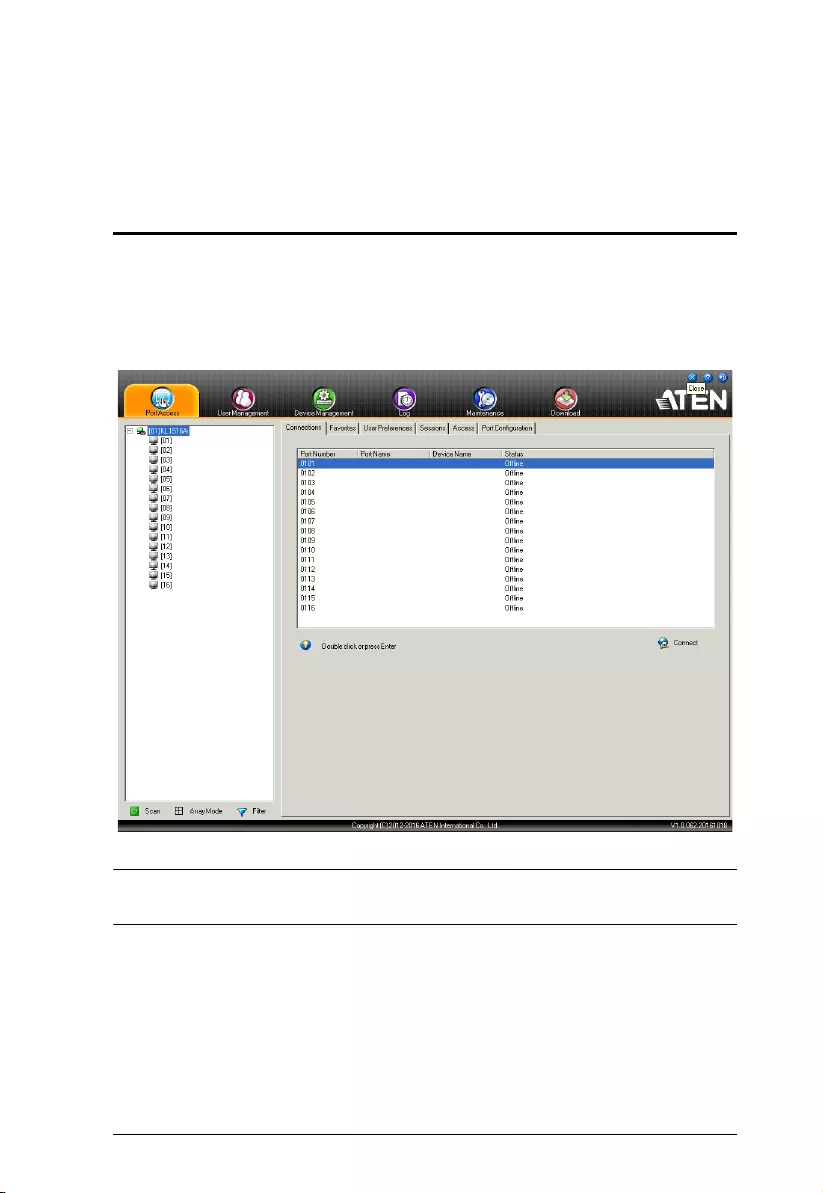
177
Chapter 15
Port Operation
Overview
After you have successfully logged in (see Logging In, page 67), the
KL1508Ai / KL1516Ai opens to the Port Access tab’s Connections page, with
the first KL1508Ai / KL1516Ai selected in the sidebar:
Note: See Connections, page 117 for details about the Port Access
Connections page.

KL1508Ai / KL1516Ai User Manual
178
Connecting to a Port
All the devices, ports, and outlets that a user is permitted to access are listed in
the Sidebar at the left of the page.
To connect to a port when a device is selected in the Sidebar, double click
its icon in the Sidebar; or double click anywhere on its line entry in the
main central panel; or select it in the main panel and click Connect at the
bottom right of the page.
To connect to a port when the port is selected in the Sidebar, click
Connect at the right of the Status panel (see page 117).
Once you switch to a port, its screen displays on your monitor, and your
keyboard and mouse input affects the remote server:

Chapter 16. Port Operation
179
The Port Toolbar
The KL1508Ai / KL1516Ai interface provides a toolbar to help you with port
switching operations from within the captured port. To bring up the toolbar, tap
the GUI Hotkey (Scroll Lock or Ctrl), twice. The toolbar appears at the upper
left corner of the screen:
Depending on the settings that were selected for ID Display (see page 121), the
Port Number and/or the Port Name display at the right of the toolbar. The
meanings of the toolbar icons are given in a table on page 180.
When the toolbar displays, mouse input is confined to the toolbar area and
keyboard input has no effect on the server connected to the port. To carry out
operations on the server, close the toolbar by clicking its X icon.
To return to the Port Access Connections page, either click the appropriate icon
(see The Toolbar Icons, page 180), or tap the GUI hotkey again.
Note: 1. You can adjust the toolbar transparency (see Video Settings, page 95).
2. The toolbar functions and icons are also incorporated in the Control
Panel. If you choose to enable them in the Control Panel (see Control
Panel Configuration, page 107), you can disable the Toolbar (see
User Preferences, page 121 for details). To recall the Port Access
Connections page when there is no Toolbar, simply tap the GUI
hotkey twice.

KL1508Ai / KL1516Ai User Manual
180
The Toolbar Icons
The meanings of the toolbar icons are explained in the table below.
Icon Purpose
Click to skip to the first accessible port on the entire installation,
without having to recall the Port Access page.
Click to skip to the first accessible port previous to the current
one, without having to recall the Port Access page.
Click to begin Auto Scan Mode. The KL1508Ai / KL1516Ai
automatically switches among the ports that were selected for
Auto Scanning. This allows you to monitor their activity without
having to switch among them manually.
Click to skip from the current port to the next accessible one,
without having to recall the Port Access page.
Click to skip from the current port to the last accessible port on
the entire installation, without having to recall the Port Access
page.
Click to recall the Port Access page.
Click to invoke Panel Array Mode (see Panel Array Mode,
page 184).
Click to close the toolbar.

Chapter 16. Port Operation
181
Toolbar Hotkey Port Switching
When the toolbar displays, you can use hotkeys to provide KVM focus to a port
directly from the keyboard. The KL1508Ai / KL1516Ai provides the following
hotkey features:
Going directly to a port by keying in its port number and clicking Enter.
Auto Scanning
Skip Mode Switching
The hotkeys are: A and P for Auto Scanning; and the Arrow Keys for Skip
Mode.
Note: 1. In order for hotkey operations to take place, the toolbar must be
visible (see The Port Toolbar, page 179).
2. To use the keys designated as hotkeys (i.e. A, P, etc.) for normal, non-
hotkey purposes, you must first close the toolbar.
3. For issues affecting multiple user operation in Auto Scan Mode, see
Multiuser Operation, page 186.
Auto Scanning
The Scan function automatically switches among all the ports that are
accessible to the currently logged on user at regular intervals, so that the user
can monitor their activity automatically.
Setting the Scan Interval:
The amount of time Auto Scan dwells on each port is set with the Scan
Duration setting (see Scan Duration, page 122).
Invoking Auto Scan
To start Auto Scanning, with the toolbar showing, tap the A key. The Auto
Scan function cycles through the ports in order – starting from the first
port on the installation. An appears in front of the Port ID Display to
indicate that the port is being accessed under Auto Scan Mode.
S

KL1508Ai / KL1516Ai User Manual
182
Pausing Auto Scan
While you are in Auto Scan Mode, you can pause the scanning in order to
keep the focus on a particular server by pressing P. During the time that
Auto Scanning is paused, the S in front of the Port ID blinks On and Off.
Pausing when you want to keep the focus on a particular server can be
more convenient than exiting Auto Scan Mode because when you Resume
scanning, you start from where you left off. If, on the other hand, you were
to exit and then restart Auto Scan Mode, the scanning would start over
from the very first server on the installation.
To Resume Auto Scanning after a pause, press any key except [Esc] or the
[Spacebar]. Scanning continues from where it left off.
Exiting Auto Scan
While Auto Scan Mode is in effect, ordinary keyboard functions are
suspended. You must exit Auto Scan Mode in order to regain normal
control of the keyboard. To exit Auto Scan Mode press [Esc] or the
[Spacebar]. Auto Scanning stops when you exit Auto Scan Mode.
Skip Mode
Skip Mode allows you to switch ports in order to monitor the servers manually.
You can dwell on a particular port for as long or as little as you like - as
opposed to Auto Scanning, which automatically switches after a fixed interval.
The Skip Mode hotkeys are the four Arrow keys. Their operation is explained
in the table below:
Arrow Action
←
Skips from the current port to the first accessible port previous to it.
→
Skips from the current port to the first accessible port that comes after it.
↑
Skips from the current port to the first accessible port on the installation.
↓
Skips from the current port to the last accessible port on the installation.

Chapter 16. Port Operation
183
Recalling the Port Access Page
To dismiss the toolbar and bring back the Port Access page, do one of the
following:
Tap the GUI Hotkey once.
From the toolbar, click the icon that recalls the Port Access page (see The
Toolbar Icons, page 180).
The toolbar closes, and the Port Access Page appears.
GUI Hotkey Summary Table
The following table presents a summary of the GUI Hotkey actions after you
have accessed a port. See User Preferences, page 121 to set the GUI Hotkey.
To... Do This...
Open the Toolbar Click the GUI Hotkey twice
Open the Port
Access Page
The Toolbar is open Click the GUI Hotkey once
The Toolbar is not open Click the GUI Hotkey three times

KL1508Ai / KL1516Ai User Manual
184
Panel Array Mode
Clicking the toolbar's Panel icon invokes Panel Array Mode. Under this mode,
the screen divides into a grid of up to 42 panels:
Each panel represents one of the switch’s ports beginning with Port 1 at
the upper left, and going from left to right; top to bottom.
The number of panels in the array can be selected by clicking the Show
More Ports, and Show Fewer Ports symbols on the panel array toolbar
(see the following page for an explanation of the panel array toolbar).
Only ports that are accessible to the user are displayed. For ports that are
not accessible, the panel is blank.
If the server connected to a port is on line, its screen displays in its panel,
otherwise the panel is blank.
Mousing over a panel displays information about the port (port name,
online status, port access status, and resolution).
You can access a server connected to a port by moving the mouse pointer
over its panel and clicking. You switch to the server exactly as if you had
selected it from the Port Access page.

Chapter 16. Port Operation
185
Panel Array Toolbar
The panel array toolbar provides shortcut navigation and control of the panel
array. The toolbar can be dragged anywhere on the screen. Mousing over an
icon brings up a “tooltip” that provides a short description of the icon’s
function. The icon functions are described in the table below:
Note: For issues affecting multiple user operation in Panel Array Mode, see
Multiuser Operation, page 186.
Click and drag to move the toolbar.
Note: This icon is only available with the Windows Clients. To move the
Java Client toolbars, click on any empty space and drag.
Pause panel scanning, leaving the focus on the panel that currently has it.
Show More Ports: Increase the number of panels in the array.
Show Fewer Ports: Decrease the number of panels in the array.
Toggle 4/3 aspect ratio.
Exit Panel Array mode.

KL1508Ai / KL1516Ai User Manual
186
Multiuser Operation
The KL1508Ai / KL1516Ai supports multiuser operation. When multiple users
simultaneously access the switch from client computers, the rules of
precedence that apply are shown in the following table:
Operation Rule
General The switches utilize a single shared bus implementation –
although they support local and remote login at the same
time, they do not support independent operation. If a local
user logs in while a remote user has already opened a
session, the local user sees the same screen that the
remote user is working on
Auto Scan Mode If a user has invoked Auto Scan Mode (see page 181), and
then another user logs on, at first the new user sees the GUI
Main Page – but as soon as he accesses any port, he
automatically enters Auto Scan Mode (since he is sharing
the bus with the original user).
Any user can halt Auto Scan Mode by recalling the GUI Main
Page. When this occurs, Auto Scan Mode stops and all the
other users on the bus are switched to the port that was
being accessed when Auto Scan Mode stopped.
Panel Array Mode
If a user has invoked Panel Array Mode (see page 184),
and then another user logs on, the new user sees the GUI
Main Page – but as soon as he accesses any port, he
automatically enters Panel Array Mode (since he is
sharing the bus with the original user).
Panel Array Mode continues until the original user stops it.
(Administrators can override Panel Array Mode, however.)
Only the user who starts Panel Array Mode can use the
Skip Mode (see page 182), function.
Only the user who starts Panel Array Mode can switch
ports. Other users automatically switch to the ports that
the original user selects. However, if one of the other
users does not have access rights to the port that the
original user switches to, that user will not be able to view
the port.
Individual users can increase or decrease the number of
panels they wish to view in Panel Array Mode; however,
the picture quality may decrease as the number of panels
increases.
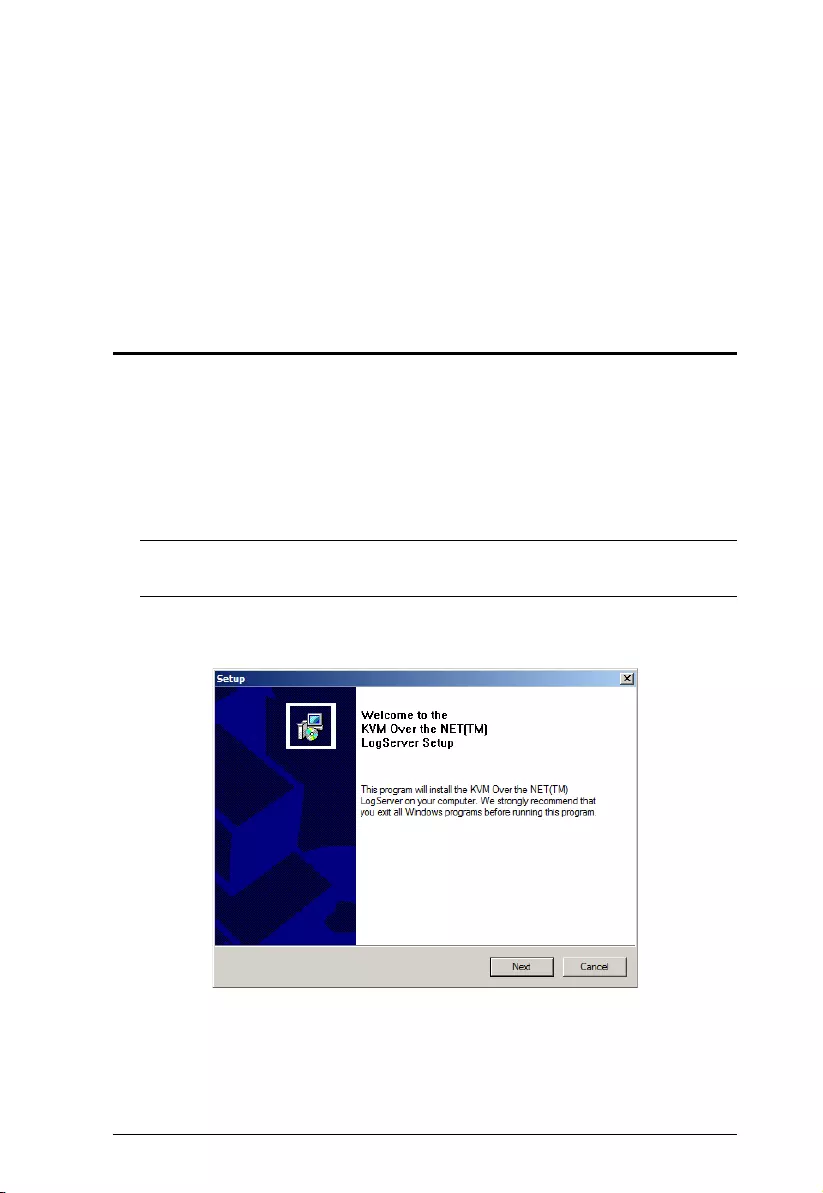
187
Chapter 16
The Log Server
The Windows-based Log Server is an administrative utility that records all the
events that take place on selected KL1508Ai / KL1516Ai units and writes them
to a searchable database. This chapter describes how to install and configure
the Log Server.
Installation
1. Log into the KL1508Ai / KL1516Ai (see page 67).
2. Click the Download tab and download the Log Server AP program.
3. Go to the location on your hard disk that you downloaded the Log Server
program to, and double click its icon (LogSetup.exe) to bring up the
Windows Client Connection Screen:
Note: If the browser cannot run the file, save it to disk, instead, and run the
file from your disk.
The Log Server installation screen appears:
4. Click Next. Then follow the on-screen instructions to complete the
installation and have the Log Server program icon placed on your desktop.

KL1508Ai / KL1516Ai User Manual
188
Starting Up
To start the Log Server, either double click the program icon, or key in the full
path to the program on the command line. The first time you run it, a screen
similar to the one below appears:
Note: 1. The MAC address of the Log Server computer must be specified in
the<Emphasis>ANMS settings – see Log Server, page 146.
2. The Log Server requires the Microsoft Jet OLEDB 4.0 driver.
See The Log Server program does not run., page 217 if the program
doesn’t start.
The screen is divided into three components:
A Menu Bar at the top
A panel that will contain a list of KL1508Ai / KL1516Ai in the middle
(see The Log Server Main Screen, page 193).
A panel that will contain an Events List at the bottom
Each of the components is explained in the sections that follow.
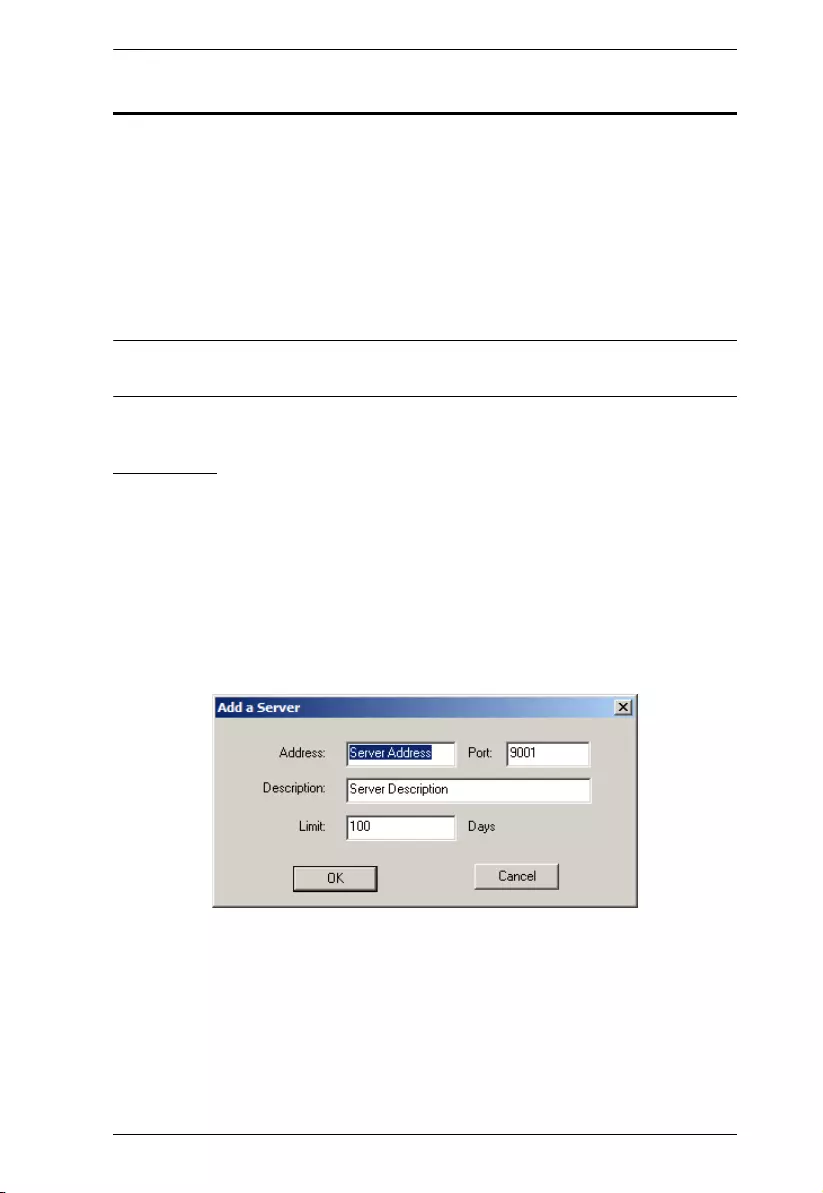
Chapter 16. The Log Server
189
The Menu Bar
The Menu bar consists of four items:
Configure
Events
Options
Help
These are discussed in the sections that follow.
Note: If the Menu Bar appears to be disabled, click in the List window to
enable it.
Configure
The Configure menu contains three items: Add; Edit; and Delete. They are
used to add new units to the List; edit the information for units already on the
list; or delete units from the list.
To add a unit to the list, click Add.
To edit or delete a listed unit, first select the target in the List window, then
open this menu and click Edit or Delete.
When you choose Add or Edit, a dialog box, similar to the one below, appears:
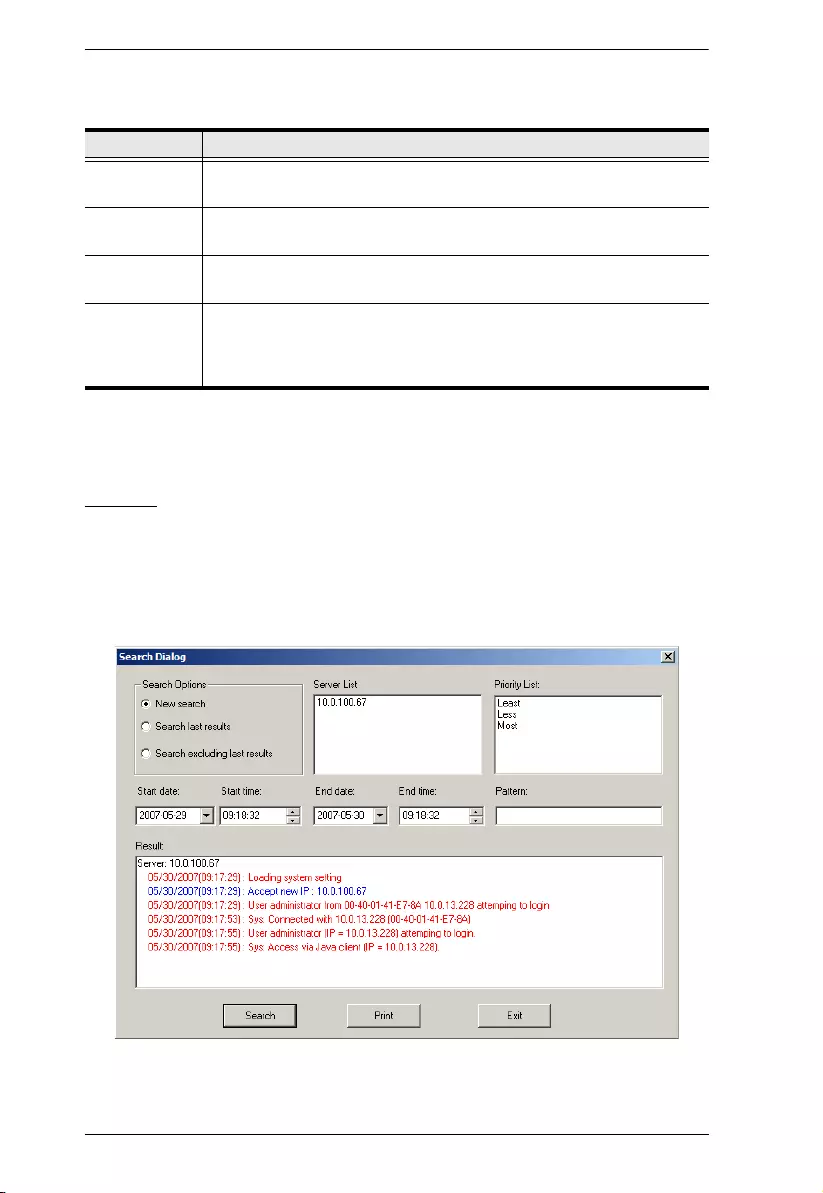
KL1508Ai / KL1516Ai User Manual
190
A description of the fields is given in the table below:
Fill in or modify the fields, then click OK to finish.
Events
The Events Menu has two items: Search and Maintenance.
Search:
Search allows you to search for events containing specific words or strings.
When you access this function, a screen, similar to the one below, appears:
Field Explanation
Address This can either be the IP address of the computer the Log Server is
running on, or its DNS name.
Port The port number that was assigned to the Log Server under Device
Management (see Log Server, page 146).
Description This field is provided so that you can put in a descriptive reference for
the unit to help identify it.
Limit This specifies the number of days that an event should be kept in the
Log Server's database. Events that exceed the amount of time
specified here can be removed with the Maintenance function (see
Maintenance:, page 191).

Chapter 16. The Log Server
191
A description of the items is given in the table, below:
Maintenance:
This function allows the administrator to perform manual maintenance of the
database, such as erasing specified records before their expiration time is up.
Item Description
New search This is one of three radio buttons that define the scope of the
search. If it is selected, the search is performed on all the
events in the database for the selected unit.
Search last results This is a secondary search performed on the events that
resulted from the previous search.
Search excluding last
results
This is a secondary search performed on all the events in the
database for the selected unit excluding the events that
resulted from the previous search.
Server List KL1508Ai / KL1516Ai units are listed according to their IP
address. Select the unit that you want to perform the search on
from this list. You can select more than one unit for the search.
If no units are selected, the search is performed on all of them.
Priority Sets the level for how detailed the search results display
should be. Least is the most general; Most is the most specific.
Least results appear in black; Less results appear in blue;
Most results appear in red.
Start Date Select the date that you want the search to start from. The
format follows the YYYY/MM/DD convention, as follows:
2009/11/04
Start Time Select the time that you want the search to start from. The
format follows the HH:MM:SS convention.
End Date Select the date that you want the search to end at.
End Time Select the time that you want the search to end at.
Pattern Key in the pattern that you are searching for here. The multiple
character wildcard (%) is supported. E.g., h%ds would match
hands and hoods.
Results Lists the events that contained matches for the search.
Search Click this button to start the search.
Print Click this button to print the search results.
Export Click this button to save the search results to file.
Exit Click this button to exit the Log Server.
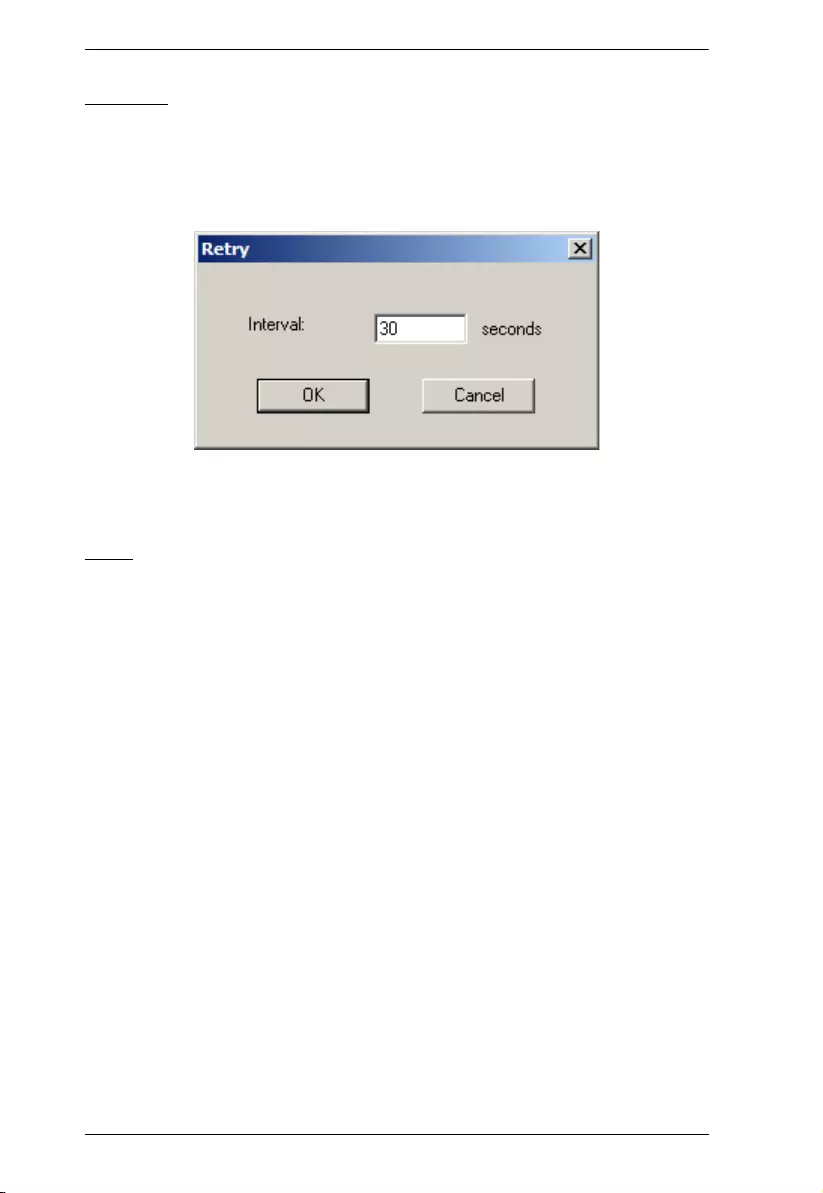
KL1508Ai / KL1516Ai User Manual
192
Options
Network Retry allows you to set the number of seconds that the Log Server
should wait before attempting to connect if its previous attempt to connect
failed. When you click this item, a dialog box, similar to the one below,
appears:
Key in the number of seconds, then click OK to finish.
Help
From the Help menu, click Contents to access the online Windows Help file.
The help file contains instructions about how to setup, operation and
troubleshoot the Log Server.
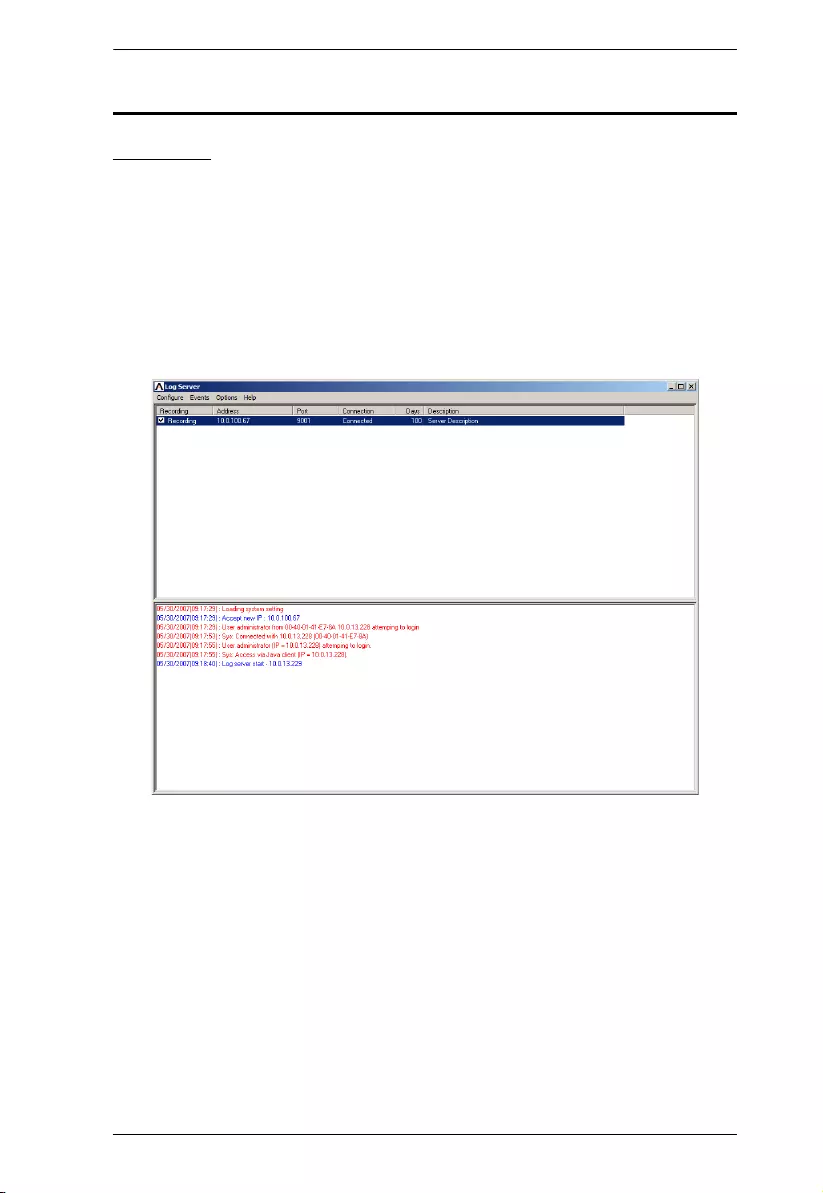
Chapter 16. The Log Server
193
The Log Server Main Screen
Overview
The Log Server Main Screen is divided into two main panels.
The upper (List) panel lists all of the units that have been selected for the
Log Server to track (see Configure, page 189).
The lower (Event) panel displays the tick information for the currently
selected unit. (If there are more than one unit, the selected unit is the one
that is highlighted).
To select a unit in the list, simply click on it.

KL1508Ai / KL1516Ai User Manual
194
The List Panel
The List panel contains six fields:
The Event Panel
The lower panel displays log events for the currently selected unit. Note that if
there are more than one units, even though they aren't currently selected, if their
Recording checkbox is checked, the Log Server records their log events and
keeps them in its database.
Field Explanation
Recording Determines whether the Log Server records the ticks for this
unit, or not. If the Recording checkbox is checked, the field
displays Recording, and the ticks are recorded. If the
Recording checkbox is not checked, the field displays Paused,
and the ticks are not recorded.
Note: Even though a unit is not the currently selected one, if
its Recording checkbox is checked, the Log Server will still
record its ticks.
Address This is the IP Address or DNS name that was given to the unit
when it was added to the Log Server (see Configure,
page 189).
Port This is the Access Port number assigned to the unit (see
Configure, page 189).
Connection
If the Log Server is connected to the unit, this field displays
Connected.
If the Log Server is not connected, this field displays
Waiting. This means that the Log Server's MAC address
has not been set properly. It needs to be set on the Date/
Time, page 161.
Days This field displays the number of days that the unit's log events
are to be kept in the Log Server's database before expiration
(see Configure, page 189).
Description This field displays the descriptive information given for the unit
when it was added to the Log Server (see Configure,
page 189).

195
Appendix
Safety Instructions
General
This product is for indoor use only.
Read all of these instructions. Save them for future reference.
Follow all warnings and instructions marked on the device.
Do not place the device on any unstable surface (cart, stand, table, etc.). If
the device falls, serious damage will result.
Do not use the device near water.
Do not place the device near, or over, radiators or heat registers.
The device cabinet is provided with slots and openings to allow for
adequate ventilation. To ensure reliable operation, and to protect against
overheating, these openings must never be blocked or covered.
The device should never be placed on a soft surface (bed, sofa, rug, etc.) as
this will block its ventilation openings. Likewise, the device should not be
placed in a built in enclosure unless adequate ventilation has been provided.
Never spill liquid of any kind on the device.
Unplug the device from the wall outlet before cleaning. Do not use liquid
or aerosol cleaners. Use a damp cloth for cleaning.
The device should be operated from the type of power source indicated on
the marking label. If you are not sure of the type of power available,
consult your dealer or local power company.
The device is designed for IT power distribution systems with 230V
phase-to-phase voltage.
To prevent damage to your installation it is important that all devices are
properly grounded.
The device is equipped with a 3-wire grounding type plug. This is a safety
feature. If you are unable to insert the plug into the outlet, contact your
electrician to replace your obsolete outlet. Do not attempt to defeat the
purpose of the grounding-type plug. Always follow your local/national
wiring codes.
Do not allow anything to rest on the power cord or cables. Route the
power cord and cables so that they cannot be stepped on or tripped over.

KL1508Ai / KL1516Ai User Manual
196
Avoid circuit overloads. Before connecting equipment to a circuit, know
the power supply’s limit and never exceed it. Always review the electrical
specifications of a circuit to ensure that you are not creating a dangerous
condition or that one doesn’t already exist. Circuit overloads can cause a
fire and destroy equipment.
If an extension cord is used with this device make sure that the total of the
ampere ratings of all products used on this cord does not exceed the
extension cord ampere rating. Make sure that the total of all products
plugged into the wall outlet does not exceed 15 amperes.
To help protect your system from sudden, transient increases and
decreases in electrical power, use a surge suppressor, line conditioner, or
uninterruptible power supply (UPS).
Position system cables and power cables carefully; Be sure that nothing
rests on any cables.
Never push objects of any kind into or through cabinet slots. They may
touch dangerous voltage points or short out parts resulting in a risk of fire
or electrical shock.
Do not attempt to service the device yourself. Refer all servicing to
qualified service personnel.
If the following conditions occur, unplug the device from the wall outlet
and bring it to qualified service personnel for repair.
The power cord or plug has become damaged or frayed.
Liquid has been spilled into the device.
The device has been exposed to rain or water.
The device has been dropped, or the cabinet has been damaged.
The device exhibits a distinct change in performance, indicating a need
for service.
The device does not operate normally when the operating instructions
are followed.
Only adjust those controls that are covered in the operating instructions.
Improper adjustment of other controls may result in damage that will
require extensive work by a qualified technician to repair.
Do not connect the RJ-11 connector marked “UPGRADE” to a public
telecommunications network.

Appendix
197
Rack Mounting
Before working on the rack, make sure that the stabilizers are secured to
the rack, extended to the floor, and that the full weight of the rack rests on
the floor. Install front and side stabilizers on a single rack or front
stabilizers for joined multiple racks before working on the rack.
Always load the rack from the bottom up, and load the heaviest item in the
rack first.
Make sure that the rack is level and stable before extending a device from
the rack.
Use caution when pressing the device rail release latches and sliding a
device into or out of a rack; the slide rails can pinch your fingers.
After a device is inserted into the rack, carefully extend the rail into a
locking position, and then slide the device into the rack.
Do not overload the AC supply branch circuit that provides power to the
rack. The total rack load should not exceed 80 percent of the branch circuit
rating.
Make sure that all equipment used on the rack - including power strips and
other electrical connectors - are properly grounded.
Ensure that proper airflow is provided to devices in the rack.
Ensure that the operating ambient temperature of the rack environment
does not exceed the maximum ambient temperature specified for the
equipment by the manufacturer.
Do not step on or stand on any device when servicing other devices in a
rack.
Caution: Slide/rail (LCD KVM) mounted
equipment is not to be used as a shelf or a work
space.

KL1508Ai / KL1516Ai User Manual
198
Technical Support
Technical support is available both by email and online (with a browser over
the web):
International
For online technical support – including troubleshooting, documentation,
and software updates: http://support.aten.com
For telephone support, see Telephone Support, page vii:
North America
When you contact us, please have the following information ready beforehand:
Product model number, serial number, and date of purchase.
Your computer configuration, including operating system, revision level,
expansion cards, and software.
Any error messages displayed at the time the error occurred.
The sequence of operations that led up to the error.
Any other information you feel may be of help.
Email Support support@aten-usa.com
Online
Technical
Support
Troubleshooting
Documentation
Software Updates
http://support.aten.com
Telephone Support 1-888-999-ATEN ext 4988

Appendix
199
Specifications
KL1508AiM / KL1508AiN
Function KL1508AiM KL1508AiN
Console Connections
Local 1 (Share Remote Bus)
Remote 1
Computer Connections
Direct 8
Maximum 128 (via Daisy-chain)
Port Selection OSD, Hotkey, Pushbutton
Connectors
Console Ports
2 x USB Type-A Female (White)
1 x 6-pin Mini-DIN Female (Purple)
1 x 6-pin Mini-DIN Female (Green)
1 x HDB-15 Female (Blue)
External Mouse
Port 1 x USB Type-A Female
KVM Ports 8 x RJ-45 Female
Daisy Chain
Ports 1 x DB-25 Male
PoN 1 x RJ-45 Female
Firmware
Upgrade 1 x RJ-11 Female
LAN Ports 1 x RJ-45 Female
Power 1 x IEC 60320/C14
Switches
Port Selection 8 x Pushbutton
Station Selection 2 x Pushbutton
Reset 1 x Semi-recessed Pushbutton
Firmware
Upgrade 1 x Slide Switch
Power 1 x Rocker Switch
LCD Power 1 x Pushbutton
LCD Adjustment 4 x Pushbutton

KL1508Ai / KL1516Ai User Manual
200
LEDs
Online 8 (Green)
Selected 8 (Orange)
Station Selection 2 x 7 Segments (Orange)
Link 1 (Green)
10/100/1000
Mbps
non-FHD: 10/100 Mbps (Orange / Green)
FHD: 100/1000 Mbps (Orange / Green)
Power 1 (Blue)
LCD Power 1 (Orange)
Lock
1 x Num Lock (Green)
1 x Caps Lock (Green)
1 x Scroll Lock (Green)
Video
Local / Remote FHD: 1920 x 1200 @ 60 Hz*
Non-FHD: 1600 x 1200 @ 60 Hz
Panel Spec
LCD Module 17" TFT-LCD 19" TFT-LCD
Resolution 1280 x 1024 @ 75 Hz
Pixel Pitch 0.264 mm x 0.264 mm 0.294 mm x 0.294 mm
Response Time 5 ms
Viewing Angle 170° (H), 160° (V)
Support Color 16.7M colors
Contrast Ratio 1000:01:00
Luminance 250 cd/m²
Emulation
Keyboard /
Mouse PS/2; USB
Scan Interval 1–255 sec.
Maximum Input
Power Rating 100–240V AC, 50-60Hz, 1A
Power
Consumption
AC110V: 21.1W:110BTU
AC220V: 22.2W:115BTU
AC110V: 24.3W:125BTU
AC220V: 24.5W:126BTU
Environmental
Operating
Temperature 0 - 40°C
Function KL1508AiM KL1508AiN

Appendix
201
*Please check the product label to ensure it’s the FHD version.
Storage
Temperature -20 - 60°C
Humidity 0–80% RH, Non-condensing
Physical Properties
Housing Metal
Weight 15.23 kg (33.55 lb) 15.39 kg (33.9 lb)
Dimensions 48.00 x 70.12 x 4.40 cm
(18.9 x 27.61 x 1.73 in.)
Function KL1508AiM KL1508AiN

KL1508Ai / KL1516Ai User Manual
202
KL1516AiM / KL1516AiN
Function KL1516AiM KL1516AiN
Console Connections
Local 1 (Share Remote Bus)
Remote 1
Computer Connections
Direct 16
Maximum 256 (via Daisy-chain)
Port Selection OSD, Hotkey, Pushbutton
Connectors
Console Ports
2 x USB Type-A Female (White)
1 x 6-pin Mini-DIN Female (Purple)
1 x 6-pin Mini-DIN Female (Green)
1 x HDB-15 Female (Blue)
External Mouse
Port 1 x USB Type-A Female
KVM Ports 16 x RJ-45 Female
Daisy Chain
Ports 1 x DB-25 Male
PoN 1 x RJ-45 Female
Firmware
Upgrade 1 x RJ-11 Female
LAN Ports 1 x RJ-45 Female
Power 1 x IEC 60320/C14
Switches
Port Selection 16 x Pushbutton
Station Selection 2 x Pushbutton
Reset 1 x Semi-recessed Pushbutton
Firmware
Upgrade 1 x Slide
Power 1 x Rocker
LCD Power 1 x Pushbutton
LCD Adjustment 4 x Pushbutton
LEDs
Online 16 (Green)
Selected 16 (Orange)

Appendix
203
Station Selection 2 x 7 Segments (Orange)
Link 1 (Green)
10/100/1000
Mbps
non-FHD: 10/100 Mbps (Orange/Green)
FHD: 100/1000 Mbps (Orange/Green)
Power 1 (Blue)
LCD Power 1 (Orange)
Lock
1 x Num Lock (Green)
1 x Caps Lock (Green)
1 x Scroll Lock (Green)
Video
Local / Remote FHD: 1920 x 1200 @ 60 Hz*
Non-FHD: 1600 x 1200 @ 60 Hz
Panel Spec
LCD Module 17" TFT-LCD 19" TFT-LCD
Resolution 1280 x 1024 @ 75 Hz
Pixel Pitch 0.264 mm x 0.264 mm 0.294 mm x 0.294 mm
Response Time 5 ms
Viewing Angle 170° (H), 160° (V)
Support Color 16.7M colors
Contrast Ratio 1000:1
Luminance 250 cd/m²
Emulation
Keyboard /
Mouse PS/2; USB
Scan Interval 1–255 sec.
Maximum Input
Power Rating 100–240V AC, 50-60Hz, 1A
Power
Consumption
AC110V: 21.2W:110BTU
AC220V: 23.1W:119BTU
AC110V: 24.4W:125BTU
AC220V: 25.4W:130BTU
Environmental
Operating
Temperature 0 - 40°C
Storage
Temperature -20 - 60°C
Humidity 0–80% RH, Non-condensing
Physical Properties
Function KL1516AiM KL1516AiN

KL1508Ai / KL1516Ai User Manual
204
*Please check the product label to ensure it’s the FHD version.
Housing Metal
Weight 15.24 kg (33.57 lb) 15.40 kg (33.92 lb)
Dimensions 48.00 x 70.12 x 4.40 cm
(18.9 x 27.61 x 1.73 in.)
Function KL1516AiM KL1516AiN
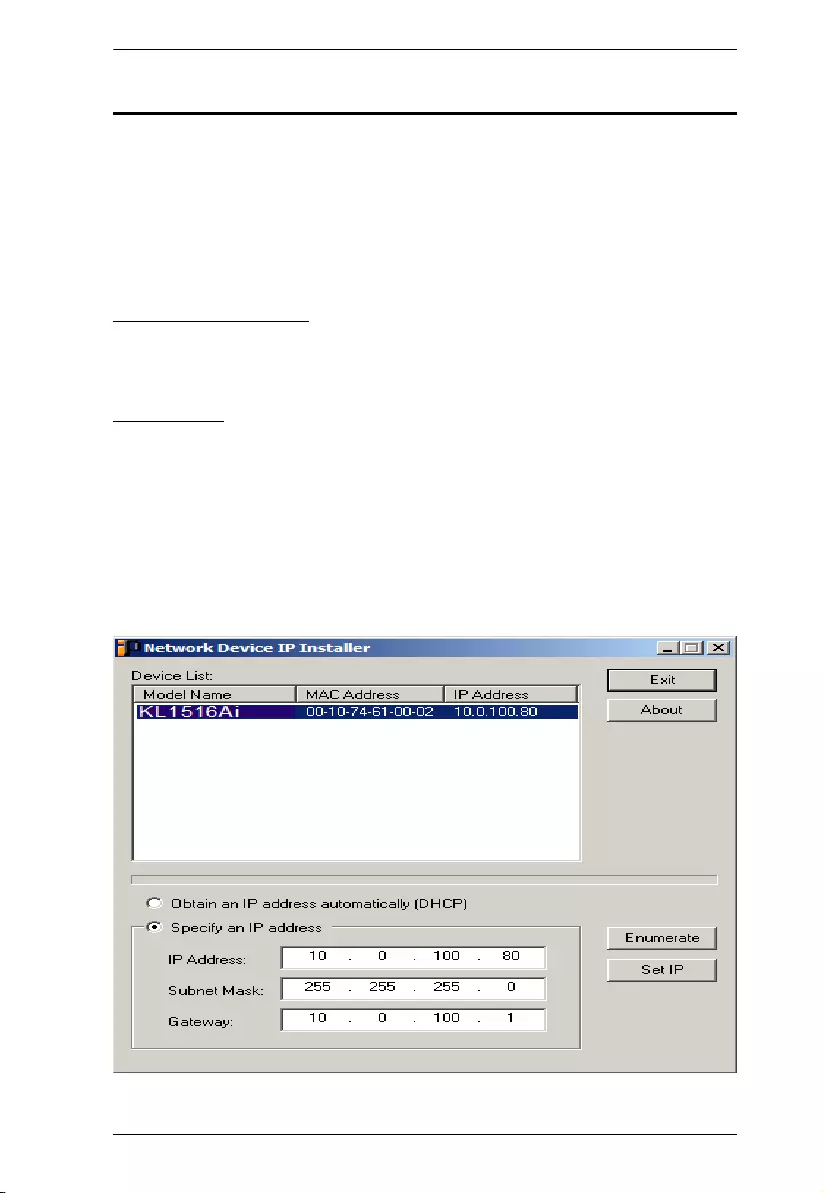
Appendix
205
IP Address Determination
If you are an administrator logging in for the first time, you need to access the
KL1508Ai / KL1516Ai in order to give it an IP address that users can connect
to. There are three methods to choose from. In each case, your client computer
must be on the same network segment as the KL1508Ai / KL1516Ai. After you
have connected and logged in you can give the KL1508Ai / KL1516Ai its fixed
network address. (See Network, page 142.)
The Local Console
The easiest way to assign an IP address is from the local console. Refer to SET
IP ADDRESS, page 47, for details on the procedure involved.
IP Installer
For client computers running Windows, an IP address can be assigned with the
IP Installer utility. The utility can be obtained from the Download area of our
website. Look under Driver/SW, and the model of your switch. After
downloading the utility to your client computer, do the following:
1. Unzip the contents of IPInstaller.zip to a directory on your hard drive.
2. Go to the directory that you unzipped the IPInstaller program to and run
IPInstaller.exe. A dialog box similar to the one below appears:

KL1508Ai / KL1516Ai User Manual
206
3. Select the KL1508Ai / KL1516Ai in the Device List.
Note: 1. If the list is empty, or your device doesn't appear, click
Enumerate to refresh the Device List.
2. If there is more than one device in the list, use the MAC address
to pick the one you want.
4. Select either Obtain an IP address automatically (DHCP), or Specify an
IP address. If you chose the latter, fill the IP Address, Subnet Mask, and
Gateway fields with the information appropriate to your network.
5. Click Set IP.
6. After the IP address shows up in the Device List, click Exit. See IP
Installer, page 143 for more information.
Browser
1. Set your client computer's IP address to 192.168.0.XXX
Where XXX represents any number or numbers except 60. (192.168.0.60 is
the default address of the KL1508Ai / KL1516Ai.)
2. Specify the switch's default IP address (192.168.0.60) in your browser, and
you will be able to connect.
3. Assign a fixed IP address for the KL1508Ai / KL1516Ai that is suitable
for the network segment that it resides on.
After you log out, reset your client computer's IP address to its original value.

Appendix
207
IPv6
At present, the KL1508Ai / KL1516Ai supports three IPv6 address protocols:
Link Local IPv6 Address, IPv6 Stateless Autoconfiguration, and Stateful
Autoconfiguration (DHCPv6).
Link Local IPv6 Address
At power on, the KL1508Ai / KL1516Ai is automatically configured with a
Link Local IPv6 Address (for example, fe80::210:74ff:fe61:1ef). To find out
what the Link Local IPv6 Address is, log in with the KL1508Ai / KL1516Ai
IPv4 address and open the Device Management
→
Device Information page.
The address is displayed in the General list box (see page 140).
Once you have determined what the IPv6 address is, you can use it when
logging in from a browser or the Win and Java Client AP programs.
For example:
If you are logging in from a browser, you would key in
http://[fe80::2001:74ff:fe6e:59%5]
for the URL bar.
If you are logging in with the AP program, you would key:
fe80::2001:74ff:fe6e:59%5
for the IP field of the Server panel (see Windows Client AP Login, page 70).
Note: 1. To log in with the Link Local IPv6 Address, the client computer must
be on the same local network segment as the KL1508Ai / KL1516Ai
2. The %5 is the %interface used by the client computer. To see your
client computer’s IPv6 address: from the command line issue the
following command: ipconfig /all. The % value appears at the
end of the IPv6 address.

KL1508Ai / KL1516Ai User Manual
208
IPv6 Stateless Autoconfiguration
If the KL1508Ai / KL1516Ai network environment contains a device (such as
a router) that supports the IPv6 Stateless Autoconfiguration function, the
KL1508Ai / KL1516Ai can obtain its prefix information from that device in
order to generate its IPv6 address. For example, 2001::74ff:fe6e:59.
As above, the address is displayed in the General list box of the Device
Management
→
Device Information page (see page 140).
Once you have determined what the IPv6 address is, you can use it when
logging in from a browser or the Win and Java Client AP programs.
For example:
If you are logging in from a browser, you would key in
http://[2001::74ff:fe6e:59]
for the URL bar.
If you are logging in with the AP program, you would key:
2001::74ff:fe6e:59
for the IP field of the Server panel (see Windows Client AP Login, page 70).
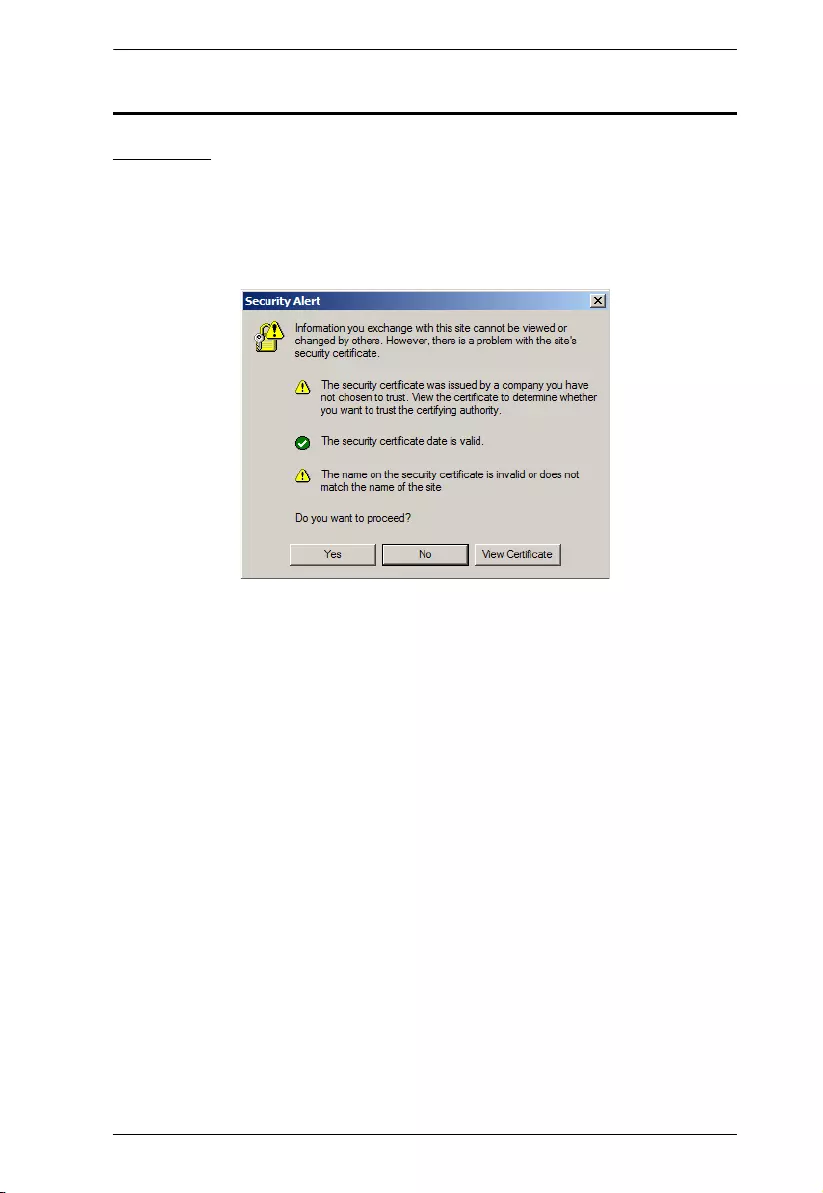
Appendix
209
Trusted Certificates
Overview
When you try to login to the KL1508Ai / KL1516Ai from your Web browser,
a Security Alert message appears to inform you that the device’s certificate is
not trusted, and asks if you want to proceed.
The certificate can be trusted, but the alert is triggered because the certificate’s
name is not found on Microsoft’s list of Trusted Authorities. You have two
options: 1) you can ignore the warning and click Ye s to go on; or 2) you can
install the certificate and have it be recognized as trusted.
If you are working on a computer at another location, accept the certificate
for just this session by clicking Yes .
If you are working at your own computer, install the certificate on your
computer (see below for details). After the certificate is installed, it will be
recognized as trusted.
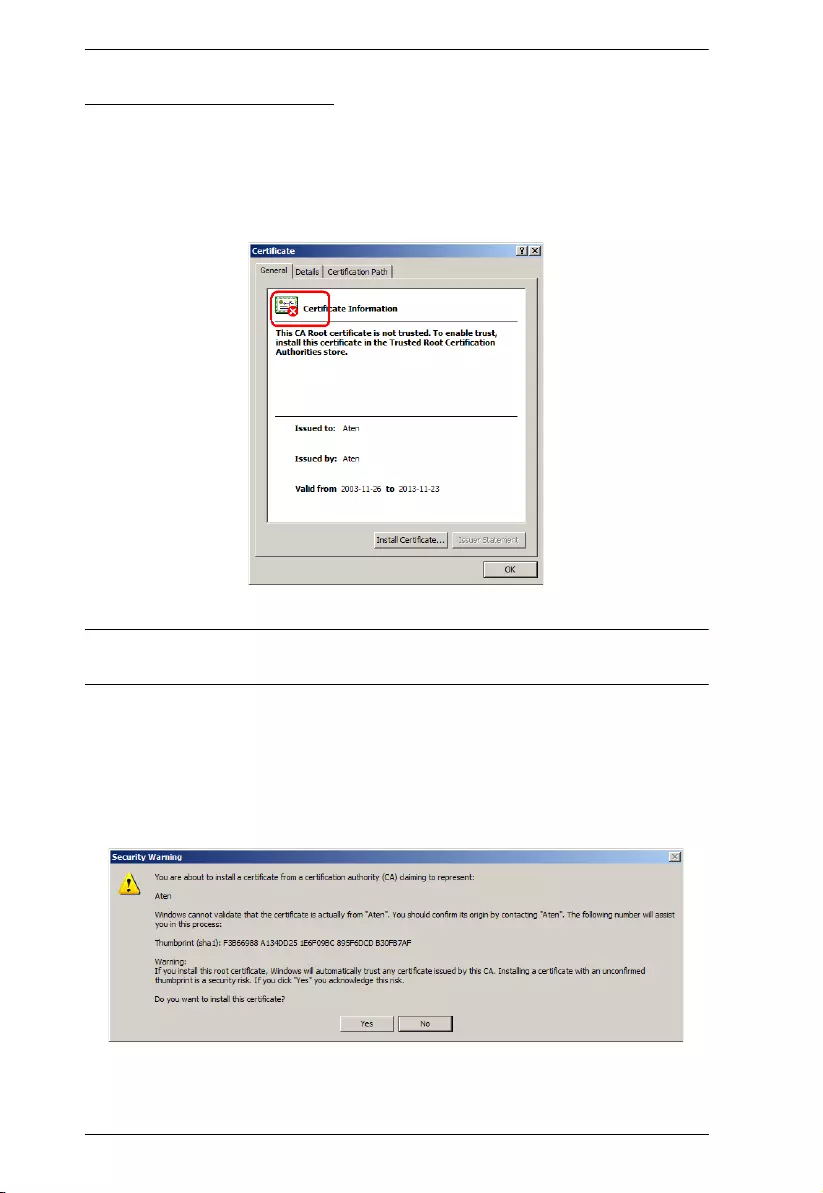
KL1508Ai / KL1516Ai User Manual
210
Installing the Certificate
To install the certificate:
1. In the Security Alert dialog box, click View Certificate. The Certificate
dialog box appears.
Note: There is a red and white X logo over the certificate to indicate that it is
not trusted.
2. Click Install Certificate.
3. Follow the Installation Wizard to complete the installation. Unless you
have a specific reason to choose otherwise, accept the default options. The
Wizard presents a caution screen:
4. Click Ye s .
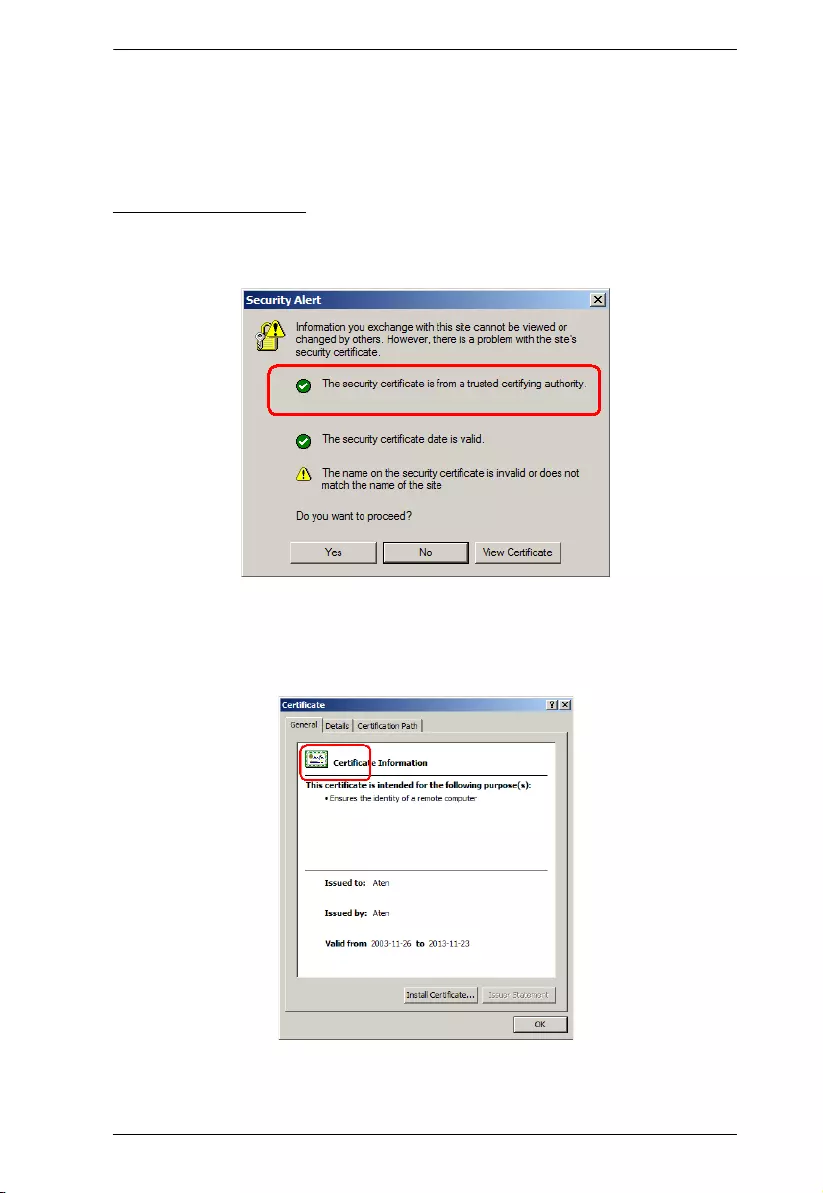
Appendix
211
5. Click Finish to complete the installation.
6. Click OK to close the dialog box.
Certificate Trusted
The certificate is now trusted:
When you click View Certificate, you can see that the red and white X logo is
no longer present – further indication that the certificate is trusted.

KL1508Ai / KL1516Ai User Manual
212
Self-Signed Private Certificates
If you wish to create your own self-signed encryption key and certificate, a free
utility – openssl.exe – is available for download over the web at
www.openssl.org. To create your private key and certificate do the following:
1. Go to the directory where you downloaded and extracted openssl.exe to.
2. Run openssl.exe with the following parameters:
openssl req -new -newkey rsa:1024 -days 3653 -nodes -x509
-keyout CA.key -out CA.cer -config openssl.cnf
Note: 1. The command should be entered all on one line (i.e., do not press
[Enter] until all the parameters have been keyed in).
2. If there are spaces in the input, surround the entry in quotes (e.g.,
“ATEN International”).
To avoid having to input information during key generation the following
additional parameters can be used: /C /ST /L /O /OU /CN /emailAddress.
Examples
openssl req -new -newkey rsa:1024 -days 3653 -nodes -x509
-keyout CA.key -out CA.cer -config openssl.cnf -subj
/C=yourcountry/ST=yourstateorprovince/L=yourlocationor
city/O=yourorganiztion/OU=yourorganizationalunit/
CN=yourcommonname/emailAddress=name@yourcompany.com
openssl req -new -newkey rsa:1024 -days 3653 -nodes -x509
-keyout CA.key -out CA.cer -config openssl.cnf -subj
/C=CA/ST=BC/L=Richmond/O="ATEN International"/OU=ATEN
/CN=ATEN/emailAddress=eservice@aten.com.tw
Importing the Files
After the openssl.exe program completes, two files – CA.key (the private key)
and CA.cer (the self-signed SSL certificate) – are created in the directory that
you ran the program from. These are the files that you upload in the Private
Certificate panel of the Security page (see page 158).

Appendix
213
Troubleshooting
Administration
General Operation
Problem Resolution
After upgrading firmware, the
KL1508Ai / KL1516Ai still appears to
be using the old firmware version.
Your Internet browser is displaying cached web
pages – not new ones. Clear your browser
cache; delete all temporary Internet files and
cookies, close the Internet browser, and then
open a new instance of the browser.
The default network setting for the
KL1508Ai / KL1516Ai is DHCP, but
the network uses fixed IP addresses
and doesn’t have a DHCP server.
Use the local console OSD’s F4 function to
give the KL1508Ai / KL1516Ai a fixed IP
address. See page 142, for details.
Problem Resolution
Erratic Operation Press and hold the Reset Switch (see page 11)
for longer than three seconds.
Mouse and/or keyboard not
responding due to improper mouse
and/or keyboard reset.
Unplug the cable(s) from the console port(s),
then plug it back in again.
Sudden loss of network connection
due to local reset of KL1508Ai /
KL1516Ai.
Close your KL1508Ai / KL1516Ai connection.
Wait approximately 30 seconds, and log in
again.
Mouse Pointer Confusion If you find the display of two mouse pointers
(local and remote) to be confusing or
annoying, you can use the Toggle Mouse
Display function to shrink the non-functioning
pointer. See page 87 for details.
Some characters that are keyed in
don’t display on the remote system
This is usually due to the local OS keyboard
language and the remote OS keyboard
language being different. Make sure that the
keyboard language for both systems are the
same.
Keyboard and/or mouse do not work
after computer boots up.
For computers with PS/2 connectors, if you are
using 2L-520xP cables, make sure that all the
connectors (keyboard, video, and mouse) are
plugged into their ports on the computer before
starting the computer. Plugging the cables in
after the computer has booted will not resolve
the problem.

KL1508Ai / KL1516Ai User Manual
214
When I emulate the Sun keyboard, I
can’t go into OK Mode ([Stop] [A]).
To go into OK Mode, use the following key
sequence:
1. Press and release [Ctrl].
2. Press and hold [T].
3. Press and hold [A].
4. Release [T] and [A] together.
There are ghost images on the
external monitor.
The distance between the external console
and the KL1508Ai / KL1516Ai is too great. The
maximum VGA cable distance should not
exceed 20m and, in some cases, may need to
be shorter. Replace the VGA cable with one of
an appropriately short length.
I can’t set the computers’ screen
resolutions higher than 1280 x 1024,
even though the KL1508Ai / KL1516Ai
supports 1920 x 1200 for remote
computers.
The maximum screen resolution of the
KL1508Ai / KL1516Ai’s integrated LCD monitor
is 1280 x 1024. In order to protect it from being
damaged by resolutions that are beyond its
display capability, we recommend that the
screen resolutions of the connected computers
be set to 1280 x 1024 or lower.
If you wish to set the screen resolutions of the
connected computers to something higher
than 1280 x 1024, see Screen Resolutions
Higher than 1280 x 1024, page 219.
When I switch to one of the computers
on my installation, the LCD monitor
screen goes blank. All I see is a black
screen.
The maximum screen resolution of the
KL1508Ai / KL1516Ai’s integrated LCD monitor
is 1280 x 1024. The screen resolution of the
problem computer is set to something that is
too high for the KL1508Ai / KL1516Ai’s LCD
monitor to display.
To resolve the problem, connect an external
KVM console (with a monitor capable of
displaying the problem computer’s screen
resolution) to the KL1508Ai / KL1516Ai’s
external console ports. Use the external
console to access the problem computer and
reduce its resolution to 1280 x 1024.
Note: Although the LCD monitor only supports
video resolutions of up to 1280 x 1024, the
KL1508Ai / KL1516Ai, itself can support video
resolutions up to 1920 x 1200 @ 60 Hz. If you
wish to set the screen resolutions of the
connected computers to something higher
than 1280 x 1024, see Screen Resolutions
Higher than 1280 x 1024, page 219 for details.
Problem Resolution

Appendix
215
My ATEN over IP unit is not listed in
the Device List of IP Installer.
Make sure the Broadcast function is
enabled from your switch or router in order
for the auto-discover to work properly.
Make sure to turn off your firewall and/or
antivirus software temporarily in order for
the auto-discover to work properly.
Make sure the ATEN over IP unit and the
PC are under the same network segment.
Problem Resolution

KL1508Ai / KL1516Ai User Manual
216
The Windows Client
The Java Client
For connection and operation problems, see the table below:
Problem Resolution
Won't connect to the KL1508Ai /
KL1516Ai.
DirectX 8.0 or higher must be installed on your
computer.
Remote mouse pointer is out of
sync.
1. Use the AutoSync feature (see Video Settings,
page 95), to sync the local and remote monitors.
2. If that doesn't resolve the problem, use the
Adjust Mouse feature (see Manual Mouse Syn-
chronization, page 106) to bring them back in
sync.
3. If the two methods described above fail to
resolve the problem, use the Toggle Mouse Dis-
play function (see page 87).
Part of remote window is off my
monitor.
Use the AutoSync feature (see Video Settings,
page 95) to synchronize the local and remote
monitors.
My antivirus program reports that
there is a trojan after I access the
KL1508Ai / KL1516Ai with my
browser and then open the
Windows Client Viewer.
The Windows Client Viewer uses an ActiveX plug-
in (windows.ocx) that some antivirus programs
mistakenly see as a virus or trojan. We have tested
our firmware extensively and found no evidence of
a virus or trojan. You can add the plug-in to your
antivirus program’s White List and use the Viewer
safely. If you are reluctant to use the Windows
Client Viewer, however, you can simply use the
Java Client Viewer, instead.
Problem Resolution
Java Client won't
connect to the
KL1508Ai /
KL1516Ai.
1. Java JRE 6 update 3 or higher must be installed on your com-
puter.
2. Make sure to include the correct name of the web page
when you specify the KL1508Ai / KL1516Ai's IP address.
3. Close the Java Client, reopen it, and try again.
Pressing the
Windows Menu key
has no effect.
Java doesn't support the Windows Menu key.
Java Client
performance
deteriorates.
Exit the program and start again.
National language
characters do not
appear.
When entering national language characters, if your local
keyboard is set to a non-English national language layout, you
must set the remote computer's keyboard layout to English.

Appendix
217
The Log Server
Panel Array Mode
Problem Resolution
The Log Server
program does not
run.
The Log Server requires the Microsoft Jet OLEDB 4.0 driver in
order to access the database.
This driver is automatically installed with Windows ME, 2000,
and XP.
For Windows 98 and NT you will have to go to the Microsoft
download site:
http://www.microsoft.com/data/download.htm
to retrieve the driver file:
MDAC 2.7 RTM Refresh (2.70.9001.0)
Since this driver is used in Windows Office Suite, an alternate
method of obtaining it is to install Windows Office Suite. Once
the driver file or Suite has been installed, the Log Server will run.
Problem Resolution
Low resolution video in Panel
Array Mode.
Increase the number of panels that are displayed.
Some users only receive a partial
image when multiple remote
users are logged in concurrently.
The first user to invoke Panel Array Mode should
set it to display a minimum of four panels.

KL1508Ai / KL1516Ai User Manual
218
Sun Systems
*These solutions work for most common Sun VGA cards. If using them
fails to resolve the problem, consult the Sun VGA card's manual.
Problem Resolution
Video display problems with
HDB-15 interface systems
(e.g. Sun Blade 1000 servers).
The display resolution should be set to 1024 x 768.
Under Text Mode:
1. Go to OK mode and issue the following com-
mands:
setenv output-device screen:r1024x768x60
reset-all
Under XWindow:
1. Open a console and issue the following command:
m64config -res 1024x768x60
2. Log out.
3. Log in.
Video display problems with
13W3 interface systems (e.g.
Sun Ultra servers).*
The display resolution should be set to 1024 x 768.
Under Text Mode:
1. Go to OK mode and issue the following com-
mands:
setenv output-device screen:r1024x768x60
reset-all
Under XWindow:
1. Open a console and issue the following command:
ffbconfig -res 1024x768x60
2. Log out.
3. Log in.

Appendix
219
Screen Resolutions Higher than 1280 x 1024
The maximum screen resolution of the KL1508Ai / KL1516Ai’s integrated
LCD monitor is 1280 x 1024. In order to protect it from being damaged by
resolutions that are beyond its display capability, we recommend that the
screen resolutions of the connected computers be set to 1280 x 1024 or lower.
If you wish to display screen resolutions higher than 1280 x 1024, follow the
procedure described below to change the computers’ screen resolutions and
safeguard the KL1508Ai / KL1516Ai’s LCD monitor:
Note: We strongly recommend that you close the KL1508Ai / KL1516Ai
LCD console before continuing (see Closing the Console, page 31.)
Using the LCD monitor to view computers that are set to resolutions
that exceed its maximum capability can damage it and shorten its life
span.
To access computers from the external local console when the
integrated console is closed, simply connect an external KVM console
with a monitor that supports 1920 x 1200 @ 60 Hz to the KL1508Ai /
KL1516Ai’s external console ports.
1. From a remote computer, log into the KL1508Ai / KL1516Ai and access
the computer whose screen resolution you wish to change.
2. Open the computer’s Control Panel and double-click Display. The
Display Properties dialog box appears.
3. Click the Settings tab, and then click Advanced.
4. In the dialog box that appears, click the Monitor tab.
5. Under Monitor settings, click to clear the Hide modes that this monitor
cannot display check box.
6. Click Apply.
7. Click the Adapter tab, and then click List All Modes. The List All Modes
dialog box appears.
8. Under List of valid modes, select the display mode that you want the
computer to use.
Note: The maximum screen resolution and refresh rate that the KL1508Ai
/ KL1516Ai FHD version supports for the external local console and
the remote computers is 1920 x 1200@60 Hz.

KL1508Ai / KL1516Ai User Manual
220
9. Click OK, and then click Apply. The display mode changes to the one you
selected.
10. If the Monitor Settings dialog box appears requesting you to confirm the
settings change, click Ye s .
11. After the Monitor Settings dialog box closes, click OK.
12. In the Display Properties dialog box, click OK.
This completes the procedure. Repeat these steps for any other computer whose
screen resolution you wish to change.
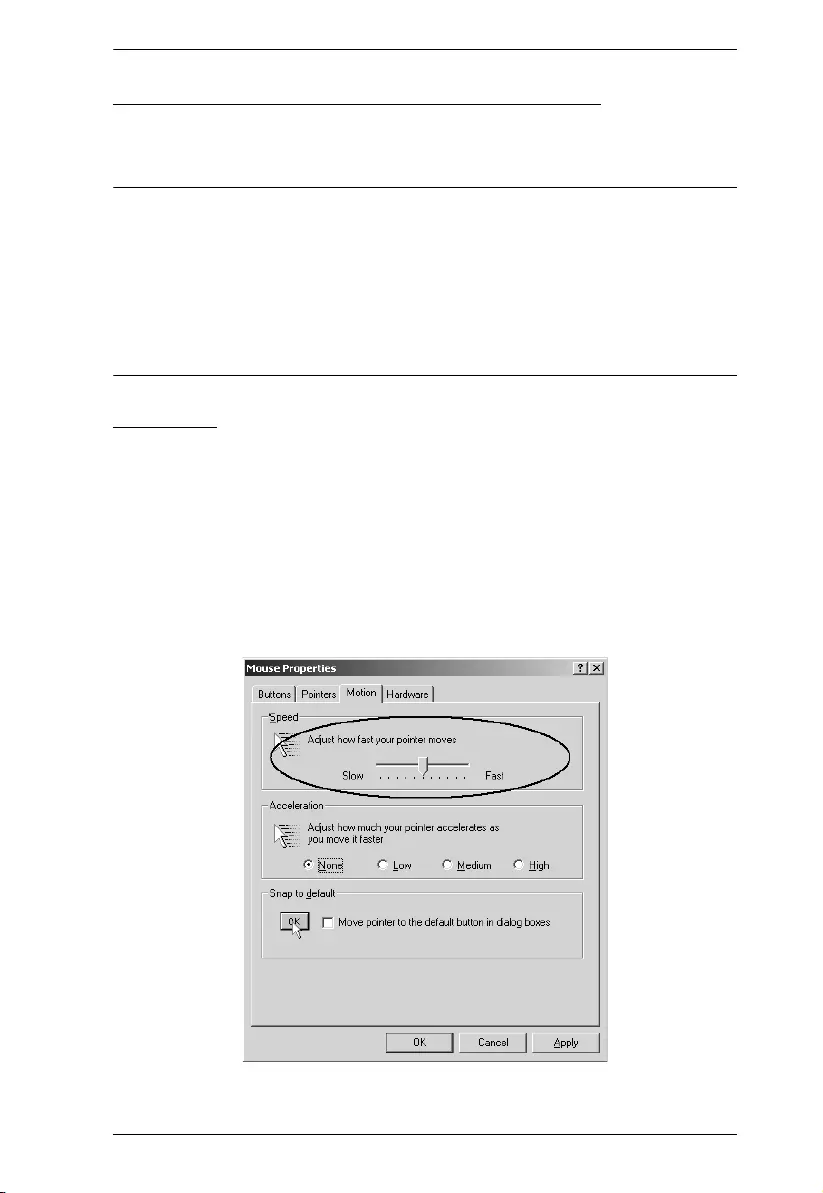
Appendix
221
Additional Mouse Synchronization Procedures
If the mouse synchronization procedures mentioned in the manual fail to
resolve mouse pointer problems for particular computers, try the following:
Note: 1. These procedures are to be performed on the computers attached to
the KL1508Ai / KL1516Ai's ports - not on the computer you are using
to access the KL1508Ai / KL1516Ai.
2. In order for the local and remote mice to synchronize, you must use
the generic mouse driver supplied with the Windows operating
system. If you have a third party driver installed - such as one
supplied by the mouse manufacturer - you must remove it.
Windows:
1. Windows 2000:
a) Open the Mouse Properties dialog box (Control Panel
→
Mouse
→
Mouse Properties)
b) Click the Motion tab
c) Set the mouse speed to the middle position (6 units in from the left)
d) Set the mouse acceleration to None
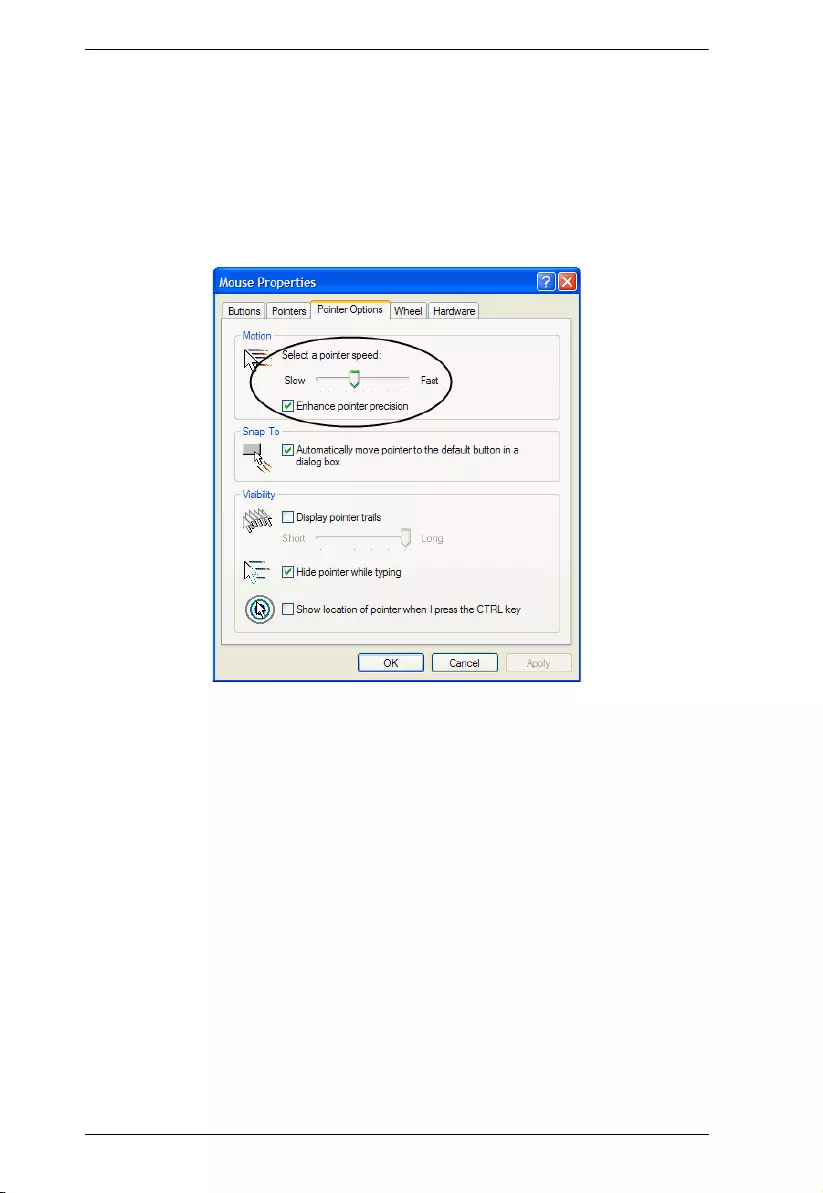
KL1508Ai / KL1516Ai User Manual
222
2. Windows XP / Windows Server 2003:
a) Open the Mouse Properties dialog box (Control Panel
→
Mouse)
b) Click the Pointer Options tab
c) Set the mouse speed to the middle position (6 units in from the left)
d) Disable Enhance Pointer Precision
3. Windows ME:
Set the mouse speed to the middle position; disable mouse acceleration
(click Advanced to get the dialog box for this).
4. Windows NT / Windows 98 / Windows 95:
Set the mouse speed to the slowest position.
Sun / Linux:
Open a terminal session and issue the following command:
Sun:
xset m 1
Linux:
xset m 0

Appendix
223
Connection Tables
The following table indicates the relationship between the number of
compatible KVM Switch units and the number of computers that they control
KL1508Ai
KL1516Ai
No. Computers No. Computers
1 1 - 8 9 65 - 72
29 - 16 10 73 - 80
3 17 - 24 11 81 - 88
425 - 32 12 89 - 96
5 33 - 40 13 97 - 104
641 - 48 14 105 - 112
7 49- 56 15 113 - 120
857 - 64 16 121 - 128
No. Computers No. Computers
1 1 - 16 9 129 - 144
217 - 32 10 145 - 160
3 33 - 48 11 161 - 176
449 - 64 12 177 - 192
5 65 - 80 13 193 - 208
681 - 96 14 209 - 224
7 97- 112 15 225 - 240
8113 - 128 16 241 - 256

KL1508Ai / KL1516Ai User Manual
224
Supported Devices
The following table represents a list of supported devices that can be used on a
KL1508Ai / KL1516Ai installation.
Note: To connect the KL1508Ai / KL1516Ai to a Power Over the
NET™ unit, first use Cat 5e cable to connect the KL1508Ai /
KL1516Ai’s PoN port to an SN0142 adapter; then, connect the
adapter to the PoN In port on the Power Over the NET™ unit.
For a more updated list of supported devices, visit the product
webpage and refer to the Compatible Products / Cables /
Accessories sections at the bottom of the page.
Type
Daisy Chain Switches KH0116, KH1508A; KH1516A; KH1508; KH1516;
ACS1208A; ACS1216A; CS1708A; CS1716A
PoN PN0108
Central Control CC2000
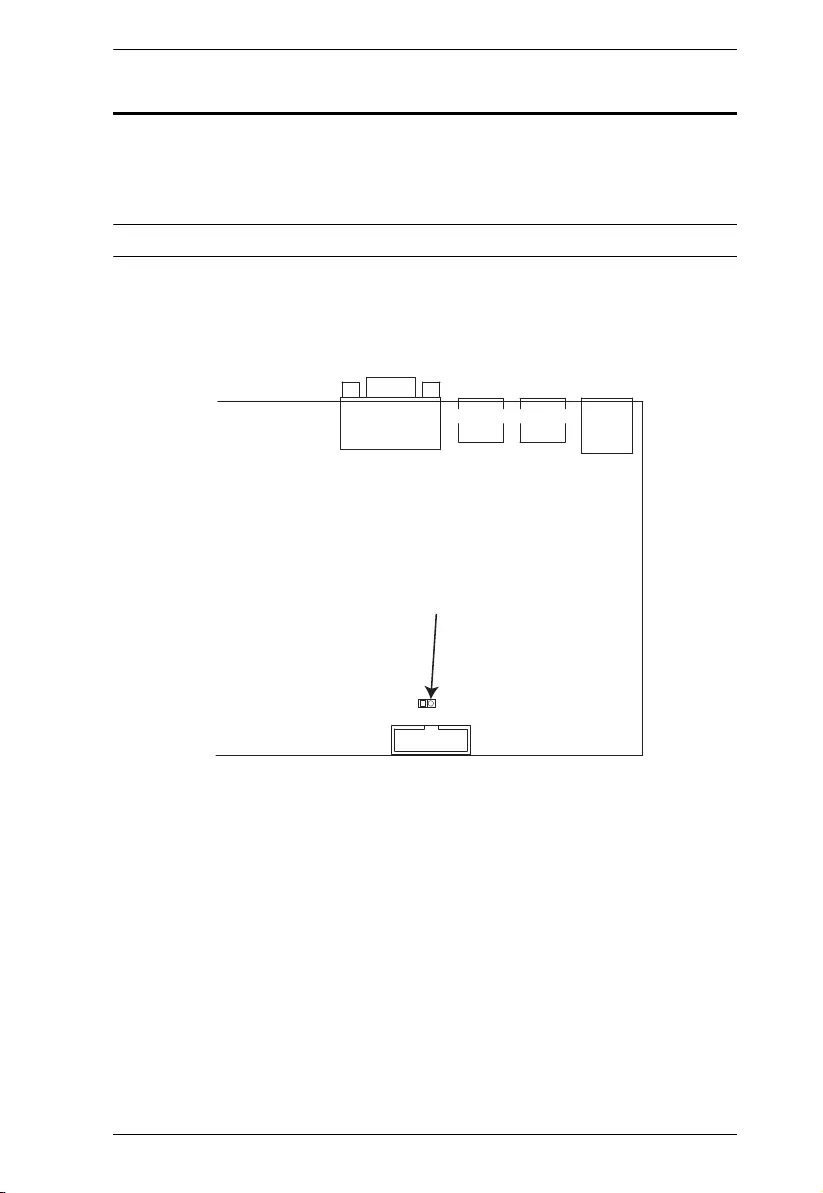
Appendix
225
Clear Login Information
If you are unable to log in as an Administrator (for example, corrupted or
forgotten Username and Password) you can clear the login information with
the following procedure.
Note: Performing this procedure also returns all settings to their defaults.
1. Power off the KL1508Ai / KL1516Ai and remove its housing.
2. Short the jumper labeled J15.
3. Power on the switch.
The on screen display will show a message informing you that the
password information has been cleared.
4. Power off the switch.
5. Remove the jumper cap from J15.
6. Close the housing and start the KL1508Ai / KL1516Ai back up.
After you start back up, you can use the default Username and Password (see
OSD Overview, page 39) to log in.
J15
DEFAULT
PASSWORD

KL1508Ai / KL1516Ai User Manual
226
Dedicated Invocation Keys
Two dedicated keys are provided on the keyboard module to make it easy to
invoke Hotkey Mode and the OSD (as shown in the diagram below):
Note: These keys are toggles. Press once to invoke the feature; press again to
exit.

Appendix
227
OSD Factory Default Settings
The factory default settings are as follows:
Setting Default
OSD Hotkey [Scroll Lock] [Scroll Lock]
Port ID Display Position Upper Left Corner
Port ID Display Duration 3 Seconds
Port ID Display Mode The Port Number plus the Port Name
Scan Duration 5 Seconds
Scan/Skip Mode All
Screen Blanker OFF
Hotkey Command Mode ON
Hotkey [Num Lock] + [-]
Logout Timeout OFF
Beeper ON
OSD Language English

KL1508Ai / KL1516Ai User Manual
228
Limited Warranty
ATEN warrants its hardware in the country of purchase against flaws in
materials and workmanship for a Warranty Period of two [2] years (warranty
period may vary in certain regions/countries) commencing on the date of
original purchase. This warranty period includes the LCD panel of ATEN LCD
KVM switches. Select products are warranted for an additional year (see A+
Warranty for further details). Cables and accessories are not covered by the
Standard Warranty.
What is covered by the Limited Hardware Warranty
ATEN will provide a repair service, without charge, during the Warranty
Period. If a product is detective, ATEN will, at its discretion, have the option
to (1) repair said product with new or repaired components, or (2) replace the
entire product with an identical product or with a similar product which fulfills
the same function as the defective product. Replaced products assume the
warranty of the original product for the remaining period or a period of 90 days,
whichever is longer. When the products or components are replaced, the
replacing articles shall become customer property and the replaced articles
shall become the property of ATEN.
To learn more about our warranty policies, please visit our website:
http://www.aten.com/global/en/legal/policies/warranty-policy/
© Copyright 2021 ATEN® International Co., Ltd.
Released: 2021-05-17
ATEN and the ATEN logo are registered trademarks of ATEN International Co., Ltd. All rights reserved.
All other brand names and trademarks are the registered property of their respective owners.


